John Allore's Blog, page 4
May 30, 2022
Justice muselée
Il y a une photo de l’agent de la Sûreté du Québec, Jacques Filion, regardant dans un sac poubelle de vêtements au dépotoir de ma sœur le matin où elle a été retrouvée, le 13 avril 1979. Roch Gaudreault est avec lui, faisant semblant de regarder dans le sac en plastique. Wish You Were Here a l’agent identifié à tort comme Jacques Lessard, mais c’est Filion, le gars de l’affaire Fecteau. Filion est l’agent qui a récupéré les vêtements de Carole.
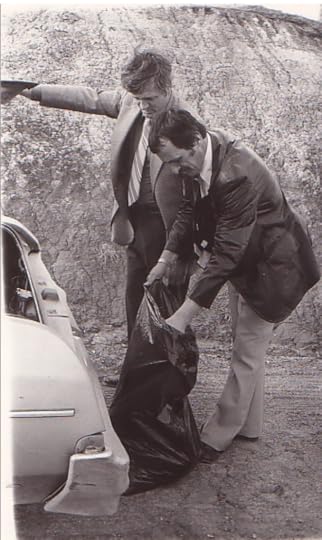 Roch Gaudreault et Jacques Filion
Roch Gaudreault et Jacques FilionIl y a une deuxième photo de ce matin – Vendredi saint 13 avril 1979 – les deux agents debout à côté d’un arbre où gisait le corps de Theresa, faisant semblant d’avoir une conversation. Les photos sont mises en scène ; les détectives ne font vraiment rien, ils n’enquêtent pas vraiment.
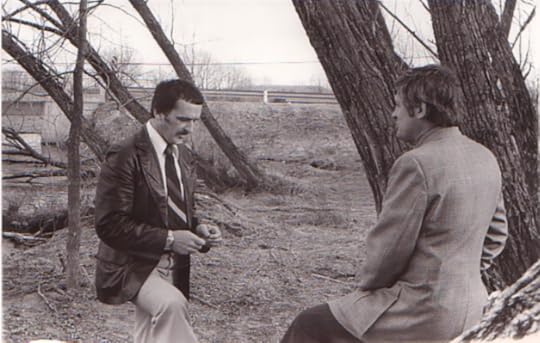 Jacques Filion et Roch Gaudreault
Jacques Filion et Roch GaudreaultIl n’a jamais été déterminé qui portait des vêtements dans ce sac. Ce n’était pas celui de Thérèse. Était-ce celui de Fecteau ? Pas les vêtements qu’elle portait, Filion les a trouvés. Et s’il s’agissait de vêtements laissés à son jeune copain, Marc Charland ? Et si, à peu près au moment où l’agent Réal Châteauneuf avait trouvé cette bûche de bouleau criblée de balles sous l’escalier du sous-sol chez les Charland, vers janvier 1979, son grand frère, Jean, avait remarqué les vêtements dans la chambre de Marc et avait dit à son petit frère : « Hé, tu dois te débarrasser de ce truc, tu as moins de 18 ans, tu ne veux pas que les flics pensent que tu as quelque chose à voir avec son tir.”
Alors Jean Charland a rassemblé toutes les affaires de Fecteau, les a mises dans un sac à ordures et les a abandonnées, mais juste pour rire, juste pour déconner avec la police, il les a jetées sur le site où il a su plus tard ce printemps-là que la neige fondait, ils allaient pour trouver une autre fille morte. Une blague, non ? Parce que Jean Charland savait que la police n’allait pas jouer avec lui, un homme créé. Alors, quand Jacques Filion a regardé dans ce sac poubelle, le vendredi 13 avril 1979, et qu’il a vu ce vêtement, savait-il à ce moment-là, à la veille du procès de Fernand Laplante pour deux meurtres qu’il n’avait pas commis, que la Sûreté du Le Québec manquait la vue d’ensemble? Qu’ils avaient un sérieux problème avec un meurtre sexuel ?
People will hold us to blame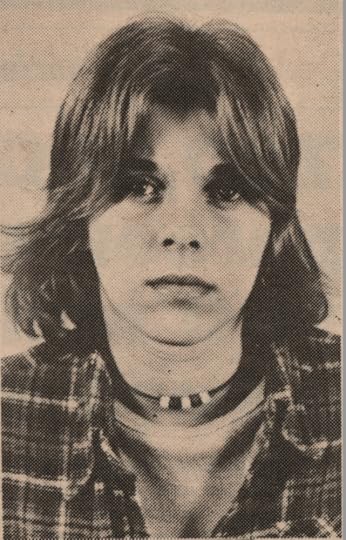 Carole Fecteau
Carole FecteauPremière assassinée, Carole Fecteau sera la dernière à avoir sa journée devant le tribunal. Encore une fois, la police a décidé de faire le procès de Fernand Laplante, et personne d’autre. Encore une fois, Laplante a été assisté par l’avocat de la défense, Jean-Pierre Rancourt, qui a remporté une requête pour déplacer le processus à Cowansville, à environ 100 kilomètres à l’ouest de Sherbrooke, en raison de la publicité excessive lors du premier procès de Laplante. La Couronne était à nouveau représentée par Claude Melancon, et les deux avocats ont accepté d’inclure plusieurs admissions des procès pour meurtre Grimard et Bergeron dans le but d’éviter la redondance et d’accélérer le processus judiciaire – cela allait être un coup de hache rapide.
L’affaire Fecteau s’est ouverte le lundi 19 novembre 1979. Jacques Mongeau a témoigné comment lui et un ami étaient allés pêcher dans un ruisseau près d’East Hereford le 24 juin 1978 et avaient découvert le corps nu d’une jeune femme qui était « blanche, ne respirait pas et semblait avoir des vers qui sortaient de sa peau.” Un employé des travaux publics de la province a alors pris la parole pour dire que le 26 juin, il avait trouvé un portefeuille, « au bord d’une route de gravier », courant vers East Hereford. Avant d’apporter le portefeuille à la police, l’homme a enflammé un arbre avec une hache pour marquer l’endroit où le portefeuille a été trouvé.
 Buck Creek in East Hereford, where Carole Fecteau was found
Buck Creek in East Hereford, where Carole Fecteau was foundUn expert médico-légal a déclaré au tribunal que Fecteau est décédée des suites de deux balles tirées d’une arme de poing, la première étant entrée dans la nuque à une distance d’environ six pieds, tandis que la seconde a pénétré dans son thorax, pénétrant le poumon et le cœur gauches, ce qui a aurait pu être tiré à bout portant. Il n’y avait aucune trace d’alcool dans le corps de Fecteau, et pour une raison quelconque, Fecteau n’a pas été testé pour la drogue. Cet expert a déclaré que Fecteau n’avait pas été sexuellement active 24 heures avant sa mort.
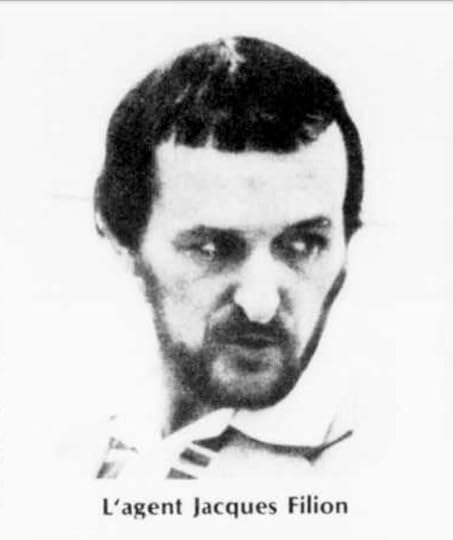 Jacques Filion
Jacques FilionLe photographe de la SQ Guimond Desbiens a témoigné comment il a pris des photos sur les lieux près d’East Hereford et a déclaré qu’il avait été frappé par les tatouages sur son corps, mais ne se souvenait pas avoir remarqué de noms. Michel Poulin, de la SQ, a déclaré avoir pris des photographies aériennes de la scène en janvier et octobre 1979, ainsi qu’une partie du secteur de la rue Wellington à Sherbrooke le 15 novembre.
C’est l’agent de la SQ Jacques Fillion qui s’est finalement retrouvé avec le portefeuille, et il a témoigné que ses vêtements; jeans, sous-vêtements et pull, ont été récupérés le même jour que son poncho déchiré à deux endroits différents sur la même route. À ce moment, Rancourt a demandé si Fillion était au courant que Marc et Jean Charland vivaient dans la région de Lennoxville au moment du crime, Fillion a confirmé qu’il était au courant.
Like any other candidateLe lendemain, The Sherbrooke Record rapportait cette curiosité :
« La majorité du témoignage d’hier dans le cas de Fernand Laplante, accusé de meurtre au premier degré dans la mort de Carole Fecteau à East Hereford le 20 juin 1978, a été consacrée au témoignage et au contre-interrogatoire d’un jeune homme. La presse notamment que envoyés par The Record s’interdisaient de mentionner son nom, son adresse, son âge, sa profession, ainsi que le prénom de son frère. Le juge Jean Louis Péloquin a également imposé d’autres restrictions concernant son témoignage.
“Judge sets press rules”, John McCaghey, Sherbrooke Record, November 22, 1979, page 3
L’absence du principal journal français des Cantons, La Tribune, était tellement perceptible qu’elle a été dénoncée par la sœur des Cantons, la publication anglaise The Record. En fait, La Tribune a été portée disparue pendant les six premiers jours du procès. Le “jeune homme” que les tribunaux essayaient de “protéger” était plutôt évidemment le petit ami de Carole Fecteau, Marc Charland, et le prénom de son frère était Jean. Cependant, n’ayant pas été présent, La Tribune n’a jamais entendu l’interdiction de publication du tribunal, et a donc procédé à exposer le nom “Charland” tout au long de leurs reportages ultérieurs :
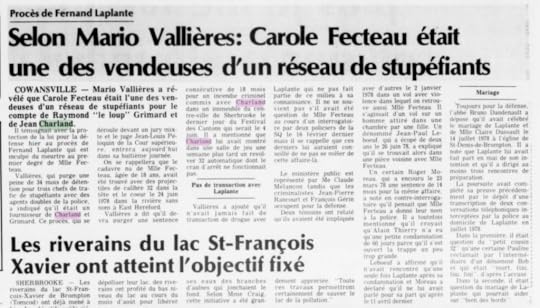
Sous la protection de la cour, le témoignage de Marc Charland était essentiellement une mini-version de l’histoire de Jean Charland dans le procès Grimard et Bergeron : il blâmait Fernand Laplante pour le meurtre de Carole Fecteau. Marc Charland a affirmé que Laplante lui avait dit un jour que Fecteau «était une garce et devait mourir». Puis le 20 juin 1978, le soir de la disparition de Fecteau, selon Charland, Laplante confie à nouveau que Fecteau « est morte, que son cas est réglé et qu’il l’a mise dans un ruisseau ». Apparemment, Fernand Laplante n’arrêtait pas de parler de Fecteau puisque le 21 juin dernier, Laplante, 34 ans, confiait encore à ce garçon de moins de 18 ans que Fecteau « avait des balles dans la tête et dans le cœur parce qu’elle avait envoyé deux mecs en prison ». En contre-interrogatoire, Marc Charland a atténué sa déclaration et a dit qu’il avait peut-être mal interprété les propos de Laplante. Le témoignage de Marc Charland était la principale preuve utilisée par la Couronne pour poursuivre Laplante.
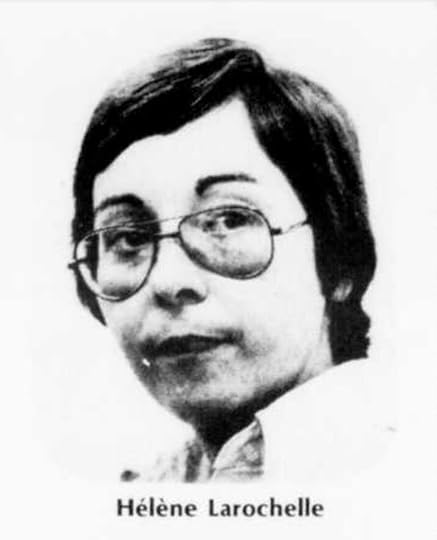 Helen Larochelle
Helen LarochelleLe ministère public a ramené la colocataire de Fecteau, Hélène Larochelle, et en contre-interrogatoire, Jean Pierre Rancourt lui a fait admettre que peu de temps avant la disparition de Carole, le ou vers le 20 juin 1978, leur appartement a été visité par « deux frères qui doivent rester anonymes », mais que nous connaissons maintenant étaient Marc et Jean Charland. Fecteau a eu une dernière conversation téléphonique avec Johanne Tanguay à deux reprises, avant de quitter l’appartement vers 20h00 et de se diriger vers la rue Wellington.
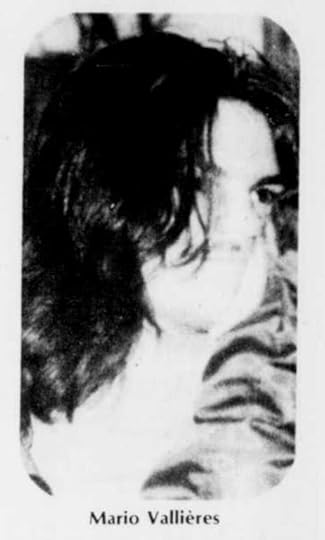 Mario Vallieres
Mario VallieresMario Vallières a également répété le témoignage qu’il avait été reconnu coupable d’une accusation d’incendie criminel “avec le frère du témoin anonyme” (Encore une fois, Jean Charland – il avait été nommé par Vallières pour cet incident seulement six mois plus tôt). Ça devient plus juteux, apparemment Charland avait vécu dans l’appartement qu’ils ont incendié le 4 juin, je suppose qu’il ne voulait plus payer de loyer.
Ce que Mario Vallieres a alors fourni était une fenêtre sur le monde souterrain de la région de Wellington à la fin des années 1970. Il a dit qu’il était actif dans le trafic de drogue à Sherbrooke, vendant à la fois à Jean Charland et à Raymond « Ti Loup » Grimard. Selon Vallières, Grimard vendait de la drogue à des filles comme Carole Fecteau. Il a dit que les principaux endroits où la drogue était poussée au centre-ville de Sherbrooke comprenaient le Moulin Rouge, La Petite Bouffe, la salle de billard de Sinclair, le bar des Marches du Palais, l’hôtel Queen’s et un établissement d’amusement (machines à sous / poker).
Vallières a alors dit avoir vu Jean Charland avec une arme de poing de calibre 32, capable de tirer huit coups. Il ne pouvait pas discerner s’il s’agissait d’une automatique ou d’une semi-automatique. Il a placé le moment où il avait vu l’arme à feu une semaine après l’incendie criminel de la rue Wellington, qui, selon lui, s’était déroulé la nuit des Festivals des Cantons, au début de juin 1978. À la barre, Vallières a refusé de nommer d’autres personnes qui ont vendu drogues dans la région, “Certains d’entre eux ont travaillé pour moi et je ne veux pas les identifier.” Vallières a noté qu’il n’avait jamais fait de transaction de drogue avec Fernand Laplante car il ne faisait pas, à sa connaissance, partie du milieu du crime dans la région de King et Wellington.
Encore une fois, comme ce fut le cas avec le procès Grimard / Bergeron, la plupart des preuves semblaient pointer vers Jean Charland et son frère Marc, et non Laplante. Jean Charland avait une arme de poing. Bien que les policiers aient trouvé des munitions à l’appartement de Laplante, ils n’ont jamais pu récupérer une arme le liant au meurtre de Fecteau. Laplante ne faisait pas partie du milieu de Wellington, Jean Charland avait vécu à quelques blocs de l’appartement de Fecteau et il était l’un des fournisseurs de médicaments de Fecteau. Jean et Marc Charland étaient deux des dernières personnes vues avec Fecteau dans son appartement de Sanborn. Marc Charland était le petit ami de Fecteau, tandis que Laplante semblait n’avoir aucun motif de la tuer, à moins qu’il ne s’agisse d’un contrat. Enfin, Fernand Laplante ne m’apparaît pas comme un type à la gueule de bavard, bien qu’il y ait eu beaucoup de témoignages de témoins lui mettant des mots dans la bouche (Régis Lachance, et la remarque « Grimard et sa chienne »). Mais Laplante a purgé 40 ans de prison et n’a jamais parlé. Jean Charland par contre…
Daniel « Le Chat » Bussières a témoigné avoir appris la mort de Carole Fecteau par Jean Charland alors que les deux jouaient un partie de snooker au Salle de billard Sinclair:
« Nous avons quitté la salle de billard et nous nous sommes déplacés d’environ 500 pieds jusqu’au Moulin Rouge. J’ai vu Fernand Laplante assis au bar et mon compagnon (Charland) et moi sommes allés… m’asseoir à une table près de la scène.”
“Laplante ‘Surprised’ At Death”, John McCaghey, The Sherbrooke Record, November 29, 1979, page 3
À ce moment-là, Jean Charland se vante à nouveau de Fecteau en leur disant à tous les deux : « elle est bien et elle y sera gelée tout l’hiver ». Bussières a déclaré: «J’ai demandé ce qui s’était passé car je l’avais vue avec Raymond «Ti Loup» Grimard la nuit précédente et sa réponse a été «Attendez et voyez; tu le sauras. »
Quelques jours plus tard, Bussières a rencontré Jean Charland, et cette fois Charland lui a dit de se taire : « Je l’ai fait. parce que vous pouvez avoir des ennuis avec la foule si vous parlez.” Bussières a déclaré à la cour : « La dernière fois que j’ai vu (Fecteau) vivante, c’était lorsqu’elle était avec Ti-Loup Grimard le 20 juin 1978. » Bussières répéta alors la règle populaire du silence dans les crimes qui pourraient impliquer d’autres. Mais Jean Charland n’arrêtait pas de parler, suggérant finalement que Carole Fecteau “avait été tuée par la bande des Grimard à la suite d’une faute dans un deal de drogue : a été violée ».
« Justice est bien rendue »Dans sa plaidoirie finale, Jean-Pierre Rancourt a demandé au jury d’acquitter Fernand Laplante au motif qu’il était improbable que son client ait assassiné Carole Fecteau. Il mentionne que le soir du 20 juin 1978, sa colocataire, Hélène Larochelle, a observé Fecteau quittant leur appartement vers 20 h. pour une mystérieuse réunion sur la rue Wellington. Fecteau a ensuite été aperçu par « Le Chat » Bussières dans la Cadillac de « Ti-Loup » Grimard dans la région de Wellington. Rancourt nota que ce même soir Fernand Laplante n’était pas à Sherbrooke, il était à Lennoxville, faisant des travaux de soudure pour un garagiste. Rancourt a déclaré au jury que «personne ne serait assez fou pour dire à un garçon qu’il avait tué sa petite amie», comme Marc Charland a affirmé que Laplante l’avait fait. En fait, la première personne à mentionner le meurtre de Fecteau est le frère de Marc, Jean, lorsqu’il dit à Bussières “elle est bien et qu’elle y sera gelée tout l’hiver”, le lendemain du meurtre du 21 juin. Rancourt a exprimé son opinion que Fecteau était victime d’un trafic de drogue dans lequel elle était impliquée et auquel son client était étranger. Il a conclu en disant que le jury n’avait pas à découvrir qui avait tué Fecteau, mais à décider s’il s’agissait ou non de Laplante.
Le 5 décembre 1979, Fernand Laplante est acquitté du meurtre de Carol Fecteau. Laplante a éclaté en sanglots et a dit : « Justice est bien rendue ». Il retournerait en prison pour une peine de trois ans pour le vol à main armée à Montréal, et sa peine à perpétuité pour les meurtres au premier degré de Raymond Grimard et Manon Bergeron. Bravo en effet.
“Une cause que j’ai encore sur le coeur”Ce n’était peut-être pas le travail du jury de déterminer qui a tué Carole Fecteau, mais c’était le travail de quelqu’un – je vais prendre des risques ici et suggérer hardiment que c’était le travail de la police. Le procureur de la Couronne Claude Melancon a fait semblant de vouloir réessayer Laplante, mais cela a trop échoué. Le meurtre de Fecteau est resté définitivement non résolu.
«Laplante m’avait répété qu’il était innocent dans l’affaire (Grimard et Bergeron). Il n’avait pas fait de telles affirmations pour le meurtre de Carole Fecteau.”
“Me Jean-Pierre Rancourt: Les Confessions d’un Criminaliste”, Bernard Tetrault, Stanke, 2015, Page 60
Pourquoi Fernand Laplante a-t-il épousé Claire Dussault en juillet 1978 ? C’était une question de privilège conjugal, de sorte que Dussault ne pouvait pas témoigner contre son mari. C’était un vieux truc. Laplante avait été un complice criminel avec Gaston « Moustache » Brochu, un Gitan, les deux appartenaient à un équipage spécialisé dans les B&E, ils étaient responsables de centaines de braquages à Sherbrooke et dans les Cantons. Lorsque la justice a rattrapé Brochu, il a tenté d’épouser Christiane Boivin avant toute poursuite pénale.
Rappelons maintenant que Fernand Laplante a aussi connu Régis Lachance – comme Brochu, ils ont peut-être aussi été des complices criminels, et ils ont parlé « d’affaires » à l’été 1978 alors que Régis se tenait debout sur le balcon de son appartement de la rue LaRocque. Régis a également épousé l’une de ses femmes à la hâte. Regis a épousé Denise Corbin le 27 octobre 1978, un vendredi – ce qui est curieux, pourquoi ne pas attendre jusqu’à samedi pour que toute la famille puisse faire la fête de l’occasion ? – mais non, Régis s’est marié le vendredi 27 octobre 1978, exactement une semaine avant la disparition de Theresa Allore, et deux semaines avant l’incendie de l’Aloha Motel. Donc, cette astuce de mariage semble avoir été transmise con à con.
À noter que lorsque le coroner Jean-Pierre Rivard a rendu son verdict le 16 octobre 1978 tenant Fernand Laplante criminellement responsable de la mort violente de Carole Fecteau, il a nommé Claire Dussault également complice du meurtre :
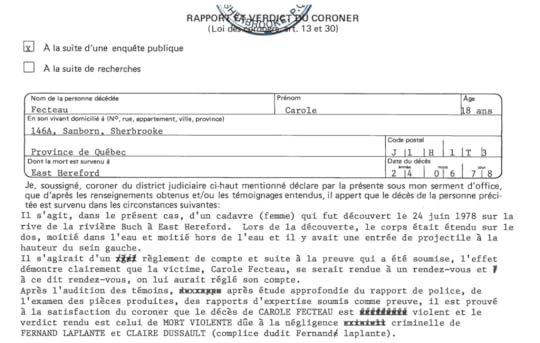
En fait, Dussault devait également être jugé pour le meurtre de Fecteau, mais ce processus a échoué. De plus, Dussault a été appelé à témoigner procès pour meurtre de Fecteau, mais elle était absente.
À l’été 1978, la Sûreté du Québec a mis sur écoute légale le téléphone de Laplante dans son appartement du Belvédère. Au procès, la poursuite avait déposé en preuve une transcription de deux conversations téléphoniques interceptées par les policiers au domicile de Laplante. Dans le premier, Laplante a parlé de son récent mariage et de la façon dont cela pourrait aider « à bien des égards ». Dans le second, la conversation téléphonique faisait référence à quelqu’un appelé “petit cousin 32” qui était “mort”. fini, fini, fini ».
“Petit Cousin” est un terme familier, il peut signifier beaucoup de choses. Mais il faut mentionner que Carole Fecteau était la petite cousine de Denise Côté, l’épouse de Gérald Lachance. Et Gérald était le frère de Régis Lachance.
Le double événement d’East HerefordLe vendredi après-midi 2 septembre 1977, au début de la fin de semaine de la fête du Travail, quelqu’un a tiré sur Monique Marchand, 37 ans, commis d’une boucherie et mère de trois enfants, alors qu’elle travaillait au comptoir de son magasin à East Hereford. Le bandit solitaire a cambriolé l’abattoir Fernand Marchand, ne saisissant qu’une poignée d’argent dans la caisse, et s’est enfui dans une Camaro rouge et noire en attente avec des plaques d’immatriculation américaines, retrouvée plus tard abandonnée sur une route secondaire. Le marché était situé à 2 1/2 milles au sud d’East Hereford, le long de la route menant au passage frontalier de Beecher Falls, dans le Vermont. Madame Marchand était seule dans la devanture lorsque l’incident s’est produit, mais son beau-père, Johnny Marchand, était dans l’arrière-boutique. Il a dit avoir entendu un coup de feu et lorsqu’il s’est approché du front, il a vu un homme debout près de la caisse, l’arme pointée sur sa belle-fille. Madame Marchand était sur le point de lancer une viande intelligente sur l’homme, à quel point il lui a tiré une balle dans la tête.
Ce qui est curieux à propos de ce vol de magasin familial à Nowheresville, Québec, c’est que l’enquête était dirigée par nul autre que Roch Gaudreault de la SQ de Sherbrooke, à près de 60 kilomètres. On se demande pourquoi quelqu’un comme Jacques Filion n’a pas pris en charge le détachement beaucoup plus proche de Coaticook. La première action de Gaudreault a été de mettre en place des barrages routiers, ce qui vous dit que presque immédiatement, la police n’a pas pensé qu’elle cherchait un local.
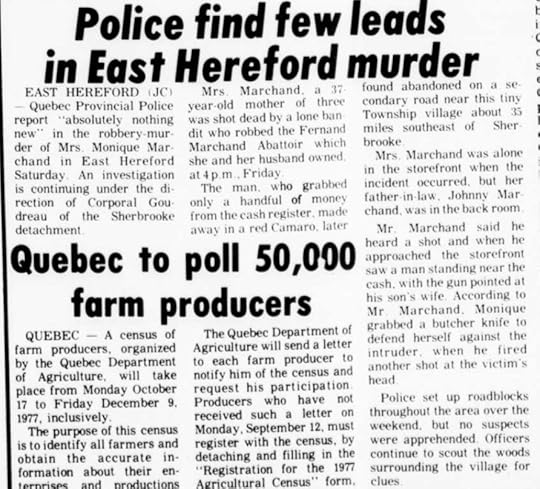
Lundi, la police avait arrêté Michel Belley, et lorsque l’histoire a éclaté dans la Montréal Gazette selon laquelle le criminel notoire – Belley avait commis une série de vols de Québec à Toronto en passant par Kansas City – avait été appréhendé, la Sûreté du Québec de Sherbrooke l’a appelé, « pur fantasme, Michel Belley n’est absolument pas détenu à cette fin. Ces journalistes nuisent beaucoup plus à l’enquête qu’ils ne peuvent l’aider en faisant de telles déclarations.”
Néanmoins, à la fin de la fin de semaine fériée, 72 heures époustouflantes après la fusillade de Marchant, le caporal Roch Gaudreault et le constable Noël Bolduc, du Bureau des enquêtes criminelles de la SQ, ainsi que le coroner Jean-Pierre Rivard, « font savoir qu’ils étaient certains d’avoir résolu le meurtre d’East Hereford », malgré le fait que la seule preuve contre Belley était qu’il avait autrefois vécu à Sherbrooke.
Belley a été acquitté deux fois pour le meurtre. La première occasion due au “témoignage non corroboré d’un complice”. En cour, il a été révélé que le caporal Roch Gaudreault avait fabriqué des preuves afin d’incriminer Belley. Plus précisément, Gaudreault a écrit deux déclarations fictives puis a falsifié la signature de Michel Belley sur les documents. Les documents auraient impliqué le complice dans le meurtre, dans le but d’amener ensuite ce complice à, à son tour, blâmer Belley pour le meurtre. L’associé de Gaudreault, Noel Bolduc a préparé les documents, puis Gaudreault les a signés.
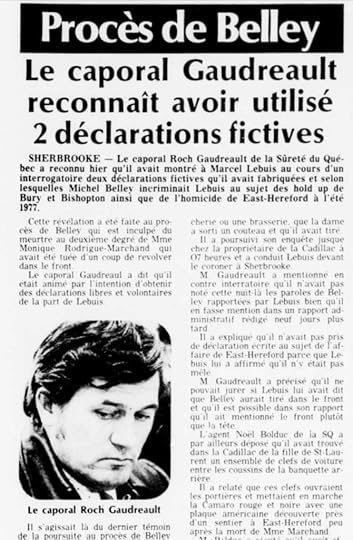
On a donc là une fabrication de preuves, et une collusion policière d’une manière identique à ce que l’agent de la SQ Réal Châteauneuf a décrit dans le procès Laplante (“C’est une des ruses habituellement utilisées.” ), et utilisée pour amener Jean Charland à incriminer Fernand Laplante . Ce n’était donc pas une indiscrétion ponctuelle, c’était une pratique systémique de la Sûreté du Québec. La police utilise ce que Bob Beullac a appelé des « raccourcis » ; mais ce n’est pas un jeu, des vies étaient en jeu lorsque la police a joué vite et librement avec la loi.
À la deuxième occasion, un expert a déterminé qu’il était physiquement impossible pour Belley d’avoir conduit d’East Hereford à l’endroit où il a ensuite été repéré ce soir-là à Montréal dans le temps imparti, «même un champion de course automobile aurait été incapable de surmonter la distance. “, il a dit. En 1985, Belley a simplement abandonné et a plaidé coupable, j’imagine avoir choisi de purger sa peine plutôt que de subir d’autres absurdités du processus judiciaire québécois.
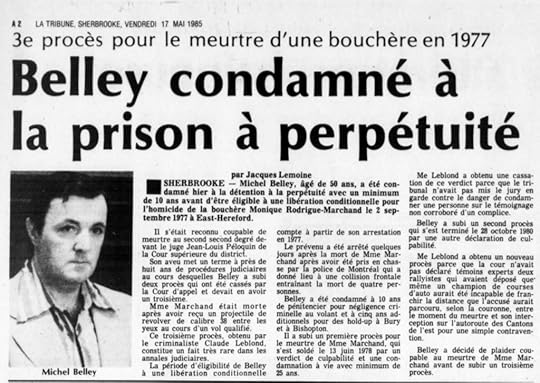 “Elle s’est bien débrouillée avant d’être tuée”
“Elle s’est bien débrouillée avant d’être tuée”Pourquoi quelqu’un va-t-il à East Hereford ? Pour la même raison que vous prenez un bateau sur les eaux internationales du lac Memphrémagog, c’est une ville frontalière, c’est un port ou une entrée pour les voitures et les drogues et les armes à feu, ou les drogues et les armes à feu dans les voitures, si vous préférez – smuggling. Celui qui a braqué le boucher en 1977 – et ce n’était pas Michel Belley – avait plus en tête que la main vide de sens l d’argent qu’ils ont saisi de la caisse enregistreuse. Et ce Camero abandonné ? Eh bien, l’agresseur n’est pas simplement sorti d’East Hereford, il y avait plus d’une personne impliquée et il y avait deux voitures.
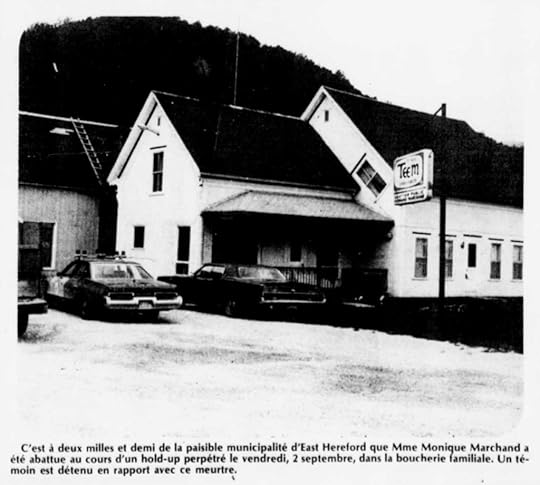 Fernand Marchand Abattoir – East Hereford
Fernand Marchand Abattoir – East HerefordNous avons mentionné que même l’avocat Rancourt soupçonnait Laplante d’avoir participé au meurtre de Fecteau, et que Laplante était de Coaticook, à seulement 25 kilomètres à l’ouest d’East Hereford à vol d’oiseau. Or, pendant un certain temps, Fernand Laplante avait travaillé comme ouvrier agricole sur le terrain où le corps de Carole Fecteau a été découvert, Buck Creek. Cela n’est jamais sorti au procès, mais on croit que la raison pour laquelle la Couronne a voulu appeler Claire Dussault à la barre était de témoigner que le soir du meurtre de Fecteau, Fernand Laplante ne faisait pas de soudure dans un garage de Lennoxville, mais était en fait dans la région de Coaticook famille en visite.
Cela rend Fernand Laplante probable comme l’un des assaillants de Fecteau, mais pas tous. Comme pour la fusillade de Monique Marchand et les meurtres de Grimard et Bergeron – où Jean Pierre Rancourt a suggéré qu’il y en avait jusqu’à quatre – il y avait plus d’une personne impliquée dans le meurtre de Carole Fecteau.
Que penser du témoignage de Daniel “Le Chat” Bussières selon lequel Jean Charland a déclaré que Fecteau “avait bien essayé avant d’être tuée” ? Pour un viol collectif, il faut un gang. Et tant pis pour l'”expert” médico-légal, qui a témoigné que Fecteau n’avait pas été sexuellement active avant sa mort. Comme Jean-Claude Bernheim l’avait dit à plusieurs reprises, des « experts » mentent sur ces choses pour étayer un récit policier. Ils mentent ou ils n’ont pas compris (ils ne comprennent pas) tout l’arsenal d’opportunités à la disposition d’un délinquant par rapport aux femmes lorsqu’il envisage la nature du viol.
Donc, oui, quelqu’un dans ce parti a peut-être voulu que Fecteau soit tué parce qu’elle avait une grande gueule, ou qu’elle a foiré un deal de drogue, mais quelqu’un d’autre – ou d’autres personnes – dans ce parti voulait autre chose, quelque chose en plus de la faire tuer . Parce que s’il s’agit d’un simple contrat de meurtre, vous ne déshabillez pas le corps. Si ce n’est qu’un meurtre pour compte, tu la laisserais comme ils ont laissé Manon Bergeron, habillée. Vous ne jetez pas de preuves le long d’une route de gravier, comme les vêtements et un portefeuille, comme ils l’ont fait avec Theresa Allore. Quelqu’un – ou d’autres – dans ce groupe n’était pas seulement un tueur à gages. Ils étaient aussi un meurtrier sexuel.
May 27, 2022
Muzzled Justice
There’s a photo of Surete du Quebec agent, Jacques Filion staring into a garbage bag of clothing at my sister’s dump site the morning she was found, April 13, 1979. Roch Gaudreault is with him, pretending to gaze into the plastic bag. Wish You Were Here has the agent misidentified as Jacques Lessard, but it’s Filion, the guy from Fecteau’s case. Filion was the agent who recovered Carole’s clothing.
 Roch Gaudreault et Jacques Filion
Roch Gaudreault et Jacques FilionThere’s a second photo from that morning – Good Friday, April 13, 1979 – the two agents standing next to a tree where Theresa’s body lay, pretending to have a conversation. The photos are staged; the detectives aren’t really doing anything, they’re not really investigating.
 Jacques Filion et Roch Gaudreault
Jacques Filion et Roch GaudreaultIt was never determined who’s clothing was in that bag. It wasn’t Theresa’s. Was it Fecteau’s? Not the clothes she was wearing, Filion found those. But what if it was clothing left with her young boyfriend, Marc Charland? What if, around the time that agent Real Chateauneuf found that bullet-riddled birch log under the basement stairs at the Charland’s, around January, 1979, his big brother, Jean noticed the clothing in Marc’s room and told his little brother, “Hey, you gotta get rid of that stuff, you’re under 18, you don’t want the cops thinking you had anything to do with her shooting.”
So Jean Charland gathered all Fecteau’s stuff, put in a garbage bag and ditched it, but just for a laugh, just to screw around with police, he tossed it at the site where he knew later that spring when the snow melted, they were going to find another dead girl. Some joke, right? Because Jean Charland knew the police weren’t going to mess with him, a made man. So when Jacques Filion looked into that garbage bag, Good Friday, April 13, 1979, and he saw that clothing, did he know at that moment, on the eve of Fernand Laplante’s trial for two murders he did not commit, that the Surete du Quebec was missing the big picture? That they had a serious problem on their hands with sexual murder?
People will hold us to blame Carole Fecteau
Carole FecteauThe first to be murdered, Carole Fecteau would be the last to have her day in court. Once again, police decided to put Fernand Laplante on trial, and no one else. Once again, Laplante was assisted by defense attorney, Jean-Pierre Rancourt, who won a motion to move the process to Cowansville, about 100 kilometers west of Sherbrooke, due to excessive publicity during Laplante’s first trial. The Crown was represented again by Claude Melancon, and both attorneys agreed to include several admissions from the Grimard and Bergeron murder trials in an effort to avoid redundancy and speed the judicial process – this was going to be a swift hatchet-job.
Fecteau’s affair opened on Monday, November 19, 1979. Jacques Mongeau testified how he and a friend had gone fishing in a stream near East Hereford on June 24, 1978, and discovered the nude body of a young woman who was “white, not breathing and appeared to have worms coming out of her skin.” A provincial public works employee then took the stand to say on June 26 he found a wallet, “at the side of a gravel road”, running toward East Hereford. Before taking the wallet to police, the man blazed a tree with an axe to mark the location where the wallet was found.
 Buck Creek in East Hereford, where Carole Fecteau was found
Buck Creek in East Hereford, where Carole Fecteau was foundA forensic expert told the court that Fecteau died from two bullets shot from a handgun, the first having entered at the nape of the neck at a distance of about six feet, while the second entered her thorax, penetrating the left lung and heart, which could have been fired from point blank range. There were no traces of alcohol in Fecteau’s body, and for some reason, Fecteau was not tested for drugs. This expert stated Fecteau had not been sexually active 24 hours prior to her death.
 Jacques Filion
Jacques FilionSQ photographer Guimond Desbiens testified how he took photographs at the scene near East Hereford, and said he was struck by the tattoos on her body, but could not recall noticing any names. The SQ’s Michel Poulin said he took aerial photographs of the scene in January and October of 1979, as well as some of the Wellington Street area of Sherbrooke on November 15.
It was SQ agent Jacques Fillion who eventually ended up with the wallet, and he testified that her clothing; jeans, underwear and sweater, were recovered the same day as her torn poncho at two different points on the same road. At this point, Rancourt asked if Fillion was aware that Marc and Jean Charland lived in the Lennoxville area at the time of the crime, Fillion confirmed that he was aware.
Like any other candidateThe next day, The Sherbrooke Record reported this curiosity:
“The majority of yesterday’s testimony in the case of Fernand Laplante, charged with first degree murder in the death of Carole Fecteau at East Hereford on June 20, 1978, was devoted to the testimony and cross examination of a young male. The press notably only represented by The Record were forbidden to mention his name, address, age, occupation, as well as the Christian name of his brother. Justice Jean Louis Peloquin also imposed other restrictions concerning his testimony.”
“Judge sets press rules”, John McCaghey, Sherbrooke Record, November 22, 1979, page 3
The absence of the Townships major French newspaper, La Tribune was so noticeable, it was called out by the Townships sister, English publication The Record. In fact, La Tribune was missing for the first six days of the trial. The “young male” the courts were trying to “protect” was rather obviously Carole Fecteau’s boyfriend, Marc Charland, and the Christian name of his brother was Jean. However, having not been present, La Tribune never heard the court’s publication ban, and so proceed to expose the name “Charland” all through their subsequent reporting:

Under the court’s protection, Marc Charland’s testimony was essentially a mini-version of Jean Charland’s story in the Grimard and Bergeron trial: he blamed Fernand Laplante for the murder of Carole Fecteau. Marc Charland claimed that Laplante once told him Fecteau “was a bitch and had to die”. Then on June 20, 1978, the night of Fecteau’s disappearance, according to Charland, Laplante again confided that Fecteau “was dead, that her case was settled and that he had put her in a creek.” Apparently Fernand Laplante couldn’t stop talking about Fecteau because on June 21, 34-year-old Laplante again confided to this boy under the age of 18 that Fecteau “had bullets in her head and heart because she sent two guys to jail.” Under cross-examination, Marc Charland toned down his statement and said he may have misinterpreted Laplante’s remarks. Marc Charland’s testimony was the chief evidence used by the Crown to prosecute Laplante.
 Helen Larochelle
Helen LarochelleThe Crown brought back Fecteau’s roommate, Helen Larochelle, and under cross examination, Jean Pierre Rancourt got her to admit that shortly before Carole’s disappearance on or around June 20, 1978, their apartment was visited by “two brothers who must remain anonymous”, but who we know now were Marc and Jean Charland. Fecteau last talked on the phone twice to Johanne Tanguay, before departing the apartment around 8:00 p.m., and heading for Wellington Street.
Mario Vallieres also repeated testimony that he had been convicted of an arson charge “with the brother of the anonymous witness” (Once again, Jean Charland – he had been named by Vallieres for this incident only six months earlier). It gets juicier, apparently Charland had lived in the apartment they burned down on in June 4, I guess he no longer wanted to pay rent.
 Mario Vallieres
Mario VallieresWhat Mario Vallieres then provided was a window into the underworld of the Wellington area in the late 1970s. He said that he was active in the drug trade in Sherbrooke, selling to both Jean Charland and Raymond “Ti Loup” Grimard. According to Vallieres, Grimard sold drugs to girls like Carole Fecteau. He said the main areas where drugs were pushed in downtown Sherbrooke included the Moulin Rouge. La Petit Bouffe. Sinclair’s Pool Room, the bar at Les Marches du Palais, the Queen’s Hotel and an amusement establishment (slots, pinball).
Vallieres then said he had seen Jean Charland with a 32-calibre handgun, capable of firing eight shots. He could not discern whether it was an automatic or a semi automatic. He placed the time he had seen the gun as being a week after the arson on Wellington St., which he said was set on the night of Festivals des Cantons, in early June 1978. On the stand, Vallieres refused to name others who sold drugs in the area, “Some of them worked for me and I don’t want to identify them.” Vallieres noted that he never made a drug transaction with Fernand Laplante as he was not, to his knowledge, part of the crime milieu in the King and Wellington area.
Again, as was the case with the Grimard / Bergeron trial, most of the evidence, appeared to be pointing to Jean Charland and his brother Marc, not Laplante. Jean Charland had a handgun. Though police found ammunition at Laplante’s apartment, they were never able to recover a weapon linking him to Fecteau’s murder. Laplante was not part of the Wellington milieu, Jean Charland had lived within blocks of Fecteau’s apartment, and he was one of Fecteau’s drug suppliers. Jean and Marc Charland were two of the last persons seen with Fecteau at her apartment on Sanborn. Marc Charland was Fecteau’s boyfriend, whereas Laplante appeared to have no motive for killing her, unless it was a contract hit. Finally, Fernand Laplante does not strike me as a guy with a blabber-mouth, though there was a lot of testimony of witnesses putting words in his mouth (Regis Lachance, and the “Grimard and his bitch” remark). But Laplante served 40 years in prison and never talked. Jean Charland on the other hand…
Daniel “Le Chat” Bussières testified that he learned of Carole Fecteau’s death from Jean Charland while the two were playing a game of snooker at the Sinclair Pool Hall:
“We left the poolroom and moved about 500 feet to the Moulin Rouge. I saw Fernand Laplante sitting at the bar and my companion (Charland) and I went to… sit at a table near the stage.”
“Laplante ‘Surprised’ At Death”, John McCaghey, The Sherbrooke Record, November 29, 1979, page 3
At this point, Jean Charland bragged about Fecteau again, telling both of them, “she’s well off and she’ll be frozen there all winter.” Bussières said, “I asked what happened as I had seen her with Raymond “Ti Loup” Grimard the night prior and his answer was “Wait and see; you’ll find out.””
Several days later, Bussières met up with Jean Charland, and this time Charland told him to shut up, “I did. because you can get into trouble with the mob if you talk.” Bussières told the court, “The last time I saw (Fecteau) alive was when she was with Ti-Loup Grimard on June 20, 1978.” Bussières then repeated the mob rule on silence in crimes which might implicate others. But Jean Charland couldn’t stop talking, finally suggesting that Carole Fecteau had been slain by the Grimard gang as a result of a foul up in a drug deal: “He told me she had a good go before she was killed and l presume she was raped.”
“Justice is well done”In his closing arguments, Jean-Pierre Rancourt asked the jury to acquit Fernand Laplante on the grounds that it was improbable that his client murdered Carole Fecteau. He mentioned that on the evening of June 20, 1978, her roommate, Hélène Larochelle observed Fecteau leaving their apartment around 8:00 p.m. for a mysterious meeting on Wellington Street. Fecteau was later seen by “Le Chat” Bussières in the Cadillac of “Ti-Loup” Grimard in the Wellington area. Rancourt noted that that same evening Fernand Laplante was not in Sherbrooke, he was in Lennoxville, doing some welding work for a garage owner. Rancourt told the jury that “no one would be crazy enough to tell a boy that he had killed his girlfriend”, as Marc Charland claimed Laplante had done. In fact the first person to mention Fecteau’s murder was Marc’s brother, Jean, when he told Bussières “she’s well off and she’ll be frozen there all winter”, the day after the murder on June 21. Rancourt expressed his opinion that Fecteau was the victim of a drug deal in which she was involved, and to which his client was a stranger. He concluded by saying that the jury did not have to find out who killed Fecteau, but to decide whether or not it was Laplante.
On December 5, 1979, Fernand Laplante was acquitted of the murder of Carol Fecteau. Laplante burst into tears and said, “Justice is well done”. He would return to prison for a three-year sentence of the armed robbery in Montreal, and his life sentence for the first-degree murders of Raymond Grimard and Manon Bergeron. Well done indeed.
“Une cause que j’ai encore sur le coeur”It may not have been the jury’s job to determine who killed Carole Fecteau, but it was someone’s – I’ll go out on a limb here and boldly suggest it was the police’s job. Crown attorney Claude Melancon made a show of wanting to re-try Laplante, but that too fizzled. Fecteau’s murder was left permanently unresolved.
“Laplante had repeated to me that he was innocent in (the Grimard and Bergeron) case. He had not made such assertions for the murder of Carole Fecteau.”
“Me Jean-Pierre Rancourt: Les Confessions d’un Criminaliste”, Bernard Tetrault, Stanke, 2015, Page 60
Why did Fernand Laplante marry Claire Dussault in July 1978? It was a question of spousal privilege, so that Dussault could not testify against her husband. This was an old trick. Laplante had been a criminal partner with Gaston “Moustache” Brochu, a Gitan, the two belonged to a crew that specialized in B&Es, they were responsible for hundreds of robberies in Sherbrooke and the Townships. When the law caught up with Brochu, he tried to marry Christiane Boivin before any criminal processes.
Now recall that Fernand Laplante also knew Regis Lachance – like Brochu, they also may have been criminal partners, and they spoke about “business” in the summer of 1978 while Regis was standing on the balcony of his apartment on Rue LaRocque. Regis also married one of his wife’s in a hasty fashion. Regis wed Denise Corbin on October 27, 1978, a Friday – which is curious, why not wait until Saturday when the whole family can make a party of the occasion? – but no, Regis was married on Friday, October 27, 1978, exactly one week before Theresa Allore’s disappearance, and two weeks prior to the Aloha Motel fire. So this marriage trick, appears to have been something handed down from con to con.
Note that when Coroner Jean-Pierre Rivard issued his verdict on October 16, 1978 holding Fernand Laplante criminally responsible for the violent death of Carole Fecteau, he named Claire Dussault equally complicit in the murder:

In fact, Dussault was set to also stand trial for Fecteau’s murder, but that process fizzled. As well, Dussault was called to testify at Fecteau’s murder trial, but she was a no-show.
In the summer of 1978, the Surete du Quebec placed a legal wiretap on Laplante’s phone in his apartment on Belvedere. At the trial, the prosecution had filed into evidence a transcript of two intercepted telephone conversations by the police at Laplante’s home. In the first, Laplante talked about his recent marriage, and about how it could help,“on many sides”. In the second, the phone conversation referenced someone called “little cousin 32″ who was “dead. finished, finished, finished”.
“Little Cousin” is a familiar term, it can mean many things. But it’s worth mentioning that Carole Fecteau was the little cousin of Denise Côté, the wife of Gerald Lachance. And Gerald was the brother to Regis Lachance.
The East Hereford Double EventOn Friday afternoon, September 2, 1977, the start of Labor Day weekend, someone shot 37-year-old Monique Marchand, a butcher store clerk and mother of three, while she was working the counter of her store in East Hereford. The lone bandit robbed the Fernand Marchand Abattoir, grabbing only a handful of cash from the till, and got away in a waiting red and black Camaro with American license plates, later found abandoned on a secondary road. The market was located 2 1/2 miles south of East Hereford, along the road to the Beecher Falls, Vermont border crossing. Madame Marchand was alone in the storefront when the incident occurred, but her father in-law, Johnny Marchand, was in the back room. He said he heard a shot and when he approached the front, saw a man standing near the cash, with the gun pointed at his daughter-in-law. Madame Marchand was about to launch a meat clever at the man, at which point he shot her in the head.
What’s curious about this mom-and-pop store robbery in nowheresville, QC, is that the investigation was headed up by none other than Roch Gaudreault from the Sherbrooke SQ, nearly 60 kilometers away. One wonders why someone like Jacques Filion didn’t take charge from the much closer Coaticook detachment. Gaudreault’s first action was to set up road blocks, which tells you that almost immediately, the police didn’t think they were looking for a local.

By Monday, police had arrested Michel Belley, and when the story broke in the Montreal Gazette that the notorious criminal – Belley had committed a string of thefts from Quebec to Toronto to Kansas City – had been apprehended, Sherbrooke’s Sûreté du Québec called it, “pure fantasy, Michel Belley is absolutely not detained for this purpose. These journalists harm the investigation much more than they can help it by making such declarations.”
Nevertheless, at the conclusion of the holiday weekend, a breathtaking 72-hours after the Marchant shooting, Corporal Roch Gaudreault and Constable Noël Bolduc, from the SQ’s Criminal Investigations Bureau, along with Coroner Jean-Pierre Rivard, “let it be known that they were certain of having solved the East Hereford murder”, despite the fact that the only evidence against Belley was that he had once lived in Sherbrooke.
Belley was acquitted twice for the murder. The first occasion due to the “uncorroborated testimony of an accomplice.” In court is was revealed that Corporal Roch Gaudreault fabricated evidence in order to incriminate Belley. Specifically, Gaudreault wrote two ficticious statements and then forged Michel Belley’s signature on the documents. The documents would have implicated the accomplice in the murder, with the goal of then getting this accomplice to, in turn, blame Belley for the murder. Gaudreault’s partner, Noel Bolduc prepared the documents and then Gaudreault signed them.

So here we have the fabrication of evidence, and police collusion in a manner identical to what SQ agent Real Chateauneuf described in the Laplante trial (“It’s one of the tricks usually used.” ), and used to get Jean Charland to incriminate Fernand Laplante. So this was not a one-time indiscretion, it was a systemic practice of the Surete du Quebec. Police using what Bob Beullac called “short cuts”; but it’s no game, lives were at stake when police played fast and loose with the law.
On the second occasion, an expert determined it was physically impossible for Belley to have driven from East Hereford to where he was later spotted that evening in Montreal in the time allotted, “even a car racing champion would have been unable to overcome the distance.”, he said. By 1985, Belley simply gave up and pleaded guilty, I imagine choosing to serve his time rather than endure any more nonsense from the Quebec judicial process.
 “She had a good go before she was killed”
“She had a good go before she was killed”Why does anyone go to East Hereford? For the same reason you take a boat across the international waters of Lake Memphremagog, it’s a border town, it’s a port-or-entry for cars and drugs and guns, or drugs and guns in cars, if you prefer – smuggling. Whoever robbed the butcher in 1977 – and it wasn’t Michel Belley – had more on their mind than the meaningless handful of cash they grabbed from the register. And that abandoned Camero? Well, the assailant didn’t just walk out of East Hereford, there was more than one person involved, and there were two cars.
 Fernand Marchand Abattoir – East Hereford
Fernand Marchand Abattoir – East HerefordWe’ve mentioned that even attorney Rancourt suspected Laplante had a hand in Fecteau’s murder, and that Laplante was from Coaticook, just 25 kilometers west of East Hereford as the crow flies. Now for a time, Fernand Laplante had worked as a farm laborer on the land where Carole Fecteau’s body was discovered, Buck Creek. That never came out at trial, but it is believed that the reason the Crown wanted to call Claire Dussault to the stand was to testify that the evening of Fecteau’s murder Fernand Laplante was not welding at a Lennoxville garage, but was actually in the Coaticook area visiting family.
That makes Fernand Laplante probable as one of Fecteau’s assailants, but not all of them. As with Monique Marchand’s shooting, and the murders of Grimard and Bergeron – where Jean Pierre Rancourt suggested there were as many as four – there was more than one person involved in Carole Fecteau’s murder.
For what to make of Daniel “Le Chat” Bussieres testimony that Jean Charland said Fecteau “had a good go before she was killed”? For a gang rape you need a gang. And never mind the forensic “expert”, who testified that Fecteau had not been sexually active prior to her death. As Jean-Claude Bernheim had stated many times, “experts” lie about these things to support a police narrative. They lie, or they did not (they do not) understand the full arsenal of opportunities available to an offender over women when contemplating the nature of rape.
So, yes, someone in that party may have wanted Fecteau killed because she had a big mouth, or she screwed up a drug deal, but someone else – or other persons – in that party wanted something else, something in addition to having her killed. Because if it’s a simple contract killing, you don’t strip the body naked. If it’s just a murder-for-hire, you’d leave her like they left Manon Bergeron, clothed. You don’t toss evidence along a gravel road, like the clothing and a wallet, like they did with Theresa Allore. Someone – or others – in that group wasn’t just a contract killer. They were also a sexual murderer.
May 20, 2022
Jean Charland – Le Fils Prodigue
“Cher Monsieur Allore,
… vous trouverez ci-joint une photocopie d’un article paru dans le Montreal Star et qui décrit brièvement le conflit entre la Sûreté du Québec et moi-même. Leo Hamel m’a assuré que je pourrai toujours compter sur sa coopération et son aide à l’avenir et que ma difficulté actuelle ne devrait donc pas empêcher toute enquête plus approfondie sur l’affaire qui vous concerne.
Votre sincèrement.
Robert M. Beullac, directeur, Metropol Bureau of Investigation »
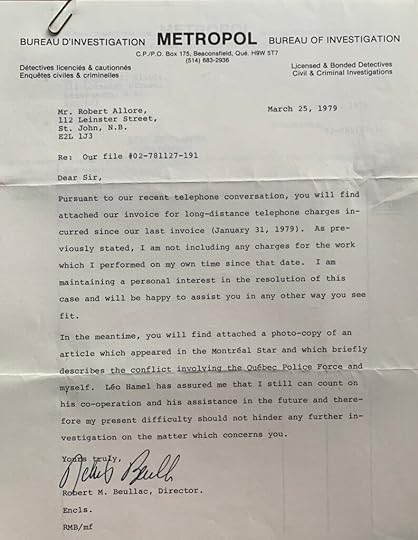
À l’issue du procès de Fernand Laplante, la Sûreté du Québec a fait arrêter l’enquêteur privé Robert Beullac pour s’être fait passer pour un policier auprès des résidents du chemin Astbury lors de l’expérience où il a prouvé qu’une arme à feu n’a pas été tirée à l’endroit la nuit de les meurtres de Grimard et Bergeron.
Les accusations étaient des représailles contre Beullac pour avoir déposé une plainte auprès de la Commission de police du Québec alléguant que «des policiers provinciaux avaient battu des suspects, intimidé des témoins et fabriqué des preuves lors d’enquêtes sur des crimes dans et autour de la ville de Sherbrooke, dans les Cantons-de-l’Est». Beullac avait documenté plusieurs passages à tabac par la SQ contre des résidents des Cantons. Plus précisément, il a cité les enquêteurs de la SQ pour avoir sauvagement battu Fernand Laplante à plusieurs reprises lors de son arrestation initiale entre le 3 et le 5 août 1978. Il a accusé la Sûreté du Québec de s’être livrée à des «actes de brutalité, d’intimidation envers des témoins à décharge» en précisant qu’un enquêteur avait tordu les seins de la femme de Laplante, Claire Dussault. Beullac a en outre allégué que les enquêteurs avaient eu une conversation inappropriée et décontractée avec le jury lors du procès de Laplante. Robert Beullac n’était que l’un des nombreux Québécois à demander justice au ministre Marc-André Bédard en 1979. Le père de Diane Dery (assassinée avec Mario Corbeil) a adressé une pétition à Bédard au sujet de l’enquête bâclée de sa fille. Avant la clôture de cette année-là, Bedard a dû ordonner une enquête sur la fusillade par la police de la SQ de dans la réserve de Kahnawake au sud de Montréal.
« Le problème, c’est que la police provinciale de la région de Sherbrooke n’arrive pas à résoudre les cas par les méthodes normales… alors ils ont commencé à utiliser des raccourcis »
“Local police accused of lying, intimidation”, Sherbrooke Record, August 31, 1979
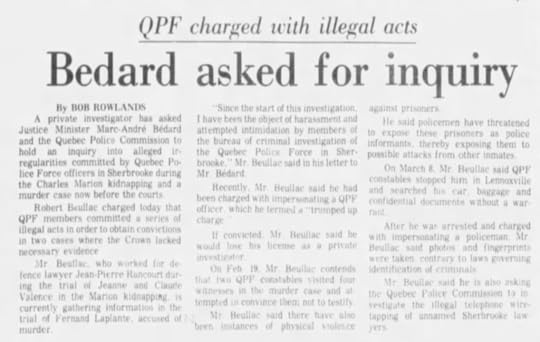 Montreal Star, March 14, 1979
Montreal Star, March 14, 1979Frustré par le manque de coopération qu’il recevait de la police locale et de l’administration du Collège Champlain à la suite de la disparition de Thérèsa, mon père a embauché Robert Beullac. Si Beullac croyait que son conflit avec la SQ n’entraverait pas son travail sur le cas de Theresa, il se trompait complètement. Plutôt que de percer le brouillard de sa disparition, la présence imposante de Beullac sur le terrain était un obstacle de plus qui a gêné une enquête en bonne et due forme – peu importe de toute façon, car nous voyons maintenant que la SQ (ou QPF en anglais les appelait) avaient peu d’intérêt à résoudre les crimes contre les femmes. Charles Marion était un gros problème. Raymond Grimard était un grand fromage. Mais Manon Bergeron qui a été retrouvée avec lui était la cinquième affaire en ce qui concerne la police, le plus souvent qualifiée de «concubine» ou de «sa pute» de Grimard. Et Carole Fecteau ? Comme je l’ai dit, le vrai jetsam du crime, une réflexion après coup. A-t-elle même obtenu un procès? Nous y viendrons.
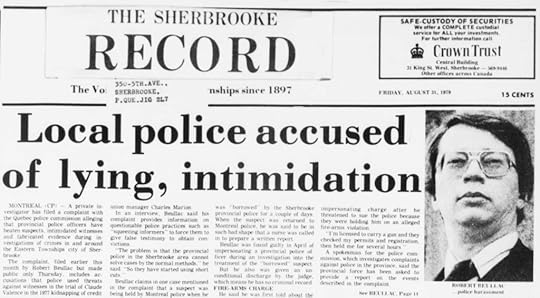 Corrupt Cops – Robert Beullac
Corrupt Cops – Robert BeullacL’acrimonie entre Beullac et la police était si corrosive qu’ils ne supportaient même pas d’être dans la même pièce ensemble, et feignaient au moins la civilité et la coopération face au stress et au chagrin que subissaient mes parents. Une fois, j’ai fait remarquer à Bob une rencontre entre mes parents, le chef de police de Lennoxville Leo Hamel et le caporal de la SQ Roch Gaudreault qui a eu lieu au Hilton de l’aéroport de Montréal à l’occasion du premier anniversaire de sa disparition. J’ai suggéré par erreur que le détective privé était également là, ce à quoi Beullac a répondu: “Non, cela ne s’est jamais produit”. Quand je lui ai demandé comment il en était si sûr, il a répondu catégoriquement: “Parce que si Rocky avait franchi la porte d’entrée du Hilton, je me serais immédiatement levé et je serais sorti par la porte arrière.”
Procès Charland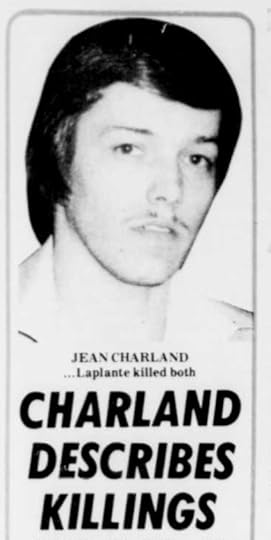 Jean Charland cleaned himself up for his trial
Jean Charland cleaned himself up for his trialLe procès de Jean Charland pour les meurtres au premier degré de Raymond « le loup » Grimard et de Manon Bergeron est finalement entendu à l’automne 1979, cinq mois après la condamnation de son soi-disant complice, Fernand Laplante qui purgeait alors sa peine à perpétuité. pour les meurtres. Bon nombre des mêmes personnages ont été amenés devant le juge Carrier Fortin. Une matinée entière a été consacrée au dossier juvénile de Luc Landry, comment à 16 ans il a braqué une Compton Credit Union et sa condamnation à Thunder Bay pour défaut de payer un sandwich.
L’officier de la SQ Réal Chateauneuf a témoigné avoir récupéré une bille de bouleau le 8 janvier 1979 sous un escalier au sous-sol de la maison de Charland à Lennoxville qui contenait 69 cartouches. Une cartouche qui a réussi à être identifiable correspondait à quatre cartouches récupérées sur le corps de Grimard. Difficile d’imaginer pourquoi Charland ressentirait le besoin de dissimuler des preuves qui pointaient vers un nous apon utilisé, selon la police et Charland, par Laplante pour abattre Grimard. Rappelons que d’après le propre témoignage de Charland, l’arme du crime aurait été récupérée chez lui le soir des meurtres, mais ensuite utilisée par Laplante.
Le 3 octobre 1979, exactement 11 mois après la disparition de Thérèse Allore, Jean Charland est également condamné à la réclusion à perpétuité pour les meurtres de Grimard et Bergeron. Il est difficile de comprendre pourquoi. Il n’y avait qu’une seule arme utilisée pour tirer sur Grimard. Le problème était simple, soit Charland lui a tiré dessus, soit Laplante, mais pas les deux. La justice de Sherbrooke semblait travailler sous l’angle suivant : “Eh bien, quelque chose comme ça s’est produit, alors condamnons-les tous les deux et passons à autre chose.”
L’avocat de Charland, Richard Marcheterre, a demandé une révision. Mais contrairement à Laplante, l’appel de Charland a rencontré un résultat très différent. La preuve de la poursuite reposait sur leur principal témoin, le témoignage de Luc Landry sur la façon dont Charland lui avait raconté au Moulin Rouge comment il avait « pimenté Grimard » dans une ruelle de la rue Wellington. En 1981, la Cour d’appel du Québec infirme le jugement et Charland est libéré. Les trois juges du comité d’appel considéraient le témoignage de Landry comme du ouï-dire (n’était-ce pas le témoignage de Charland contre le ouï-dire de Laplante ?) et “pensaient à l’unanimité que rien dans la preuve ne reliait Charland aux victimes”. Je suppose qu’ils avaient besoin de plus de points pour se connecter que le fusil utilisé pour assassiner Grimard caché dans la maison de Charland, et ce journal.
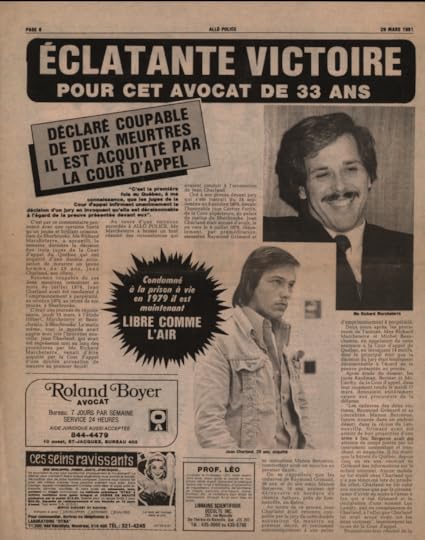 Allo Police, 29 Mars, 1981
Allo Police, 29 Mars, 1981Il s’agit d’une victoire sans précédent pour le jeune avocat de Charland, Richard Marcheterre, qui a déclaré que « c’était la première fois au Québec qu’il se souvenait que les juges avaient pris une décision à l’unanimité au motif que la preuve était déraisonnable ». La Tribune a rapporté qu’il était “extrêmement rare que la Cour d’appel annule un verdict de cette manière, ordonnant plutôt un nouveau procès dans de nombreux cas”. Rare en effet, quels « inconnus » sont intervenus en faveur de Charland ? Allo Police écrivait sèchement que Charland avait été « libéré comme l’air », et il l’était donc. Alors que Fernand Laplante languit à la prison de Dorchester pendant plus de 40 ans, Charland est retourné à sa routine habituelle d’incendies criminels et de vols à Lennoxville, et la communauté a fermé les yeux sur tout cela.
Le jour même où la condamnation de Charland a été annulée, et dans ce que la Sûreté du Québec a dû considérer comme un fait accompli, La Tribune rapporte que la Commission de Police du Québec a rejeté les plaintes déposées par Robert Beullac pour inconduite policière lors du procès Laplante. Beullac pestait depuis deux ans que Jean Charland avait obtenu l’immunité en échange de son témoignage contre Laplante. Personne n’a écouté. Dans ce que La Tribune a qualifié de « dernières gouttes du flot de plaintes » contre la SQ, la Commission de police a déterminé qu’il n’y avait pas lieu à une enquête publique et a demandé à la Police du Québec d’essayer d’éviter des actes « d’imprudence » à l’avenir.
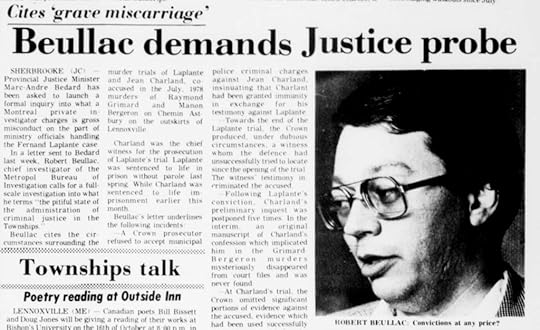 Robert Beullac demands Justice probe“Nous attendons””
Robert Beullac demands Justice probe“Nous attendons””Jean Charland a repris là où il s’était arrêté et, au cours de la décennie suivante, il est devenu plus une nuisance publique qu’une menace pour les Cantons. Moins de 7 mois après son acquittement et près de 3 ans jour pour jour après la disparition de Theresa Allore, Jean et son frère cadet, Marc Charland (l’ancien petit ami de Carol Fecteau) ont été arrêtés pour avoir brisé la vitre avant du Sinclair Bowling Alley juste au nord du Moulin Rouge. L’agent Rodrigue a rattrapé les frères dans une ruelle de Wellington, caché sous un escalier en fer. Lorsqu’on leur a demandé ce qu’ils faisaient, ils ont répondu: “rien, nous attendons”. Imaginez l’excitation de Richard Marcheterre lorsqu’il s’est également vu confier cette affaire (voir carte, la rue Wellington est à court d’immobilier).
Quatre mois plus tard, en mars 1982, Charland est de nouveau devant le tribunal, cette fois pour s’être introduit par effraction dans le restaurant de son père, Chez Charles, sur la rue Queen à Lennoxville. Il était maintenant parti depuis longtemps avec la coiffe disco qu’il arborait lors de son procès pour meurtre, retombant sur les cheveux longs et une veste en jean alors qu’il faisait face au magistrat. Lorsqu’Ivan Charland s’aperçoit qu’il manque 680 $ à la caisse, il fait arrêter son fils par le chef de la police de Lennoxville, Léo Hamel. Le zélé Hamel a même mené une enquête avec la collaboration de deux agents de la Sûreté du Québec. Charland venait tout juste d’être mis en probation pour un autre cambriolage d’un garage des Cantons. Charland avait alors un nouvel avocat, Michel Beauchemin, qui a plaidé auprès du juge Roberge pour qu’il considère que Charland était aux prises avec un problème de drogue et d’alcool. Le procureur Claude Mélançon (vous vous souvenez de lui du procès de Laplante?), a déclaré que la boisson n’était pas pertinente et que Charland avait violé sa probation. La Tribune n’a pas tardé à noter que l’appel de Fernand Laplante à la Cour suprême du Canada avait été rejeté, tandis que Charland – accusé des mêmes meurtres – a été libéré par un tribunal inférieur du Québec. Pour les Cantons, Jean Charland était devenu le cadeau qui ne cessait de donner.
Je PenseJe ne suis pas un génie de l’investigation, je simple possèdent de bonnes capacités d’analyse et sont capables, parfois, de décomposer et de rassembler d’énormes quantités d’informations complexes. Lors de l’examen des suspects dans le cas de ma sœur, cela semblait une assez bonne hypothèse de ne pas se concentrer sur les personnes qui avaient récemment été accusées ou condamnées pour des crimes similaires. Je pensais que le processus judiciaire les éliminerait pour examen, ils étaient maintenant passés devant les tribunaux et étaient soit en prison, soit sous l’œil vigilant de la police. Ou alors vous supposeriez, non?
Ce genre de raisonnement s’effondre lorsqu’on considère quelqu’un comme Jean Charland, et un corps policier comme la Sûreté du Québec qui défie complètement la logique. L’argument est que Charland n’aurait pas participé au meurtre de Theresa parce qu’il était sur la piste d’un meurtre précédent, et donc en prison, n’est-ce pas ? Sauf qu’il n’était pas en prison, il était libre. Il vivait dans la maison de ses parents à Lennoxville (où Theresa a été vue pour la dernière fois) et il a échappé à l’attention jusqu’à la nuit de l’incendie du motel Aloha, le 10 novembre, une semaine après la disparition de Theresa. Comment la police a-t-elle pu passer à côté d’un détail aussi important ? A moins qu’ils ne veuillent pas attirer l’attention dessus. Ils ne voulaient pas que cela soit remarqué par qui que ce soit.
“Là pour voir des motos”Il y avait une histoire qui a couru à La Tribune l’été 1995 à propos d’une compétition de motos qui se déroulait pendant un long week-end, et la crainte locale que des gangs de motards comme les Hells Angels pourraient l’envahir. C’est une vieille histoire, ces cris de vigilance reviennent de temps en temps. Vingt-cinq ans plus tôt, pratiquement le même article avait paru dans La Tribune à propos d’une compétition estivale de vélo impliquant les Gitans, les précurseurs des Hells. Boy-Boy Beaulieu a même été interviewé, on en parlait dans Père Jean Salvail, Le Curé Motard de Sherbrooke.
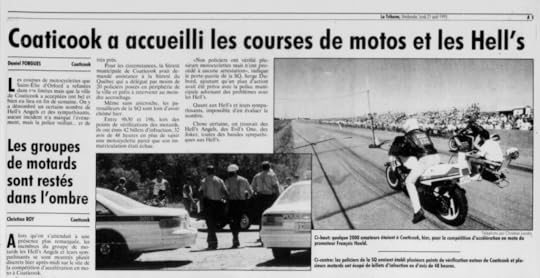 La Tribune, 21 Aout, 1995
La Tribune, 21 Aout, 1995Le reporter Daniel Forgues a sondé le public pour vérifier la température des participants, et il a interviewé un dénommé Jean Charland, un « fan », présent toute la journée de compétition :
“J’étais assis juste à côté d’un gars des Evil Ones, je ne l’ai pas dérangé, et il a fait pareil. Et je ne me suis pas empêché de crier et de raconter des blagues à leur sujet. Eux aussi sont là pour voir des motos »
“Coaticook a accueilli les courses de motos et les Hell’s”, Daniel Forgues, La Tribune, 21, Aout, 1995
Bien sûr, il est utile d’être si complaisant sur ces questions si vous êtes vous-même un membre connecté des Hells Angels. Si en fait c’était notre Jean Charland.
Les Gitans Jean Charland – celui impliqué dans les meurtres de 1978, qui a mis le feu au motel Aloha, qui est devenu un vagabond public – est décédé trois ans plus tard à Sherbrooke le 30 juillet 1998. Il avait 39 ans. Il en paraissait 60. On m’a dit que il est mort du SIDA. S’il avait autre chose à dire sur ce qui s’est passé dans les Cantons-de-l’Est en 1978, il a emporté ses secrets avec lui. Il n’y a pas eu de confession sur le lit de mort.
 Nécrologie de Jean Charland, 30 juillet 1998Les motards de la Colombie-Britannique
Nécrologie de Jean Charland, 30 juillet 1998Les motards de la Colombie-BritanniqueTrès tôt quand j’ai commencé ce site, j’ai écrit sur l’affaire Fernand Laplante. J’ai lu à ce sujet dans un almanach annuel Allo Police, et j’ai posté les photos de Laplante, Charland, Grimard, Bergeron et Beullac, typographiques avec un fond rouge criard (donc Allo), vers le début des années 2000. Presque immédiatement, j’ai reçu un appel de mon père me demandant de tout démonter.
Il m’a dit qu’un vieil ami de collège à lui, qui avait été ami avec Laplante, avait été contacté par des « gens de la Colombie-Britannique ». Lorsque je lui ai demandé de qui il s’agissait, il est devenu évident qu’il faisait référence à des membres du crime organisé, des motards que l’ami de l’université connaissait, qui ont suggéré qu’il serait dans mon intérêt que je n’écrive pas sur de telles choses. Je suis un fils obéissant, alors j’ai fait ce qu’on m’a dit, j’ai noté l’histoire. Je noterai qu’en 1978, mes parents n’avaient aucune connaissance des meurtres survenus plus tôt dans l’année précédant la disparition de Theresa ; pas Grimard et Bergeron, pas Fecteau, ni même Manon Dubé. Cette information leur a été cachée par la police, et ils vivaient à l’extérieur du Québec, leurs nouvelles locales n’auraient pas couvert les histoires. Il est douteux que la police ait même fait le lien avec ces cas eux-mêmes à l’époque, n’est-ce pas ? Nous verrons.
Des années plus tard, juste avant sa mort, j’ai interrogé mon père sur cet épisode. À ce moment-là, son ami d’université était décédé, alors j’espérais obtenir plus d’informations, peut-être la véritable nature de son envie. Mais mon père a changé l’histoire. Ce n’était pas des motards de la Colombie-Britannique, c’était simplement que l’ami du collège avait connu Fernand Laplante, et maintenant qu’il était en liberté conditionnelle, il voulait voir qu’il prenait un nouveau départ, il n’avait pas besoin que je drague le passé. Il vaudrait mieux que je ne parle pas de telles choses et que je laisse le passé à la mémoire.
Mon père n’a menti que dans des circonstances rares et exceptionnelles. Ce n’est pas ma mémoire qui est défaillante, je sais ce qu’il a dit la première fois.
Jean Charland – Prodigal Son
“March 25, 1979
Dear Mr. Allore,
… you will find attached a photo-copy of an article which appeared in the Montreal Star and which briefly describes the conflict involving the Quebec Police Force and myself. Leo Hamel has assured me that I still can count on his co-operation and his assistance in the future and therefore my present difficulty should not hinder any further investigation on the matter which concerns you.
Yours Truly.
Robert M. Beullac, Director, Metropol Bureau of Investigation”

At the conclusion of Fernand Laplante’s trial, the Surete du Quebec had Private Investigator Robert Beullac arrested for impersonating a police officer to residents of Astbury Road during the experiment where he proved that a gun was not fired at the location the night of the Grimard and Bergeron murders.
The charges were retaliation for Beullac having filed a complaint with the Quebec Police Commission alleging that “provincial police officers had beaten suspects, intimidated witnesses and fabricated evidence during investigations of crimes in and around the Eastern Townships city of Sherbrooke.” Beullac had documented several beatings by the SQ against Townships residents. Specifically he cited SQ investigators for having savagely beaten Fernand Laplante on several occasions during his initial arrest between August 3 and 5, 1978. He charged that the Surete du Quebec engaged in “acts of brutality, intimidation towards defense witnesses” elaborating that an investigator had twisted the breasts of Laplante’s wife, Claire Dussault. Beullac further alleged investigators made inappropriate, casual conversation with the jury during Laplante’s trial. Robert Beullac was just one of many in a long queue of Quebecers demanding justice from Minister Marc-Andre Bedard in 1979. The father of Diane Dery (murdered with Mario Corbeil) petitioned Bedard over his daughter’s botched investigation. Before the close-out of that year Bedard had to order an investigation into the SQ police shooting of on the Kahnawake Reserve south of Montreal.
“The problem is that the provincial police in the Sherbrooke area cannot solve cases by the normal methods… so they have started using short cuts “
“Local police accused of lying, intimidation”, Sherbrooke Record, August 31, 1979
 Montreal Star, March 14, 1979
Montreal Star, March 14, 1979Frustrated by the lack of cooperation he was receiving from local police and Champlain College administration in the wake of Theresa’s disappearance, my father hired Robert Beullac. If Beullac believed his conflict with the SQ wouldn’t hinder his work on Theresa’s case he was dead wrong. Rather than cutting through the fog of her disappearance, Beullac’s imposing presence in the field was one more obstacle that got in the way of a proper investigation – not that that matter much anyway, as we now see that the SQ (or QPF as the English called them) had little interest in solving crimes against women. Charles Marion was a big deal. Raymond Grimard was big cheese. But Manon Bergeron who was found with him was fifth business as far as the police were concerned, most often referred to as Grimard’s “concubine” or his “bitch”. And Carole Fecteau? As I’ve said, true crime jetsam, an afterthought. Did she even get a trial? We’ll come to that.
 Corrupt Cops – Robert Beullac
Corrupt Cops – Robert BeullacThe acrimony between Beullac and police was so corrosive, they couldn’t even stand to be in the same room together, and at least feign civility and cooperation in the face of the stress and grief my parents were under. I once remarked to Bob about a meeting that occurred between my parents, Lennoxville Police Chief Leo Hamel and SQ Caporal Roch Gaudreault that took place at the Montreal Airport Hilton on the one-year anniversary of her disappearance. I mistakenly suggested that the private detective had been there as well, to which Beullac interjected, “No, that never happened”. When I asked him how he was so sure, he replied flat, “‘Cause if Rocky walked in the front door of the Hilton, I would have immediately got up and walked out the back door.”
When the log rolls overJean Charland’s trial for the first-degree murders of Raymond “the Wolf” Grimard and Manon Bergeron was finally heard in the fall of 1979, five months after the conviction of his so-called accomplice, Fernand Laplante who by now was serving his life sentence for the murders. Many of the same cast of characters were brought before Judge Carrier Fortin. An entire morning was spent on Luc Landry’s juvenile record, how at 16 he held up a Compton Credit Union, and his Thunder Bay conviction for failure to pay for a sandwich.
SQ officer Réal Chateauneuf testified that he recovered a birch log on January 8, 1979 under a staircase in the basement of Charland’s home in Lennoxville which contained 69 rounds of ammunition. One round that managed to be identifiable matched four rounds recovered from Grimard’s body. Hard to imagine why Charland would feel the need to conceal evidence that pointed to a weapon used, according to police and Charland, by Laplante to gun down Grimard. Recall that from Charland’s own testimony, the murder weapon would have been retrieved from his house on the night of the murders, but then used by Laplante.
 Jean Charland cleaned himself up for his trial
Jean Charland cleaned himself up for his trialOn October 3, 1979, exactly 11 months after the disappearance of Theresa Allore, Jean Charland was also sentenced to life imprisonment for the murders of Grimard and Bergeron. It’s hard to understand why. There was only one weapon used to shoot Grimard. The issue was simple, either Charland shot him or Laplante, but not both. Sherbrooke justice seemed to be working an angle of, “Well, something like this happened, so let’s convict them both and move on.”
Charland’s lawyer, Richard Marcheterre, requested a review. But unlike Laplante, Charland’s appeal was met with a very different outcome. The prosecution’s case hinged on their chief witness, Luc Landry’s testimony of how Charland had told him at the Moulin Rouge how he “peppered Grimard” in an alley along Wellington Street. In 1981 The Quebec Court of Appeal overturned the judgement and Charland was set free. The three judges on the appeal board regarded Landry’s testimony as hearsay (wasn’t Charland’s testimony against Laplante hearsay?), and “unanimously believed that nothing in the evidence linked Charland to the victims”. I guess they needed more dots to connect than the rifle used to murder Grimard stashed in Charland’s house, and that log.
 Allo Police, 29 Mars, 1981
Allo Police, 29 Mars, 1981It was an unprecedented victory for Charland’s youthful attorney, Richard Marcheterre, who commented “it was the first time in Quebec he remembered that the judges unanimously came to a decision on the grounds that the evidence was unreasonable.” La Tribune reported that it was “extremely rare for the Court of Appeal to reverse a verdict in this way, ordering a new trial in many cases instead.” Rare indeed, what “unknown persons” intervened on Charland’s behalf? Allo Police dryly wrote that Charland had been “liberated like air”, and so he was. While Fernand Laplante languished in Dorchester Prison for over 40 years, Charland went back to his regular Lennoxville routine of arsons and robberies, and the community turned a blind eye to it all.
On the same day that Charland’s conviction was overturned, and in what the Surete du Quebec must have considered a fait accompli, La Tribune reported that the Quebec Police Commission dismissed complaints made by Robert Beullac of police misconduct during the Laplante process. Beullac had been railing for two years that Jean Charland had been granted immunity in exchange for his testimony against Laplante. Nobody listened. In what La Tribune called “the last drops of the flood of complaints” against the SQ, the Police Commission determined there were no grounds for a public inquiry, and asked Quebec Police to try and avoid acts of “recklessness” in the future.
 Robert Beullac demands Justice probe“We are waiting”
Robert Beullac demands Justice probe“We are waiting”Jean Charland picked up where he had left off, and for the next decade became more of a public nuisance than a menace to the Townships. Less than 7 months after his acquittal and almost 3 years to the day of Theresa Allore’s disappearance, Jean and his younger brother, Marc Charland (the one time boyfriend of Carol Fecteau) were arrested for for smashing the front glass of the Sinclair Bowling Alley just north of the Moulin Rouge. Constable Rodrigue caught up with the brothers in a Wellington alley hiding under an iron staircase. When asked what they were doing, they replied, “nothing, we are waiting.” Imagine Richard Marcheterre’s excitement when he was also handed this case (see map, Rue Wellington is running out of real estate).
Four months later, in March 1982, Charland was back in court again, this time for breaking into his father’s restaurant, Chez Charles on Lennoxville’s Queen Street. By now he had long departed with the disco coif he sported during his murder trial, falling back on long hair and a jean jacket as he faced the magistrate. When Ivan Charland noticed $680 missing from the till, he had Lennoxville Police Chief Léo Hamel arrest his son. The zealous Hamel even conducted an investigation with the cooperation of two Surete du Quebec agents. Charland had only just been placed on probation for another burglary of a Townships garage. By now Charland had a new attorney, Michel Beauchemin, who pleaded with Judge Roberge to consider that Charland was dealing with a drug and alcohol problem. Prosecutor Claude Mélançon (remember him from Laplante’s trial?), said that drink was irrelevant, and Charland had violated his probation. La Tribune was quick to note that Fernand Laplante’s appeal to the Supreme Court of Canada had been denied, while Charland – accused of the same murders – was set free by a lower, Quebec court. For the Townships, Jean Charland had become the gift that kept on giving.
No shit, SherlockI am no investigative genius, I simply possess good analytical skills, and am able to, sometimes, take apart and reassemble massive amounts of complex information. When considering suspects in my sister’s case, it seemed a fairly good assumption that you would not focus on persons who had recently been accused or convicted of similar crimes. My thinking was that the justice process would eliminate them for consideration, they had now transitioned to the courts and were either in jail or prison, or under the watchful eye of police. Or so you’d assume, right?
That sort of reasoning collapses when considering someone like Jean Charland, and a police force like the Surete du Quebec who completely defy logic. The arguement goes that Charland would not have been party to Theresa’s murder because he was on trail for a previous murder, and therefore in jail, right? Except he wasn’t in jail, he was free. He was living at his parents’ house in Lennoxville (where Theresa was last seen) and he escaped notice until the night of the Aloha Motel fire, November 10, one week after Theresa’s disappearance. How could the police miss such an important detail? Unless they didn’t want to call attention to it. They didn’t want it to be noticed by anyone.
“There to see motorcycles”There was a story that ran in La Tribune the summer of 1995 about a motorcycle competition that was occurring over a long weekend, and local concern that biker gangs like The Hells Angels might be overrunning it. It is an old story, these cries for vigilance crop up from time to time. Twenty-five years earlier practically the same article ran in La Tribune about a summer bike competition that involved The Gitans, the forerunners of the Hells. Boy-Boy Beaulieu was even interviewed, we talked about this in Father Jean Salvail, The Biker Priest of Sherbrooke.
 La Tribune, 21 Aout, 1995
La Tribune, 21 Aout, 1995Reporter Daniel Forgues canvassed the audience to check the temperature of participants, and he interviewed someone named Jean Charland, a “fan”, attending the entire day of competition:
“I was sitting right next to a guy from the Evil Ones, I didn’t bother him, and he did the same. And I didn’t stop myself from yelling and telling jokes about them. They too are there to see motorcycles”
“Coaticook a accueilli les courses de motos et les Hell’s”, Daniel Forgues, La Tribune, 21, Aout, 1995
Of course, it helps to be so complacent about these matters if you yourself are a connected member of The Hells Angels. If in fact this was our Jean Charland.
The Gitans Jean Charland – the one involved in the 1978 murders, who set the Aloha Motel fire, who became a public vagrant – died three years later in Sherbrooke on July 30, 1998. He was 39. He looked 60. I was told that he died of AIDS. If he had anything further to say of what went on in the Eastern Townships in 1978, he took his secrets with him. There was no death bed confession.
 Jean Charland obituary, 30 Juillet, 1998The Bikers of BC
Jean Charland obituary, 30 Juillet, 1998The Bikers of BCVery early on when I started this website I wrote about the Fernand Laplante affair. I read about it in a Allo Police annual almanac, and posted the photos of Laplante, Charland, Grimard, Bergeron, and Beullac, typefaced with a garish red background (so Allo), sometime around the early 2000s. Almost immediately, I got a call from my father asking me to take it all down.
He told me an old college friend of his, who had been friends with Laplante, had been contacted by some “people in British Columbia”. When I pressed him on who this was, it became obvious that he was referring to members of organized crime, bikers who the college friend was acquainted with, who suggested it would be in my best interest if I did not write about such things. I’m an obedient son, so I did what I was told, I took the story down. I will note that in 1978, my parents had no knowledge of any of the murders that had occurred earlier in the year prior to Theresa’s disappearance; not Grimard and Bergeron, not Fecteau, or even Manon Dube. This information was withheld from them by police, and they were living outside of Quebec, their local news would not have covered the stories. It’s doubtful police even made the connection with these cases themselves at the time, or is it? We shall see.
Years later, just before he died, I asked my dad about this episode. By this time, his college friend had passed, so I was hoping to get some more information, perhaps the true nature of his urging. But my father changed the story. Now it wasn’t bikers from B.C., it was simply that the college friend had known Fernand Laplante, and now that he was out on parole, he wanted to see that he got a fresh start, he didn’t need me dredging up the past. It would be better that I not talk about such things, and leave the past to memory.
My father only ever lied under rare and exceptional circumstances. It’s not my memory that is faulty, I know what he said the first time.
May 17, 2022
How we know Regis Lachance was a police informant
In April 2020, we were putting the finishing touches on Wish You Were Here. I had newly made the acquaintance of Jean-Pierre Rancourt, the lawyer who had defended Fernand Laplante, and I was eager to include his words about the case in the final draft of the book. Jean-Pierre had graciously mailed me a copy of his book, Confessions d’un Criminaliste, but it hadn’t arrived yet. Through telephone conversations, Rancourt told me what he had written in the book about the trial; how it was a set up, and how at the last minute the Crown called a police informant to the stand who jeopardized his whole case. He could not remember the name of the informant, but he assured me it was in the book, and I would have it once it arrived.
I desperately wanted the informant to be Luc Gregoire, the Sherbrooke sexual predator I was convinced had not only murdered my sister, Theresa, but may have been responsible for the murder of Louse Camirand and the death of Manon Dubé, so I emailed Jean-Pierre and asked him to respond with the name. This was all very dramatic, and he gave me the impression he was minutes away from retrieving it. Not able to wait, I blurted out, “Gregoire” in an email message. Rancourt responded, “Non, I will find it… His name is Regis Lachance”
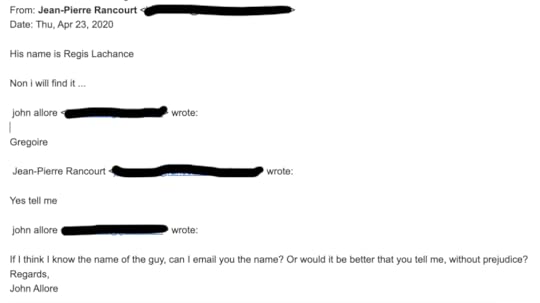
I felt defeated, like I’d reached another dead end. So I catalogued this bit of information, like the 27 packets of take-out soy sauce you stash in your kitchen junk drawer because, you never know. It would take me another year to realize that this was not the end, it was the beginning of the end.
A word about Jean-Pierre Rancourt. He worked some controversial cases included the defense of Claude Valence, the lead figure in the 1978 Charles Marion kidnapping affaire. He represented Guy Lafleur, the Montreal Canadiens Hockey Hall of Famer who only recently died, in a complex case where Lafleur was accused of assisting his son, Mark in evading conditions of his bail. Readers of this site know his name, as he defended the Sherbrooke Police in the 1983 Rock Forest affaire. Later in life, Rancourt also took the case of Agent 728, the Montreal police officer convicted of assaulting protesting students with pepper spray in 2016.
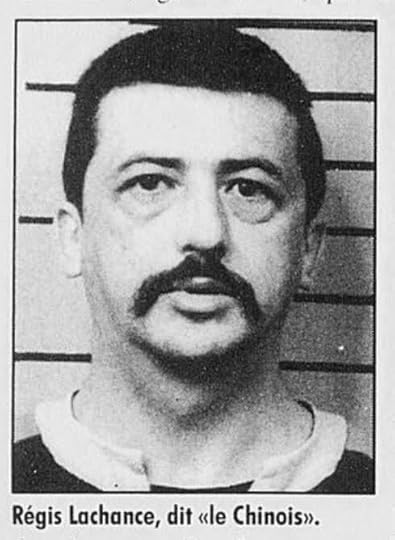 The other Regis Lachance
The other Regis LachanceSome saw Rancourt as an “underworld attorney”, one of his closest friends was Frank Shoofey, another Quebec lawyer who famously took the case of Richard Blass, the gangster gunned-down in a police raid in 1975. Shoofey himself was gunned-down in his law office in 1985. His murder remains unsolved. Rancourt once represented a guy accused of making a threatening phone call to Premier René Lévesque. He even defended Regis Lachance… the other Regis Lachance. That’s right, there were two of them. Regis “Le Chinois” Lachance was an Atomes biker who in 1982 stabbed a patron at Phil’s Diner on King Street West in Sherbrooke for refusing to give up his seat at the lunch counter. Tough place this Quebexico.
I don’t care that Rancourt defended mobsters or police, though there is some question as to whether higher powers asked him to handle the Laplante case (who was paying the bill?). It does not matter to me that he was on the other side in the Rock Forest affair, that’s business. For me, Rancourt had a passion and determination for extracting the truth. Everyone has the right to stand-up for themselves. It does not gibe that Laplante was guilty of the Grimard / Bergeron murders on the basis that police believed he was responsible for other crimes. That’s not the way justice works. If those are your rules, then the police are just as bad as the criminals, and they were. As a finally note, today’s police – at least the ones I communicate with in the Surete du Quebec – hold Jean-Pierre Rancourt in high regard, believing him to have been a formidable attorney.
Concluding the trialRégis Lachance finally showed up in court, but not as a witness in Rancourt’s process as the defense attorney had intended – Lachance was now a protected witness for the prosecution, the last witness called to the box on the 14th day of Fernand Laplante’s trial. In fact, Superior Court Judge Paul Gervais granted a special request made by Crown Prosecutor Claude Melancon to reopen the Crown’s case in light of this new witness with “pertinent evidence”.
Most of his testimony covered the events surrounding the Aloha Motel fire which we have already discussed – how Lachance denied that the arson attempt was a set-up by the police, with the goal of securing a statement from Jean Charland that would incriminate Fernand Laplante (it was exactly that).
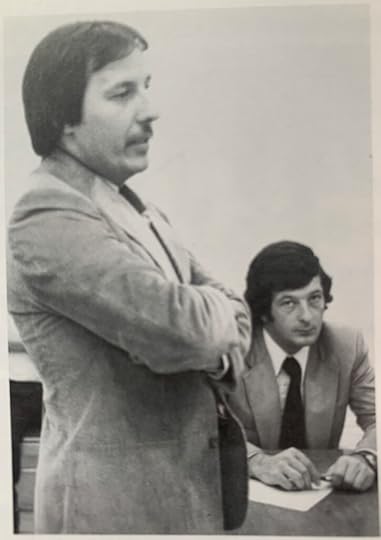 Jean-Pierre Rancourt during the trial of Fernand Laplante, de “Les Confessions d’un Criminaliste”, Bernard Tetrault, Stanke, 2015
Jean-Pierre Rancourt during the trial of Fernand Laplante, de “Les Confessions d’un Criminaliste”, Bernard Tetrault, Stanke, 2015On the stand, Lachance said that Laplante came to his home on Rue LaRocque that summer following the murders. As Lachance stood on his balcony, Laplante, accompanied by his wife, Claire Dussault, yelled up at him from his yard asking him to come down because he had business to discuss with him. When Lachance refused, Laplante and Dussault went up to his apartment. Lachance asked Dussault to leave, which she did. Then according to Regis Lachance, Laplante said ” he had a big mouth and that if he didn’t keep his mouth shut, the same thing would happen to him as to Grimard and his dog.”
I would argue that a conversation like this might have happened, but the other way around, with Lachance threatening Laplante to keep his mouth shut or he would be killed. For we already know Regis Lachance was a liar, he lied when he stated that Aloha was not a police set-up. What is most important in this testimony – not withstanding the the appalling comparison of Manon Bergeron to a dog – are two things: the fundamental fact that Laplante and Lachance knew each other, and that Regis Lachance lived on Rue LaRocque. Rue LaRoque is one block from the location where Grimard and Bergeron were last seen by Guy Robert, and two blocks from the Rue Short location where taxi driver William Pettigrew let out his tattooed passenger – who was Lachance – the morning of their murders.
In cross-examination, Regis Lachance acknowledged that he had not been arrested by the police in connection with Aloha Motel arson investigation. Jean-Pierre Rancourt asked Lachance if he had gone to the new SQ headquarters on Don Bosco with fire investigator Normand Plourde on November 10 to meet with investigators before the arson incident. Lachance said no.
“You didn’t go to the SQ with Mr. Plourde?”, asked Mr. Rancourt again.
Lachance retorted, “I’ve told you no three times.”
“Laplante aurait menacé Régis Lachance”, La Tribune, 3 Mai, 1979, Page 3
And with that Regis Lachance walked away from the witness stand. Later in the day, Jean-Pierre Rancourt attempted to call him back, but Regis Lachance had already left the court house, apparently feeling empowered enough to do as he wished, whenever he desired, even in defiance of a Quebec criminal process.
The reason we know Regis Lachance was a police informant comes from the following account in Jean-Pierre Rancourt’s biography:
“I noticed that the court reporter Robert Diorio, who was taking notes at the trial, was looking at me funny. He seemed troubled and I guessed he wanted to talk to me. As soon as the judge adjourned for a break, I approached him.
– Jean-Pierre, while listening to the testimony of the Crown witness, I was reminded of a scene I inadvertently witnessed that may have an impact on this trial. I checked my calendar to be sure.
– What are you talking about?
– The Aloha Motel fire occurred on the evening of September 10. On that day, I had arranged for the courthouse staff to visit the brand-new police station. At about 4 or 5 p.m., I saw a fire inspector I know well come in. He was with Régis Lachance, the informant witness, whom I also know well, because he is a regular client of the courts. I said to the investigator, “Did you arrest Régis again?” He replied, obviously uncomfortable: “You didn’t see us here…” In all conscience, I had to let you know”, said Diorio, “but we understand each other, I didn’t tell you anything…”
“Me Jean-Pierre Rancourt: Les Confessions d’un Criminaliste”, Bernard Tetrault, Stanke, 2015, Page 58
Rancourt ignored Diorio’s plea to keep things hush-hush and called him to the stand anyway. Diorio managed to get out that he had toured the new headquarters with other courthouse employees in the late afternoon of November 10, and that he knew the fire investigator Normand Plourde and a man named Régis Lachance. But when Rancourt asked who Diorio had met at the police station, prosecutor Claude Mélançon immediately objected and the name Regis Lachance was never heard.
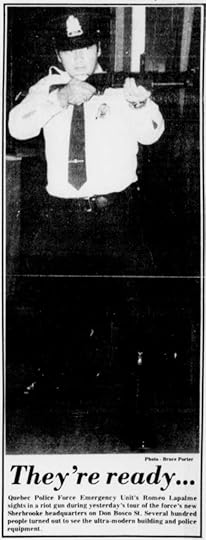
In conversation with Rancourt in 2020 the former attorney told me how Regis Lachance, “lied, lied, lied”. The opening of the new Surete du Quebec Headquarters on Don Bosco was a big deal in the fall of 1978. There were regular tours conducted throughout the month of November, like the one described by Robert Diorio. Rancourt told me of a second encounter with Regis Lachance at the headquarters shortly after the Aloha fire. Another reporter – who may have been Jean Larose – again saw Lachance with SQ officers and sarcastically commented, “Oh you arrested him”, to which one of the officers barked, “You shut your mouth.”
The series of encounters with Lachance at the headquarters of the Quebec Police tells us many things: first, that it wasn’t any great secret that Lachance was an informer; second, that the police weren’t particularly careful in keeping it a secret, or had any great sense of urgency about it; and finally, that Regis Lachance was able to carry himself through channels of law enforcement and the underworld with a sense of entitlement, acting with the knowledge of protection that allowed him to get away with practically anything, maybe even murder.
In Rancourt’s words Regis Lachance “was organized by the SQ to set-up Charland”, and that it was Charland “and another guy” who killed Grimard and Bergeron, not Laplante. Jean Pierre Rancourt also told me how the physical abuse and intimidation by the SQ was not reserved only for interrogations. On several occasions during Laplante’s trail he would encounter officers in the court stairwell and they would “give him the shoulder”, meaning physically brush him as they passed by:
“While I was cross-examining the witness on this, the police officers had daggers in their eyes. And when the court reporter and I were walking the halls later, they tried to intimidate us, to the point of leg-holding and shoulder-poking. I even made a formal complaint to the judge.
– Your Honor, since we brought these facts out in front of you, we have been getting hit in the hallways.
But he ignored me.
– Come on, Maitre Rancourt, you can’t be serious.”
“Me Jean-Pierre Rancourt: Les Confessions d’un Criminaliste”, Bernard Tetrault, Stanke, 2015, Page 59
This was not only “disturbing evidence of collusion”, as Rancourt called it, it was clear evidence that, like Lachance, the Surete du Quebec also acted with total impunity in the era of the late 1970s. If they cut corners and pursued a bogus theory in the investigation of Grimard and Bergeron, just how motivated could they have been to provide a proper investigation for girl who had gone missing and turned up murdered over the same time frame from the Aloha fire in November to Laplante’s trial in the spring of 1979?
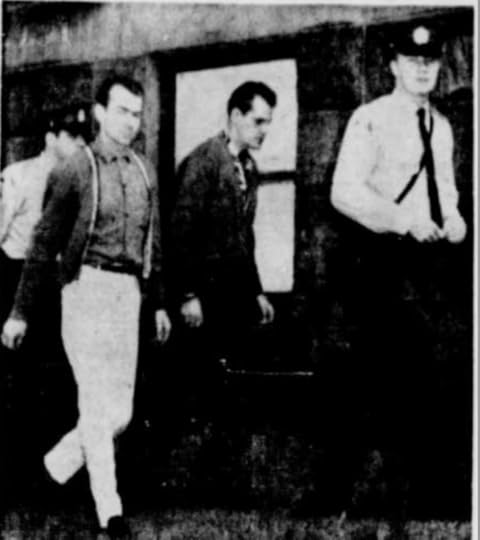 Regis Lachance à gaucheNo victory
Regis Lachance à gaucheNo victory“You, the jury, are composed of 12 people, five women and seven men, from every walk of life. It is very possible that there is at least one among you who understands the underworld at least a little. Perhaps you worked as a waiter as I once did during my college days, in a place where these type of people met. If such was the case, I am sure you would understand that crimes such as the one we are considering here don’t take place quite the same way as the chief witness for the Crown Jean Charland declared.”
Jean-Pierre Rancourt, May 3, 1979
In his closing arguments, Jean-Pierre Rancourt stated flat that Jean Charland’s version of events did not stand up to analysis and logic. He described the 20-year-old Gitans biker as fearless, and someone who had “executed contracts by the shovelful”. He did not believe Raymond Grimard to be a police informer, and did not find it credible that “le loup” would decided to commit a theft at two in the morning, after refusing to commit a daytime robbery on the previous afternoon. The hypothesis that Grimard and Bergeron were killed elsewhere and then dumped at Astbury Road would be much more consistent with reality. Rancourt pointed out the strange, rather obvious, but often overlooked fact that the Crown’s chief witness, who seemed bent on incriminating Laplante, and said he was an innocent spectator in the affair, was also accused of murder in connection with the same crime. Rancourt argued that Charland had an interest in “blaming Laplante for the crime, in protecting other unknown persons”.
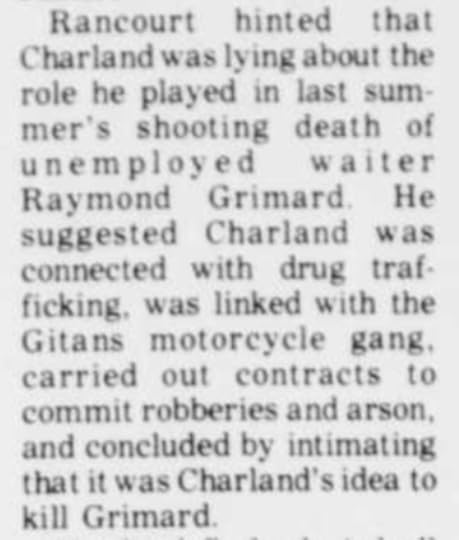
It always seems to be these veiled “unknown persons” in these Sherbrooke affairs. Remember Madame Giguere’s Cassandra-like warning of her husband, Rolland Giguere’s 1969 murder that “ the murderers had been protected by certain individuals to the detriment of the investigators.”
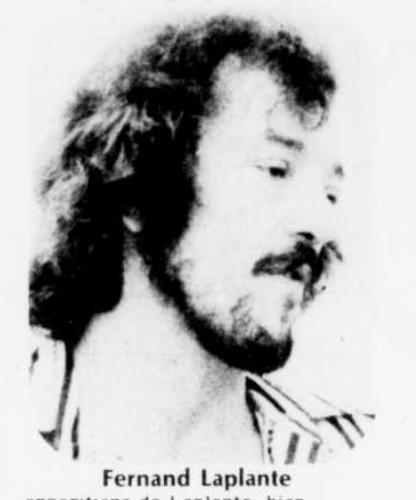 Fernand Laplante
Fernand LaplanteAfter a swift six-hours of deliberation by the seven men and five women jury, on May 7, 1979, 34-year-old Fernand Laplante was found guilty of the murders of Raymond “le loup” Grimard and Manon Bergeron on July 6 in Ascot Township and sentenced to life imprisonment by Superior Court Judge Paul-M. Gervais. Gervais added that detention would allow Laplante the time “to expiate his faults and reflect on his actions.” Jean-Pierre Rancourt immediately announced his intention to request a new trial. Claire Dussault Laplante spat in the face of Jean Charland as she left the courthouse, which appeared to be the customary gesture for the ending of trials in S-Town.
In December 1979, the Supreme Court of Canada turned down Rancourt’s appeal, and Fernand Laplante was ordered to serve his remaining 22 and one-half year sentence before parole eligibility. Fifteen years later appealing his guilty verdict, a contrite Fernand Laplante said he “had paid dearly for his lack of cooperation” in his criminal process. In 2014, at the age of 70, Fernand Laplante was granted full parole. His current whereabouts are unknown.
Laplante maintained his innocence throughout his incarceration. What he did not do was offer any statement of who may have murdered Grimard and Bergeron. Laplante was innocent of these crimes, but he was no stoolie. You can only think that those “unknown persons” held powerful influence over Laplante and the Eastern Townships. Did he feel threatened if he dared to open his mouth?
Bon VoyageWe have talked about how Jean Charland was a Gitans, or an associate of the Gitans biker clan. Fernand Laplante was affiliated with their rivals, the Atomes. Laplante was from Coaticook (where Carole Fecteau was also born), and this village to the south of Sherbrooke has always been known as Atomes turf (remember their clubhouse was burned down there in Sainte Edwidge by the Gitans in the early 1970s – see map).
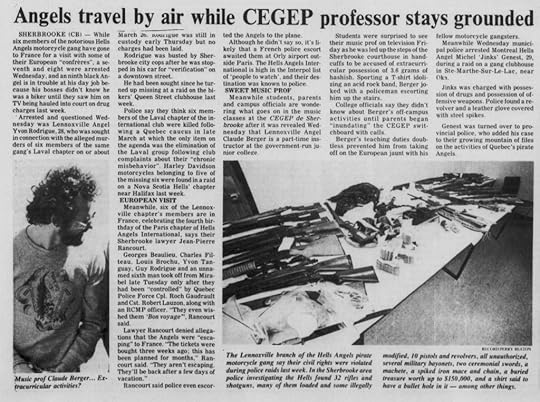 Sherbrooke Record, April 18, 1985
Sherbrooke Record, April 18, 1985There’s a funny – not so funny – article about these bikers “escaping to Paris” during their criminal process for a vacation, our old friend, Corporal Roch Gaudreault of the SQ even gave them a police escort to Mirabel Airport and wished them “Bon Voyage.” This is like a version of Jean Charland under “house arrest” at his parents only on steroids – the impunity that these criminals were granted, enabling them to conduct business as usual while awaiting possible murder convictions. What chance did a resolution of my sister’s murder have in the face of this?
Jean-Pierre Rancourt may know many things about the Sherbrooke underworld in the 1970s. But as the former defense attorney of many of the players in all these events we have discussed, he is protected, obligated by his attorney-client privilege. Hopefully, one day, in some fashion, Maitre Rancourt will find a way to share his complete, and no doubt fascinating story.
The post How we know Regis Lachance was a police informant first appeared on Who Killed Theresa?.
Comment savons-nous que Régis Lachance était un stooler
En avril 2020, nous mettions la touche finale à Wish You Were Here. Je venais de faire la connaissance de Jean-Pierre Rancourt, l’avocat qui avait défendu Fernand Laplante, et j’avais hâte d’inclure ses propos sur l’affaire dans la version finale du livre. Jean-Pierre m’avait gracieusement envoyé un exemplaire de son livre, Confessions d’un Criminaliste, mais il n’était pas encore arrivé. Par des conversations téléphoniques, Rancourt m’a dit ce qu’il avait écrit dans le livre sur le procès ; comment c’était un coup monté et comment, à la dernière minute, la Couronne a appelé à la barre un informateur de la police qui a mis en péril toute son affaire. Il ne pouvait pas se rappeler le nom de l’informateur, mais il m’a assuré qu’il était dans le livre, et je l’aurais une fois qu’il serait arrivé.
Je voulais désespérément que l’informateur soit Luc Grégoire, le prédateur sexuel sherbrookois dont j’étais persuadé qu’il avait non seulement assassiné ma sœur Thérèse, mais qu’il était peut-être responsable du meurtre de Pou Camirand et de la mort de Manon Dubé, alors j’ai envoyé un courriel à Jean-Pierre et lui a demandé de répondre avec le nom. Tout cela était très dramatique, et il m’a donné l’impression qu’il était à quelques minutes de le récupérer. Incapable d’attendre, j’ai laissé échapper «Grégoire» dans un message électronique. Rancourt a répondu : « Non, je vais le trouver… Il s’appelle Régis Lachance »

Je me sentais vaincu, comme si j’avais atteint une autre impasse. J’ai donc répertorié cette information, comme les 27 sachets de sauce soja à emporter que vous planquez dans le tiroir à ordures de votre cuisine parce que, on ne sait jamais. Il me faudrait encore un an pour réaliser que ce n’était pas la fin, c’était le début de la fin.
Un mot sur Jean-Pierre Rancourt. Il a travaillé sur des affaires controversées, notamment la défense de Claude Valence, la figure de proue de l’affaire d’enlèvement de Charles Marion en 1978. Il a représenté Guy Lafleur, membre du Temple de la renommée du hockey des Canadiens de Montréal, décédé récemment, dans une affaire complexe où Lafleur était accusé d’avoir aidé son fils, Mark, à se soustraire aux conditions de sa mise en liberté sous caution. Les lecteurs de ce site connaissent son nom puisqu’il a défendu la police de Sherbrooke dans l’affaire Rock Forest en 1983. Plus tard dans la vie, Rancourt a également pris le cas de l’agent 728, le policier de Montréal reconnu coupable d’avoir agressé des étudiants protestataires avec du gaz poivré en 2016.
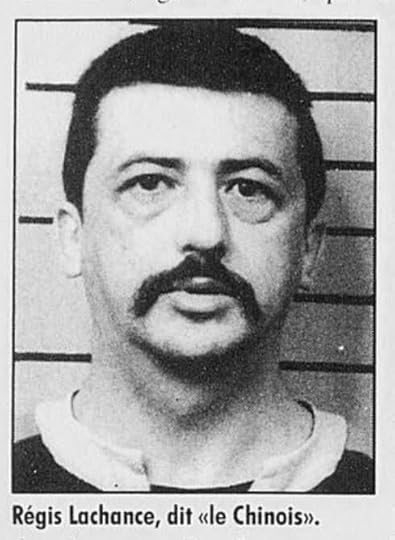
Certains voyaient Rancourt comme un «avocat de la pègre», l’un de ses amis les plus proches était Frank Shoofey, un autre avocat québécois qui a pris en charge le cas de Richard Blass, le gangster abattu lors d’une descente de police en 1975. Shoofey lui-même a été abattu en son cabinet d’avocats en 1985. Son meurtre reste non résolu. Rancourt a déjà représenté un type accusé d’avoir téléphoné menaçant au premier ministre René Lévesque. Il a même défendu Régis Lachance… l’autre Régis Lachance. C’est vrai, ils étaient deux. Régis “Le Chinois” Lachance était un motard Atomes qui, en 1982, a poignardé un client du Phil’s Diner sur la rue King Ouest à Sherbrooke pour avoir refusé de céder sa place au comptoir du lunch. Endroit difficile ce Quebexique.
Peu m’importe que Rancourt ait défendu des gangsters ou des policiers, même si l’on se demande si des puissances supérieures lui ont demandé de s’occuper de l’affaire Laplante (qui payait la facture ?). Peu m’importe qu’il ait été de l’autre côté dans l’affaire Rock Forest, c’est du business. Pour moi, Rancourt avait une passion et une détermination à extraire la vérité. Chacun a le droit de se défendre. Cela ne veut pas dire que Laplante était coupable des meurtres de Grimard / Bergeron au motif que la police croyait qu’il était responsable d’autres crimes. Ce n’est pas ainsi que fonctionne la justice. Si ce sont vos règles, alors la police est aussi mauvaise que les criminels, et elle l’était. Enfin, les policiers d’aujourd’hui – du moins ceux avec qui je communique à la Sûreté du Québec – tiennent Jean-Pierre Rancourt en haute estime, le considérant comme un formidable avocat.
Conclusion du procèsRégis Lachance s’est finalement présenté au tribunal, mais pas comme témoin dans le procès de Rancourt comme l’avait voulu l’avocat de la défense – Lachance était maintenant un témoin protégé pour la poursuite, le dernier témoin appelé à la barre le 14e jour du procès de Fernand Laplante. En effet, le juge de la Cour supérieure Paul Gervais a fait droit à une demande spéciale du procureur de la Couronne Claude Melancon de rouvrir le dossier de la Couronne à la lumière de ce nouveau témoin aux « preuves pertinentes ».
La majeure partie de son témoignage a couvert les événements entourant l’incendie du motel Aloha dont nous avons déjà parlé – comment Lachance a nié que la tentative d’incendie criminel était un coup monté par la police, dans le but d’obtenir une déclaration de Jean Charland qui incriminerait Fernand Laplante ( c’était exactement ça).
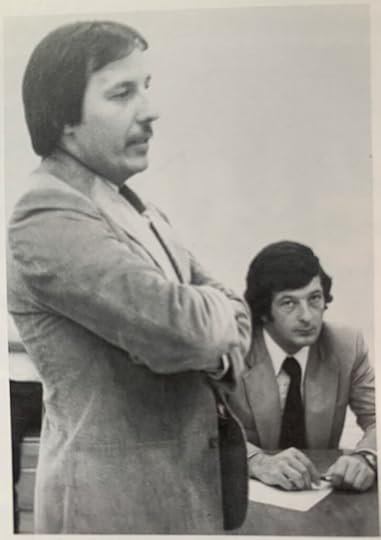 Jean-Pierre Rancourt lors du procès de Fernand Laplante, de « Les Confessions d’un Criminaliste », Bernard Tetrault, Stanke, 2015
Jean-Pierre Rancourt lors du procès de Fernand Laplante, de « Les Confessions d’un Criminaliste », Bernard Tetrault, Stanke, 2015À la barre, Lachance a déclaré que Laplante était venu chez lui, rue LaRocque, cet été-là après les meurtres. Alors que Lachance se tenait sur son balcon, Laplante, accompagné de sa femme, Claire Dussault, lui a crié dessus depuis sa cour en lui demandant de descendre parce qu’il avait des affaires à régler nous avec lui. Devant le refus de Lachance, Laplante et Dussault montent à son appartement. Lachance a demandé à Dussault de partir, ce qu’elle a fait. Puis selon Régis Lachance, Laplante a dit “il avait une grande gueule et que s’il ne la fermait pas, il lui arriverait la même chose qu’à Grimard et son chien.”
Je dirais qu’une conversation comme celle-ci aurait pu avoir lieu, mais dans l’autre sens, Lachance menaçant Laplante de se taire ou il serait tué. Car nous savons déjà que Régis Lachance était un menteur, il a menti lorsqu’il a déclaré qu’Aloha n’était pas une organisation policière. Ce qui est le plus important dans ce témoignage – nonobstant la comparaison effroyable de Manon Bergeron à un chien – ce sont deux choses : le fait fondamental que Laplante et Lachance se connaissaient, et que Régis Lachance habitait rue LaRocque. La rue LaRoque est à un pâté de maisons de l’endroit où Grimard et Bergeron ont été vus pour la dernière fois par Guy Robert, et à deux pâtés de maisons de l’emplacement de la rue Short où le chauffeur de taxi William Pettigrew a laissé sortir son passager tatoué – qui était Lachance – le matin de leurs meurtres.
En contre-interrogatoire, Régis Lachance a reconnu qu’il n’avait pas été arrêté par la police dans le cadre de l’enquête sur l’incendie criminel d’Aloha Motel. Jean-Pierre Rancourt a demandé à Lachance s’il s’était rendu au nouveau quartier général de la SQ sur Don Bosco avec l’enquêteur incendie Normand Plourde le 10 novembre pour rencontrer les enquêteurs avant l’incendie criminel. Lachance a dit non.
« Vous n’êtes pas allé à la SQ avec M. Plourde? », a encore demandé M. Rancourt.
Lachance a rétorqué : « Je vous ai dit non trois fois.
“Laplante aurait menacé Régis Lachance », La Tribune, 3 mai 1979, page 3
Et sur ce, Régis Lachance s’est éloigné de la barre des témoins. Plus tard dans la journée, Jean-Pierre Rancourt a tenté de le rappeler, mais Régis Lachance avait déjà quitté le palais de justice, se sentant apparemment suffisamment habilité pour faire ce qu’il voulait, quand il le voulait, même au mépris d’un processus pénal québécois.
La raison pour laquelle nous savons que Régis Lachance était un informateur de la police vient du récit suivant dans la biographie de Jean-Pierre Rancourt:
« J’ai remarqué que le sténographe judiciaire Robert Diorio, qui prenait des notes au procès, me regardait bizarrement. Il semblait troublé et j’ai deviné qu’il voulait me parler. Dès que le juge a ajourné pour une pause, je l’ai approché.
– Jean-Pierre, en écoutant le témoignage du témoin à charge, je me suis souvenu d’une scène dont j’ai été témoin par inadvertance et qui peut avoir un impact sur ce procès. J’ai vérifié mon calendrier pour être sûr.
De quoi parles-tu?
– L’incendie du motel Aloha s’est produit dans la soirée du 10 (novembre). Ce jour-là, j’avais pris des dispositions pour que le personnel du palais de justice visite le tout nouveau poste de police. Vers 16 ou 17 heures, j’ai vu entrer un inspecteur des incendies que je connais bien. Il était avec Régis Lachance, le témoin informateur, que je connais aussi bien, car c’est un client régulier des tribunaux. J’ai dit à l’enquêteur : « Avez-vous encore arrêté Régis ? Il a répondu, visiblement mal à l’aise : « Vous ne nous avez pas vus ici… » En toute conscience, je devais vous le faire savoir », dit Diorio, « mais nous nous comprenons, je ne vous ai rien dit… »
“Me Jean-Pierre Rancourt: Les Confessions d’un Criminaliste”, Bernard Tetrault, Stanke, 2015, Page 58
Rancourt a ignoré l’appel de Diorio à garder le silence et l’a quand même appelé à la barre. Diorio a réussi à faire savoir qu’il avait visité le nouveau quartier général avec d’autres employés du palais de justice en fin d’après-midi le 10 novembre et qu’il connaissait l’enquêteur des incendies Normand Plourde et un dénommé Régis Lachance. Mais lorsque Rancourt a demandé qui Diorio avait rencontré au poste de police, le procureur Claude Mélançon s’y est immédiatement opposé et le nom de Régis Lachance n’a jamais été entendu.

Lors d’une conversation avec Rancourt en 2020, l’ancien avocat m’a raconté comment Régis Lachance, “menti, menti, menti”. L’ouverture du nouveau quartier général de la Sûreté du Québec sur Don Bosco fait grand bruit à l’automne 1978. Des tournées régulières sont organisées tout au long du mois de novembre, comme celle décrite par Robert Diorio. Rancourt m’a raconté une deuxième rencontre avec Régis Lachance au quartier général peu après l’incendie d’Aloha. Un autre journaliste – qui était peut-être Jean Larose – a de nouveau vu Lachance avec des agents de la SQ et a sarcastiquement commenté : « Oh, vous l’avez arrêté », ce à quoi l’un des agents a aboyé : « Vous fermez votre gueule ».
La série de rencontres avec Lachance au quartier général de la police de Québec nous dit beaucoup de choses : d’abord, que ce n’était pas un grand secret que Lachance était un informateur ; deuxièmement, que la police n’était pas particulièrement attentive à garder le secret, ou avait un grand sentiment d’urgence à ce sujet ; et enfin, que Régis Lachance était capable de traverser les canaux de l’application de la loi et de la pègre avec un sens du droit, agissant avec la connaissance de la protection qui lui permettait de s’en tirer avec pratiquement n’importe quoi, peut-être même un meurtre.
Selon les mots de Rancourt, Régis Lachance « a été organisé par la SQ pour monter Charland », un d que c’est Charland « et un autre gars » qui ont tué Grimard et Bergeron, pas Laplante. Jean Pierre Rancourt m’a aussi raconté comment les violences physiques et les intimidations de la SQ n’étaient pas réservées uniquement aux interrogatoires. À plusieurs reprises au cours de la piste de Laplante, il rencontrait des agents dans la cage d’escalier de la cour et ils lui «donnaient l’épaule», c’est-à-dire le frôlaient physiquement au passage:
“Pendant que j’interrogeais le témoin à ce sujet, les policiers avaient des poignards dans les yeux. Et quand le sténographe judiciaire et moi marchions dans les couloirs plus tard, ils ont essayé de nous intimider, au point de nous tenir les jambes et de nous donner des coups d’épaule. J’ai même déposé une plainte officielle auprès du juge.
– Votre Honneur, depuis que nous avons dévoilé ces faits devant vous, nous nous sommes fait frapper dans les couloirs.
Mais il m’a ignoré.
– Allons, Maître Rancourt, vous ne pouvez pas être sérieux.
“Me Jean-Pierre Rancourt: Les Confessions d’un Criminaliste”, Bernard Tetrault, Stanke, 2015, Page 59
Ce n’était pas seulement une « preuve troublante de collusion », comme l’appelait Rancourt, c’était une preuve évidente que, comme Lachance, la Sûreté du Québec a également agi en toute impunité à l’époque de la fin des années 1970. S’ils ont coupé les coins ronds et poursuivi une fausse théorie dans l’enquête sur Grimard et Bergeron, à quel point auraient-ils pu être motivés pour mener une enquête appropriée sur une fille qui avait disparu et s’était retrouvée assassinée au cours de la même période après l’incendie d’Aloha en novembre au procès de Laplante au printemps 1979?
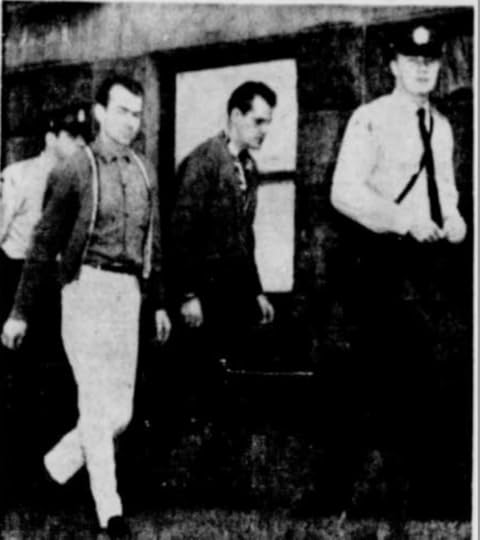 Regis Lachance à gauchePas de victoire
Regis Lachance à gauchePas de victoire« Vous, le jury, êtes composé de 12 personnes, cinq femmes et sept hommes, de tous horizons. Il est fort possible qu’il y en ait au moins un parmi vous qui comprenne au moins un peu la pègre. Peut-être avez-vous travaillé comme serveur comme je l’ai fait autrefois pendant mes études universitaires, dans un endroit où ce type de personnes se rencontrait. Si tel était le cas, je suis sûr que vous comprendriez que des crimes comme celui que nous examinons ici ne se déroulent pas tout à fait de la même manière que l’a déclaré le principal témoin à charge Jean Charland.
Jean-Pierre Rancourt, May 3, 1979
Dans son réquisitoire, Jean-Pierre Rancourt affirme catégoriquement que la version des faits de Jean Charland ne résiste pas à l’analyse et à la logique. Il a décrit le motard Gitans de 20 ans comme intrépide, et quelqu’un qui avait “exécuté des contrats à la pelle”. Il ne croit pas que Raymond Grimard soit un informateur de police et ne trouve pas crédible que « le loup » ait décidé de commettre un vol à deux heures du matin, après avoir refusé de commettre un vol de jour l’après-midi précédent. L’hypothèse selon laquelle Grimard et Bergeron auraient été tués ailleurs puis jetés à Astbury Road serait beaucoup plus conforme à la réalité. Rancourt a souligné le fait étrange, plutôt évident, mais souvent négligé, que le principal témoin de la Couronne, qui semblait déterminé à incriminer Laplante et se disait un spectateur innocent dans l’affaire, était également accusé de meurtre en relation avec le même crime. Rancourt a fait valoir que Charland avait intérêt à « blâmer Laplante pour le crime, à protéger d’autres inconnus ».

Il semble toujours que ce soient ces « inconnus » voilés dans ces affaires sherbrookoises. Rappelez-vous l’avertissement à la Cassandre de Madame Giguère à son mari, le meurtre de Rolland Giguère en 1969 selon lequel «les meurtriers avaient été protégés par certains individus au détriment des enquêteurs».
Après une rapide délibération de six heures par les sept hommes et cinq femmes du jury, le 7 mai 1979, Fernand Laplante, 34 ans, est reconnu coupable des meurtres de Raymond « le loup » Grimard et de Manon Bergeron survenus le 6 juillet à Ascot Township et condamné à l’emprisonnement à perpétuité par le juge de la Cour supérieure Paul-M. Gervais. Gervais a ajouté que la détention donnerait à Laplante le temps «d’expier ses fautes et de réfléchir à ses actes». Jean-Pierre Rancourt a immédiatement annoncé son intention de demander un nouveau procès. Claire Dussault Laplante a craché au visage de Jean Charland en quittant le palais de justice, ce qui semblait être le geste habituel pour la fin des procès à Sherbrooke.
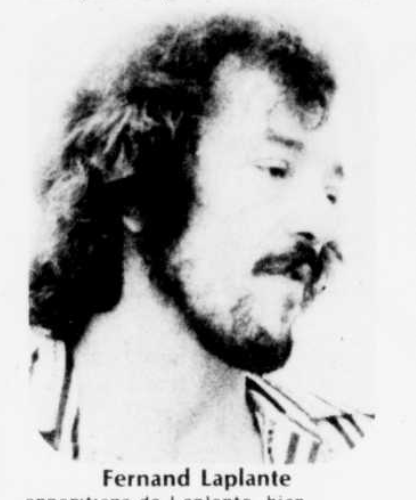 Fernand Laplante
Fernand LaplanteEn décembre 1979, la Cour suprême du Canada a rejeté l’appel de Rancourt et Fernand Laplante a été condamné à purger sa peine restante de 22 ans et demi avant d’être admissible à la libération conditionnelle. Quinze ans plus tard, faisant appel de son verdict de culpabilité, Fernand Laplante, contrit, a déclaré avoir «payé cher son manque de coopération» dans son processus criminel. En 2014, à l’âge de 70 ans, Fernand Laplante a obtenu sa libération conditionnelle totale. Sa localisation actuelle est inconnue.
Laplante a maintenu son innocence tout au long de son incarcération. Ce qu’il n’a pas fait, c’est de dire qui aurait pu assassiner Grimard et Bergeron. Laplante était innocent de ces crimes, mais il n’était pas un tabouret. On ne peut que penser que ces «inconnus» exerçaient une puissante influence sur Laplante et les Cantons-de-l’Est. Se sentait-il menacé s’il osait ouvrir la bouche ?
Bon VoyageNous avons parlé de la façon dont Jean Charland était un Gitans, ou un associé du clan des motards Gitans. Fernand Laplante était affilié avec leurs rivaux, les Atomes. Laplante était originaire de Coaticook (où Carole Fecteau est également née), et ce village au sud de Sherbrooke a toujours été connu sous le nom de gazon des Atomes (rappelez-vous que leur club-house a été incendié à Sainte Edwidge par les Gitans au début des années 1970 (voir carte) .
Les Atomes ont finalement été éradiqués par les Gitans au début des années 1980. Les Gitans ont ensuite rejoint les Hells Angels. La fin des années 70 et le début des années 80 ont vu une consolidation massive des gangs de motards basculer vers les Hells ou les Outlaws. Dans certains cas, des choix difficiles ont été faits. Ceux qui ne pouvaient pas changer leurs vieilles habitudes et apprendre à être des criminels discrets ont été éliminés. L’une des conséquences de ces choix difficiles fut le massacre au bunker de Lennoxville de plusieurs membres motards dans une embuscade le 25 mars 1985. Lorsque des corps commencèrent à flotter à la surface du fleuve Saint-Laurent, de nombreux Hells Angels furent arrêtés. Jean-Pierre Rancourt a représenté plusieurs de ces motards dont Georges Beaulieu, Charles Filteau, Louis Brochu, Yvon Tanguay et Guy Rodrigue. Si ces noms vous semblent familiers, ils devraient l’être. J’en ai parlé de plusieurs dans Les Motards de Sherbrooke, Boy-Boy Beaulieu dont nous avons parlé à plusieurs reprises, notamment dans le contexte de l’abbé Jean Salvail, le curé motard de Sherbrooke.
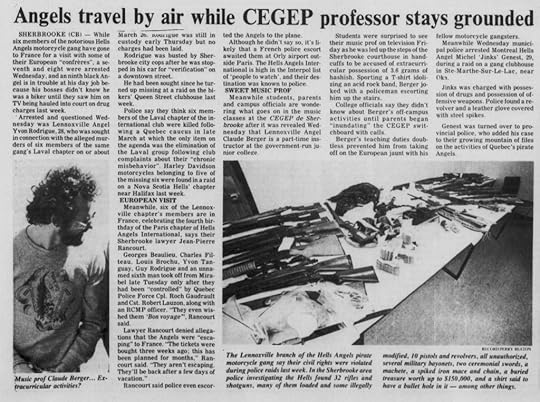 Sherbrooke Record, April 18, 1985
Sherbrooke Record, April 18, 1985Il y a un article drôle – pas si drôle – sur ces motards « fuyant à Paris » pendant leur procédure pénale pour des vacances, notre vieil ami, Caporal Roch Gaudreault de la SQ leur a même donné une escorte policière à l’aéroport de Mirabel et leur a souhaité « bon voyage .” C’est comme une version de Jean Charland en “assignation à résidence” chez ses parents uniquement sous stéroïdes – l’impunité accordée à ces criminels, leur permettant de mener leurs activités comme d’habitude en attendant d’éventuelles condamnations pour meurtre. Quelle chance avait une résolution du meurtre de ma sœur face à cela ?
Jean-Pierre Rancourt connaît peut-être bien des choses sur la pègre sherbrookoise des années 1970. Mais en tant qu’ancien avocat de la défense de nombreux acteurs de tous ces événements dont nous avons discuté, il est protégé, obligé par son secret professionnel. Espérons qu’un jour, d’une manière ou d’une autre, Maître Rancourt trouvera le moyen de partager son histoire complète et sans aucun doute fascinante.
The post Comment savons-nous que Régis Lachance était un stooler first appeared on Who Killed Theresa?.
May 16, 2022
Comment savons-nous que Régis Lachance était un stooler
En avril 2020, nous mettions la touche finale à Wish You Were Here. Je venais de faire la connaissance de Jean-Pierre Rancourt, l’avocat qui avait défendu Fernand Laplante, et j’avais hâte d’inclure ses propos sur l’affaire dans la version finale du livre. Jean-Pierre m’avait gracieusement envoyé un exemplaire de son livre, Confessions d’un Criminaliste, mais il n’était pas encore arrivé. Par des conversations téléphoniques, Rancourt m’a dit ce qu’il avait écrit dans le livre sur le procès ; comment c’était un coup monté et comment, à la dernière minute, la Couronne a appelé à la barre un informateur de la police qui a mis en péril toute son affaire. Il ne pouvait pas se rappeler le nom de l’informateur, mais il m’a assuré qu’il était dans le livre, et je l’aurais une fois qu’il serait arrivé.
Je voulais désespérément que l’informateur soit Luc Grégoire, le prédateur sexuel sherbrookois dont j’étais persuadé qu’il avait non seulement assassiné ma sœur Thérèse, mais qu’il était peut-être responsable du meurtre de Pou Camirand et de la mort de Manon Dubé, alors j’ai envoyé un courriel à Jean-Pierre et lui a demandé de répondre avec le nom. Tout cela était très dramatique, et il m’a donné l’impression qu’il était à quelques minutes de le récupérer. Incapable d’attendre, j’ai laissé échapper «Grégoire» dans un message électronique. Rancourt a répondu : « Non, je vais le trouver… Il s’appelle Régis Lachance »
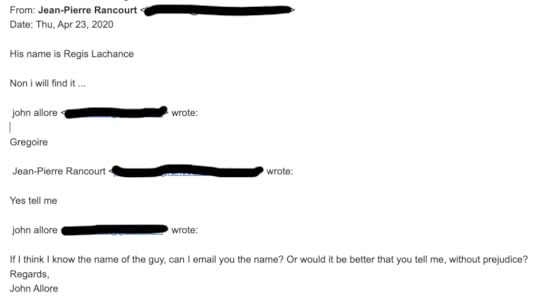
Je me sentais vaincu, comme si j’avais atteint une autre impasse. J’ai donc répertorié cette information, comme les 27 sachets de sauce soja à emporter que vous planquez dans le tiroir à ordures de votre cuisine parce que, on ne sait jamais. Il me faudrait encore un an pour réaliser que ce n’était pas la fin, c’était le début de la fin.
Un mot sur Jean-Pierre Rancourt. Il a travaillé sur des affaires controversées, notamment la défense de Claude Valence, la figure de proue de l’affaire d’enlèvement de Charles Marion en 1978. Il a représenté Guy Lafleur, membre du Temple de la renommée du hockey des Canadiens de Montréal, décédé récemment, dans une affaire complexe où Lafleur était accusé d’avoir aidé son fils, Mark, à se soustraire aux conditions de sa mise en liberté sous caution. Les lecteurs de ce site connaissent son nom puisqu’il a défendu la police de Sherbrooke dans l’affaire Rock Forest en 1983. Plus tard dans la vie, Rancourt a également pris le cas de l’agent 728, le policier de Montréal reconnu coupable d’avoir agressé des étudiants protestataires avec du gaz poivré en 2016.
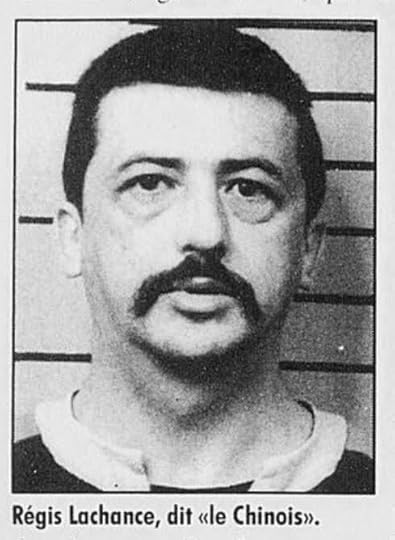 L’autre Regis Lachance
L’autre Regis LachanceCertains voyaient Rancourt comme un «avocat de la pègre», l’un de ses amis les plus proches était Frank Shoofey, un autre avocat québécois qui a pris en charge le cas de Richard Blass, le gangster abattu lors d’une descente de police en 1975. Shoofey lui-même a été abattu en son cabinet d’avocats en 1985. Son meurtre reste non résolu. Rancourt a déjà représenté un type accusé d’avoir téléphoné menaçant au premier ministre René Lévesque. Il a même défendu Régis Lachance… l’autre Régis Lachance. C’est vrai, ils étaient deux. Régis “Le Chinois” Lachance était un motard Atomes qui, en 1982, a poignardé un client du Phil’s Diner sur la rue King Ouest à Sherbrooke pour avoir refusé de céder sa place au comptoir du lunch. Endroit difficile ce Quebexique.
Peu m’importe que Rancourt ait défendu des gangsters ou des policiers, même si l’on se demande si des puissances supérieures lui ont demandé de s’occuper de l’affaire Laplante (qui payait la facture ?). Peu m’importe qu’il ait été de l’autre côté dans l’affaire Rock Forest, c’est du business. Pour moi, Rancourt avait une passion et une détermination à extraire la vérité. Chacun a le droit de se défendre. Cela ne veut pas dire que Laplante était coupable des meurtres de Grimard / Bergeron au motif que la police croyait qu’il était responsable d’autres crimes. Ce n’est pas ainsi que fonctionne la justice. Si ce sont vos règles, alors la police est aussi mauvaise que les criminels, et elle l’était. Enfin, les policiers d’aujourd’hui – du moins ceux avec qui je communique à la Sûreté du Québec – tiennent Jean-Pierre Rancourt en haute estime, le considérant comme un formidable avocat.
Conclusion du procèsRégis Lachance s’est finalement présenté au tribunal, mais pas comme témoin dans le procès de Rancourt comme l’avait voulu l’avocat de la défense – Lachance était maintenant un témoin protégé pour la poursuite, le dernier témoin appelé à la barre le 14e jour du procès de Fernand Laplante. En effet, le juge de la Cour supérieure Paul Gervais a fait droit à une demande spéciale du procureur de la Couronne Claude Melancon de rouvrir le dossier de la Couronne à la lumière de ce nouveau témoin aux « preuves pertinentes ».
La majeure partie de son témoignage a couvert les événements entourant l’incendie du motel Aloha dont nous avons déjà parlé – comment Lachance a nié que la tentative d’incendie criminel était un coup monté par la police, dans le but d’obtenir une déclaration de Jean Charland qui incriminerait Fernand Laplante ( c’était exactement ça).
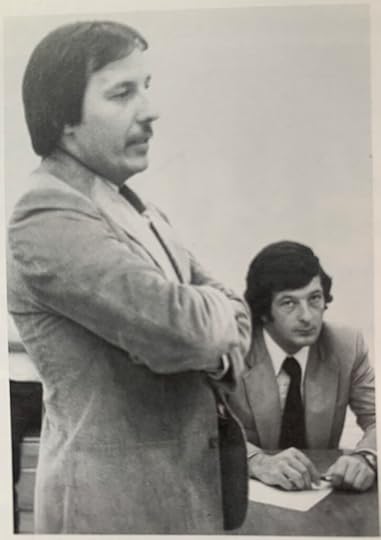 Jean-Pierre Rancourt lors du procès de Fernand Laplante, de « Les Confessions d’un Criminaliste », Bernard Tetrault, Stanke, 2015
Jean-Pierre Rancourt lors du procès de Fernand Laplante, de « Les Confessions d’un Criminaliste », Bernard Tetrault, Stanke, 2015À la barre, Lachance a déclaré que Laplante était venu chez lui, rue LaRocque, cet été-là après les meurtres. Alors que Lachance se tenait sur son balcon, Laplante, accompagné de sa femme, Claire Dussault, lui a crié dessus depuis sa cour en lui demandant de descendre parce qu’il avait des affaires à régler nous avec lui. Devant le refus de Lachance, Laplante et Dussault montent à son appartement. Lachance a demandé à Dussault de partir, ce qu’elle a fait. Puis selon Régis Lachance, Laplante a dit “il avait une grande gueule et que s’il ne la fermait pas, il lui arriverait la même chose qu’à Grimard et son chien.”
Je dirais qu’une conversation comme celle-ci aurait pu avoir lieu, mais dans l’autre sens, Lachance menaçant Laplante de se taire ou il serait tué. Car nous savons déjà que Régis Lachance était un menteur, il a menti lorsqu’il a déclaré qu’Aloha n’était pas une organisation policière. Ce qui est le plus important dans ce témoignage – nonobstant la comparaison effroyable de Manon Bergeron à un chien – ce sont deux choses : le fait fondamental que Laplante et Lachance se connaissaient, et que Régis Lachance habitait rue LaRocque. La rue LaRoque est à un pâté de maisons de l’endroit où Grimard et Bergeron ont été vus pour la dernière fois par Guy Robert, et à deux pâtés de maisons de l’emplacement de la rue Short où le chauffeur de taxi William Pettigrew a laissé sortir son passager tatoué – qui était Lachance – le matin de leurs meurtres.
En contre-interrogatoire, Régis Lachance a reconnu qu’il n’avait pas été arrêté par la police dans le cadre de l’enquête sur l’incendie criminel d’Aloha Motel. Jean-Pierre Rancourt a demandé à Lachance s’il s’était rendu au nouveau quartier général de la SQ sur Don Bosco avec l’enquêteur incendie Normand Plourde le 10 novembre pour rencontrer les enquêteurs avant l’incendie criminel. Lachance a dit non.
« Vous n’êtes pas allé à la SQ avec M. Plourde? », a encore demandé M. Rancourt.
Lachance a rétorqué : « Je vous ai dit non trois fois.
“Laplante aurait menacé Régis Lachance », La Tribune, 3 mai 1979, page 3
Et sur ce, Régis Lachance s’est éloigné de la barre des témoins. Plus tard dans la journée, Jean-Pierre Rancourt a tenté de le rappeler, mais Régis Lachance avait déjà quitté le palais de justice, se sentant apparemment suffisamment habilité pour faire ce qu’il voulait, quand il le voulait, même au mépris d’un processus pénal québécois.
La raison pour laquelle nous savons que Régis Lachance était un informateur de la police vient du récit suivant dans la biographie de Jean-Pierre Rancourt:
« J’ai remarqué que le sténographe judiciaire Robert Diorio, qui prenait des notes au procès, me regardait bizarrement. Il semblait troublé et j’ai deviné qu’il voulait me parler. Dès que le juge a ajourné pour une pause, je l’ai approché.
– Jean-Pierre, en écoutant le témoignage du témoin à charge, je me suis souvenu d’une scène dont j’ai été témoin par inadvertance et qui peut avoir un impact sur ce procès. J’ai vérifié mon calendrier pour être sûr.
De quoi parles-tu?
– L’incendie du motel Aloha s’est produit dans la soirée du 10 (novembre). Ce jour-là, j’avais pris des dispositions pour que le personnel du palais de justice visite le tout nouveau poste de police. Vers 16 ou 17 heures, j’ai vu entrer un inspecteur des incendies que je connais bien. Il était avec Régis Lachance, le témoin informateur, que je connais aussi bien, car c’est un client régulier des tribunaux. J’ai dit à l’enquêteur : « Avez-vous encore arrêté Régis ? Il a répondu, visiblement mal à l’aise : « Vous ne nous avez pas vus ici… » En toute conscience, je devais vous le faire savoir », dit Diorio, « mais nous nous comprenons, je ne vous ai rien dit… »
“Me Jean-Pierre Rancourt: Les Confessions d’un Criminaliste”, Bernard Tetrault, Stanke, 2015, Page 58
Rancourt a ignoré l’appel de Diorio à garder le silence et l’a quand même appelé à la barre. Diorio a réussi à faire savoir qu’il avait visité le nouveau quartier général avec d’autres employés du palais de justice en fin d’après-midi le 10 novembre et qu’il connaissait l’enquêteur des incendies Normand Plourde et un dénommé Régis Lachance. Mais lorsque Rancourt a demandé qui Diorio avait rencontré au poste de police, le procureur Claude Mélançon s’y est immédiatement opposé et le nom de Régis Lachance n’a jamais été entendu.
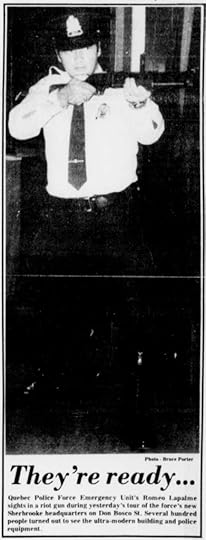
Lors d’une conversation avec Rancourt en 2020, l’ancien avocat m’a raconté comment Régis Lachance, “menti, menti, menti”. L’ouverture du nouveau quartier général de la Sûreté du Québec sur Don Bosco fait grand bruit à l’automne 1978. Des tournées régulières sont organisées tout au long du mois de novembre, comme celle décrite par Robert Diorio. Rancourt m’a raconté une deuxième rencontre avec Régis Lachance au quartier général peu après l’incendie d’Aloha. Un autre journaliste – qui était peut-être Jean Larose – a de nouveau vu Lachance avec des agents de la SQ et a sarcastiquement commenté : « Oh, vous l’avez arrêté », ce à quoi l’un des agents a aboyé : « Vous fermez votre gueule ».
La série de rencontres avec Lachance au quartier général de la police de Québec nous dit beaucoup de choses : d’abord, que ce n’était pas un grand secret que Lachance était un informateur ; deuxièmement, que la police n’était pas particulièrement attentive à garder le secret, ou avait un grand sentiment d’urgence à ce sujet ; et enfin, que Régis Lachance était capable de traverser les canaux de l’application de la loi et de la pègre avec un sens du droit, agissant avec la connaissance de la protection qui lui permettait de s’en tirer avec pratiquement n’importe quoi, peut-être même un meurtre.
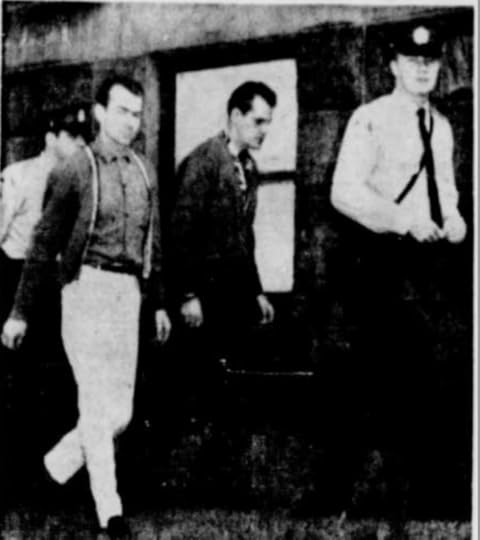 Regis Lachance à gauche
Regis Lachance à gaucheSelon les mots de Rancourt, Régis Lachance « a été organisé par la SQ pour monter Charland », un d que c’est Charland « et un autre gars » qui ont tué Grimard et Bergeron, pas Laplante. Jean Pierre Rancourt m’a aussi raconté comment les violences physiques et les intimidations de la SQ n’étaient pas réservées uniquement aux interrogatoires. À plusieurs reprises au cours de la piste de Laplante, il rencontrait des agents dans la cage d’escalier de la cour et ils lui «donnaient l’épaule», c’est-à-dire le frôlaient physiquement au passage:
“Pendant que j’interrogeais le témoin à ce sujet, les policiers avaient des poignards dans les yeux. Et quand le sténographe judiciaire et moi marchions dans les couloirs plus tard, ils ont essayé de nous intimider, au point de nous tenir les jambes et de nous donner des coups d’épaule. J’ai même déposé une plainte officielle auprès du juge.
– Votre Honneur, depuis que nous avons dévoilé ces faits devant vous, nous nous sommes fait frapper dans les couloirs.
Mais il m’a ignoré.
– Allons, Maître Rancourt, vous ne pouvez pas être sérieux.
“Me Jean-Pierre Rancourt: Les Confessions d’un Criminaliste”, Bernard Tetrault, Stanke, 2015, Page 59
Ce n’était pas seulement une « preuve troublante de collusion », comme l’appelait Rancourt, c’était une preuve évidente que, comme Lachance, la Sûreté du Québec a également agi en toute impunité à l’époque de la fin des années 1970. S’ils ont coupé les coins ronds et poursuivi une fausse théorie dans l’enquête sur Grimard et Bergeron, à quel point auraient-ils pu être motivés pour mener une enquête appropriée sur une fille qui avait disparu et s’était retrouvée assassinée au cours de la même période après l’incendie d’Aloha en novembre au procès de Laplante au printemps 1979?
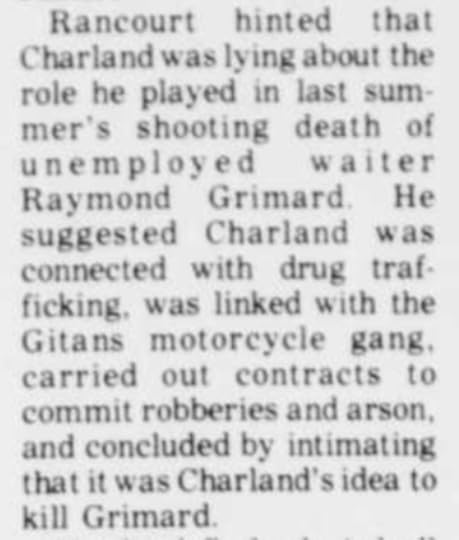 Pas de victoire
Pas de victoire« Vous, le jury, êtes composé de 12 personnes, cinq femmes et sept hommes, de tous horizons. Il est fort possible qu’il y en ait au moins un parmi vous qui comprenne au moins un peu la pègre. Peut-être avez-vous travaillé comme serveur comme je l’ai fait autrefois pendant mes études universitaires, dans un endroit où ce type de personnes se rencontrait. Si tel était le cas, je suis sûr que vous comprendriez que des crimes comme celui que nous examinons ici ne se déroulent pas tout à fait de la même manière que l’a déclaré le principal témoin à charge Jean Charland.
Jean-Pierre Rancourt, May 3, 1979
Dans son réquisitoire, Jean-Pierre Rancourt affirme catégoriquement que la version des faits de Jean Charland ne résiste pas à l’analyse et à la logique. Il a décrit le motard Gitans de 20 ans comme intrépide, et quelqu’un qui avait “exécuté des contrats à la pelle”. Il ne croit pas que Raymond Grimard soit un informateur de police et ne trouve pas crédible que « le loup » ait décidé de commettre un vol à deux heures du matin, après avoir refusé de commettre un vol de jour l’après-midi précédent. L’hypothèse selon laquelle Grimard et Bergeron auraient été tués ailleurs puis jetés à Astbury Road serait beaucoup plus conforme à la réalité. Rancourt a souligné le fait étrange, plutôt évident, mais souvent négligé, que le principal témoin de la Couronne, qui semblait déterminé à incriminer Laplante et se disait un spectateur innocent dans l’affaire, était également accusé de meurtre en relation avec le même crime. Rancourt a fait valoir que Charland avait intérêt à « blâmer Laplante pour le crime, à protéger d’autres inconnus ».
Il semble toujours que ce soient ces « inconnus » voilés dans ces affaires sherbrookoises. Rappelez-vous l’avertissement à la Cassandre de Madame Giguère à son mari, le meurtre de Rolland Giguère en 1969 selon lequel «les meurtriers avaient été protégés par certains individus au détriment des enquêteurs».
 Fernand Laplante
Fernand LaplanteAprès une rapide délibération de six heures par les sept hommes et cinq femmes du jury, le 7 mai 1979, Fernand Laplante, 34 ans, est reconnu coupable des meurtres de Raymond « le loup » Grimard et de Manon Bergeron survenus le 6 juillet à Ascot Township et condamné à l’emprisonnement à perpétuité par le juge de la Cour supérieure Paul-M. Gervais. Gervais a ajouté que la détention donnerait à Laplante le temps «d’expier ses fautes et de réfléchir à ses actes». Jean-Pierre Rancourt a immédiatement annoncé son intention de demander un nouveau procès. Claire Dussault Laplante a craché au visage de Jean Charland en quittant le palais de justice, ce qui semblait être le geste habituel pour la fin des procès à Sherbrooke.
En décembre 1979, la Cour suprême du Canada a rejeté l’appel de Rancourt et Fernand Laplante a été condamné à purger sa peine restante de 22 ans et demi avant d’être admissible à la libération conditionnelle. Quinze ans plus tard, faisant appel de son verdict de culpabilité, Fernand Laplante, contrit, a déclaré avoir «payé cher son manque de coopération» dans son processus criminel. En 2014, à l’âge de 70 ans, Fernand Laplante a obtenu sa libération conditionnelle totale. Sa localisation actuelle est inconnue.
Laplante a maintenu son innocence tout au long de son incarcération. Ce qu’il n’a pas fait, c’est de dire qui aurait pu assassiner Grimard et Bergeron. Laplante était innocent de ces crimes, mais il n’était pas un tabouret. On ne peut que penser que ces «inconnus» exerçaient une puissante influence sur Laplante et les Cantons-de-l’Est. Se sentait-il menacé s’il osait ouvrir la bouche ?
Bon VoyageNous avons parlé de la façon dont Jean Charland était un Gitans, ou un associé du clan des motards Gitans. Fernand Laplante était affilié avec leurs rivaux, les Atomes. Laplante était originaire de Coaticook (où Carole Fecteau est également née), et ce village au sud de Sherbrooke a toujours été connu sous le nom de gazon des Atomes (rappelez-vous que leur club-house a été incendié à Sainte Edwidge par les Gitans au début des années 1970 (voir carte) .
Les Atomes ont finalement été éradiqués par les Gitans au début des années 1980. Les Gitans ont ensuite rejoint les Hells Angels. La fin des années 70 et le début des années 80 ont vu une consolidation massive des gangs de motards basculer vers les Hells ou les Outlaws. Dans certains cas, des choix difficiles ont été faits. Ceux qui ne pouvaient pas changer leurs vieilles habitudes et apprendre à être des criminels discrets ont été éliminés. L’une des conséquences de ces choix difficiles fut le massacre au bunker de Lennoxville de plusieurs membres motards dans une embuscade le 25 mars 1985. Lorsque des corps commencèrent à flotter à la surface du fleuve Saint-Laurent, de nombreux Hells Angels furent arrêtés. Jean-Pierre Rancourt a représenté plusieurs de ces motards dont Georges Beaulieu, Charles Filteau, Louis Brochu, Yvon Tanguay et Guy Rodrigue. Si ces noms vous semblent familiers, ils devraient l’être. J’en ai parlé de plusieurs dans Les Motards de Sherbrooke, Boy-Boy Beaulieu dont nous avons parlé à plusieurs reprises, notamment dans le contexte de l’abbé Jean Salvail, le curé motard de Sherbrooke.
 Sherbrooke Record, April 18, 1985
Sherbrooke Record, April 18, 1985Il y a un article drôle – pas si drôle – sur ces motards « fuyant à Paris » pendant leur procédure pénale pour des vacances, notre vieil ami, Caporal Roch Gaudreault de la SQ leur a même donné une escorte policière à l’aéroport de Mirabel et leur a souhaité « bon voyage .” C’est comme une version de Jean Charland en “assignation à résidence” chez ses parents uniquement sous stéroïdes – l’impunité accordée à ces criminels, leur permettant de mener leurs activités comme d’habitude en attendant d’éventuelles condamnations pour meurtre. Quelle chance avait une résolution du meurtre de ma sœur face à cela ?
Jean-Pierre Rancourt connaît peut-être bien des choses sur la pègre sherbrookoise des années 1970. Mais en tant qu’ancien avocat de la défense de nombreux acteurs de tous ces événements dont nous avons discuté, il est protégé, obligé par son secret professionnel. Espérons qu’un jour, d’une manière ou d’une autre, Maître Rancourt trouvera le moyen de partager son histoire complète et sans aucun doute fascinante.
The post Comment savons-nous que Régis Lachance était un stooler first appeared on Who Killed Theresa?.
May 9, 2022
How we know Régis Lachance was a police informant
In April 2020, we were putting the finishing touches on Wish You Were Here. I had newly made the acquaintance of Jean-Pierre Rancourt, the lawyer who had defended Fernand Laplante, and I was eager to include his words about the case in the final draft of the book. Jean-Pierre had graciously mailed me a copy of his book, Confessions d’un Criminaliste, but it hadn’t arrived yet. Through telephone conversations, Rancourt told me what he had written in the book about the trial; how it was a set up, and how at the last minute the Crown called a police informant to the stand who jeopardized his whole case. He could not remember the name of the informant, but he assured me it was in the book, and I would have it once it arrived.
I desperately wanted the informant to be Luc Gregoire, the Sherbrooke sexual predator I was convinced had not only murdered my sister, Theresa, but may have been responsible for the murder of Louse Camirand and the death of Manon Dubé, so I emailed Jean-Pierre and asked him to respond with the name. This was all very dramatic, and he gave me the impression he was minutes away from retrieving it. Not able to wait, I blurted out, “Gregoire” in an email message. Rancourt responded, “Non, I will find it… His name is Regis Lachance”

I felt defeated, like I’d reached another dead end. So I catalogued this bit of information, like the 27 packets of take-out soy sauce you stash in your kitchen junk drawer because, you never know. It would take me another year to realize that this was not the end, it was the beginning of the end.
 The other Regis Lachance
The other Regis LachanceA word about Jean-Pierre Rancourt. He worked some controversial cases included the defense of Claude Valence, the lead figure in the 1978 Charles Marion kidnapping affaire. He represented Guy Lafleur, the Montreal Canadiens Hockey Hall of Famer who only recently died, in a complex case where Lafleur was accused of assisting his son, Mark in evading conditions of his bail. Readers of this site know his name, as he defended the Sherbrooke Police in the 1983 Rock Forest affaire. Later in life, Rancourt also took the case of Agent 728, the Montreal police officer convicted of assaulting protesting students with pepper spray in 2016.
Some saw Rancourt as an “underworld attorney”, one of his closest friends was Frank Shoofey, another Quebec lawyer who famously took the case of Richard Blass, the gangster gunned-down in a police raid in 1975. Shoofey himself was gunned-down in his law office in 1985. His murder remains unsolved. Rancourt once represented a guy accused of making a threatening phone call to Premier René Lévesque. He even defended Regis Lachance… the other Regis Lachance. That’s right, there were two of them. Regis “Le Chinois” Lachance was an Atomes biker who in 1982 stabbed a patron at Phil’s Diner on King Street West in Sherbrooke for refusing to give up his seat at the lunch counter. Tough place this Quebexico.
I don’t care that Rancourt defended mobsters or police, though there is some question as to whether higher powers asked him to handle the Laplante case (who was paying the bill?). It does not matter to me that he was on the other side in the Rock Forest affair, that’s business. For me, Rancourt had a passion and determination for extracting the truth. Everyone has the right to stand-up for themselves. It does not gibe that Laplante was guilty of the Grimard / Bergeron murders on the basis that police believed he was responsible for other crimes. That’s not the way justice works. If those are your rules, then the police are just as bad as the criminals, and they were. As a finally note, today’s police – at least the ones I communicate with in the Surete du Quebec – hold Jean-Pierre Rancourt in high regard, believing him to have been a formidable attorney.
Concluding the trialRégis Lachance finally showed up in court, but not as a witness in Rancourt’s process as the defense attorney had intended – Lachance was now a protected witness for the prosecution, the last witness called to the box on the 14th day of Fernand Laplante’s trial. In fact, Superior Court Judge Paul Gervais granted a special request made by Crown Prosecutor Claude Melancon to reopen the Crown’s case in light of this new witness with “pertinent evidence”.
Most of his testimony covered the events surrounding the Aloha Motel fire which we have already discussed – how Lachance denied that the arson attempt was a set-up by the police, with the goal of securing a statement from Jean Charland that would incriminate Fernand Laplante (it was exactly that).
 Jean-Pierre Rancourt during the trial of Fernand Laplante, de “Les Confessions d’un Criminaliste”, Bernard Tetrault, Stanke, 2015
Jean-Pierre Rancourt during the trial of Fernand Laplante, de “Les Confessions d’un Criminaliste”, Bernard Tetrault, Stanke, 2015On the stand, Lachance said that Laplante came to his home on Rue LaRocque that summer following the murders. As Lachance stood on his balcony, Laplante, accompanied by his wife, Claire Dussault, yelled up at him from his yard asking him to come down because he had business to discuss with him. When Lachance refused, Laplante and Dussault went up to his apartment. Lachance asked Dussault to leave, which she did. Then according to Regis Lachance, Laplante said ” he had a big mouth and that if he didn’t keep his mouth shut, the same thing would happen to him as to Grimard and his dog.”
I would argue that a conversation like this might have happened, but the other way around, with Lachance threatening Laplante to keep his mouth shut or he would be killed. For we already know Regis Lachance was a liar, he lied when he stated that Aloha was not a police set-up. What is most important in this testimony – not withstanding the the appalling comparison of Manon Bergeron to a dog – are two things: the fundamental fact that Laplante and Lachance knew each other, and that Regis Lachance lived on Rue LaRocque. Rue LaRoque is one block from the location where Grimard and Bergeron were last seen by Guy Robert, and two blocks from the Rue Short location where taxi driver William Pettigrew let out his tattooed passenger – who was Lachance – the morning of their murders.
In cross-examination, Regis Lachance acknowledged that he had not been arrested by the police in connection with Aloha Motel arson investigation. Jean-Pierre Rancourt asked Lachance if he had gone to the new SQ headquarters on Don Bosco with fire investigator Normand Plourde on November 10 to meet with investigators before the arson incident. Lachance said no.
“You didn’t go to the SQ with Mr. Plourde?”, asked Mr. Rancourt again.
Lachance retorted, “I’ve told you no three times.”
“Laplante aurait menacé Régis Lachance”, La Tribune, 3 Mai, 1979, Page 3
And with that Regis Lachance walked away from the witness stand. Later in the day, Jean-Pierre Rancourt attempted to call him back, but Regis Lachance had already left the court house, apparently feeling empowered enough to do as he wished, whenever he desired, even in defiance of a Quebec criminal process.
The reason we know Regis Lachance was a police informant comes from the following account in Jean-Pierre Rancourt’s biography:
“I noticed that the court reporter Robert Diorio, who was taking notes at the trial, was looking at me funny. He seemed troubled and I guessed he wanted to talk to me. As soon as the judge adjourned for a break, I approached him.
– Jean-Pierre, while listening to the testimony of the Crown witness, I was reminded of a scene I inadvertently witnessed that may have an impact on this trial. I checked my calendar to be sure.
– What are you talking about?
– The Aloha Motel fire occurred on the evening of (November) 10. On that day, I had arranged for the courthouse staff to visit the brand-new police station. At about 4 or 5 p.m., I saw a fire inspector I know well come in. He was with Régis Lachance, the informant witness, whom I also know well, because he is a regular client of the courts. I said to the investigator, “Did you arrest Régis again?” He replied, obviously uncomfortable: “You didn’t see us here…” In all conscience, I had to let you know”, said Diorio, “but we understand each other, I didn’t tell you anything…”
“Me Jean-Pierre Rancourt: Les Confessions d’un Criminaliste”, Bernard Tetrault, Stanke, 2015, Page 58

Rancourt ignored Diorio’s plea to keep things hush-hush and called him to the stand anyway. Diorio managed to get out that he had toured the new headquarters with other courthouse employees in the late afternoon of November 10, and that he knew the fire investigator Normand Plourde and a man named Régis Lachance. But when Rancourt asked who Diorio had met at the police station, prosecutor Claude Mélançon immediately objected and the name Regis Lachance was never heard.
In conversation with Rancourt in 2020 the former attorney told me how Regis Lachance, “lied, lied, lied”. The opening of the new Surete du Quebec Headquarters on Don Bosco was a big deal in the fall of 1978. There were regular tours conducted throughout the month of November, like the one described by Robert Diorio. Rancourt told me of a second encounter with Regis Lachance at the headquarters shortly after the Aloha fire. Another reporter – who may have been Jean Larose – again saw Lachance with SQ officers and sarcastically commented, “Oh you arrested him”, to which one of the officers barked, “You shut your mouth.”
The series of encounters with Lachance at the headquarters of the Quebec Police tells us many things: first, that it wasn’t any great secret that Lachance was an informer; second, that the police weren’t particularly careful in keeping it a secret, or had any great sense of urgency about it; and finally, that Regis Lachance was able to carry himself through channels of law enforcement and the underworld with a sense of entitlement, acting with the knowledge of protection that allowed him to get away with practically anything, maybe even murder.
 Regis Lachance à gauche
Regis Lachance à gaucheIn Rancourt’s words Regis Lachance “was organized by the SQ to set-up Charland”, and that it was Charland “and another guy” who killed Grimard and Bergeron, not Laplante. Jean Pierre Rancourt also told me how the physical abuse and intimidation by the SQ was not reserved only for interrogations. On several occasions during Laplante’s trail he would encounter officers in the court stairwell and they would “give him the shoulder”, meaning physically brush him as they passed by:
“While I was cross-examining the witness on this, the police officers had daggers in their eyes. And when the court reporter and I were walking the halls later, they tried to intimidate us, to the point of leg-holding and shoulder-poking. I even made a formal complaint to the judge.
– Your Honor, since we brought these facts out in front of you, we have been getting hit in the hallways.
But he ignored me.
– Come on, Maitre Rancourt, you can’t be serious.”
“Me Jean-Pierre Rancourt: Les Confessions d’un Criminaliste”, Bernard Tetrault, Stanke, 2015, Page 59
This was not only “disturbing evidence of collusion”, as Rancourt called it, it was clear evidence that, like Lachance, the Surete du Quebec also acted with total impunity in the era of the late 1970s. If they cut corners and pursued a bogus theory in the investigation of Grimard and Bergeron, just how motivated could they have been to provide a proper investigation for girl who had gone missing and turned up murdered over the same time frame from the Aloha fire in November to Laplante’s trial in the spring of 1979?
 No victory
No victory“You, the jury, are composed of 12 people, five women and seven men, from every walk of life. It is very possible that there is at least one among you who understands the underworld at least a little. Perhaps you worked as a waiter as I once did during my college days, in a place where these type of people met. If such was the case, I am sure you would understand that crimes such as the one we are considering here don’t take place quite the same way as the chief witness for the Crown Jean Charland declared.”
Jean-Pierre Rancourt, May 3, 1979
In his closing arguments, Jean-Pierre Rancourt stated flat that Jean Charland’s version of events did not stand up to analysis and logic. He described the 20-year-old Gitans biker as fearless, and someone who had “executed contracts by the shovelful”. He did not believe Raymond Grimard to be a police informer, and did not find it credible that “le loup” would decided to commit a theft at two in the morning, after refusing to commit a daytime robbery on the previous afternoon. The hypothesis that Grimard and Bergeron were killed elsewhere and then dumped at Astbury Road would be much more consistent with reality. Rancourt pointed out the strange, rather obvious, but often overlooked fact that the Crown’s chief witness, who seemed bent on incriminating Laplante, and said he was an innocent spectator in the affair, was also accused of murder in connection with the same crime. Rancourt argued that Charland had an interest in “blaming Laplante for the crime, in protecting other unknown persons”.
It always seems to be these veiled “unknown persons” in these Sherbrooke affairs. Remember Madame Giguere’s Cassandra-like warning of her husband, Rolland Giguere’s 1969 murder that “ the murderers had been protected by certain individuals to the detriment of the investigators.”
 Fernand Laplante
Fernand LaplanteAfter a swift six-hours of deliberation by the seven men and five women jury, on May 7, 1979, 34-year-old Fernand Laplante was found guilty of the murders of Raymond “le loup” Grimard and Manon Bergeron on July 6 in Ascot Township and sentenced to life imprisonment by Superior Court Judge Paul-M. Gervais. Gervais added that detention would allow Laplante the time “to expiate his faults and reflect on his actions.” Jean-Pierre Rancourt immediately announced his intention to request a new trial. Claire Dussault Laplante spat in the face of Jean Charland as she left the courthouse, which appeared to be the customary gesture for the ending of trials in S-Town.
In December 1979, the Supreme Court of Canada turned down Rancourt’s appeal, and Fernand Laplante was ordered to serve his remaining 22 and one-half year sentence before parole eligibility. Fifteen years later appealing his guilty verdict, a contrite Fernand Laplante said he “had paid dearly for his lack of cooperation” in his criminal process. In 2014, at the age of 70, Fernand Laplante was granted full parole. His current whereabouts are unknown.
Laplante maintained his innocence throughout his incarceration. What he did not do was offer any statement of who may have murdered Grimard and Bergeron. Laplante was innocent of these crimes, but he was no stoolie. You can only think that those “unknown persons” held powerful influence over Laplante and the Eastern Townships. Did he feel threatened if he dared to open his mouth?
Bon VoyageWe have talked about how Jean Charland was a Gitans, or an associate of the Gitans biker clan. Fernand Laplante was affiliated with their rivals, the Atomes. Laplante was from Coaticook (where Carole Fecteau was also born), and this village to the south of Sherbrooke has always been known as Atomes turf (remember their clubhouse was burned down there in Sainte Edwidge by the Gitans in the early 1970s – see map).
The Atomes were eventually eradicated by the Gitans in the early 1980s. The Gitans then patched over into the Hells Angels. The late ’70s and early 1980s saw a mass consolidation of biker gangs flipping over to either the Hells or Outlaws. In some cases hard choices were made. Those who could not change old habits and learn to be discrete criminals were eliminated. One of the outcomes of these hard choices was the massacre at the Lennoxville bunker of several biker members in an ambush on March 25, 1985. When bodies started floating to the surface of the Saint Lawrence River, many Hells Angels were arrested. Jean-Pierre Rancourt represented several of those bikers including Georges Beaulieu, Charles Filteau, Louis Brochu, Yvon Tanguay, and Guy Rodrigue. If these names sound familiar to you, they should. I wrote about several of them in The Bikers of Sherbrooke, Boy-Boy Beaulieu we discussed several times, particularly in the context of Father John Salvail, the biker priest of Sherbrooke.
 Sherbrooke Record, April 18, 1985
Sherbrooke Record, April 18, 1985There’s a funny – not so funny – article about these bikers “escaping to Paris” during their criminal process for a vacation, our old friend, Corporal Roch Gaudreault of the SQ even gave them a police escort to Mirabel Airport and wished them “Bon Voyage.” This is like a version of Jean Charland under “house arrest” at his parents only on steroids – the impunity that these criminals were granted, enabling them to conduct business as usual while awaiting possible murder convictions. What chance did a resolution of my sister’s murder have in the face of this?
Jean-Pierre Rancourt may know many things about the Sherbrooke underworld in the 1970s. But as the former defense attorney of many of the players in all these events we have discussed, he is protected, obligated by his attorney-client privilege. Hopefully, one day, in some fashion, Maitre Rancourt will find a way to share his complete, and no doubt fascinating story.
The post How we know Régis Lachance was a police informant first appeared on Who Killed Theresa?.
May 7, 2022
The Trial of Fernand Laplante
The first degree murder trial of Fernand Laplante opened the week after Theresa Allore’s body was found in a Compton, Quebec culvert on Good Friday April 13, 1979. Many officers of the Surete du Quebec called to testify were the same officers doing the grunt-work on Theresa’s case; knock-and-talks, preliminary interviews, filing paper work. How many of them made the connection that the answers to the Compton murder were contained in the criminal process that was unfolding in the Sherbrooke court?
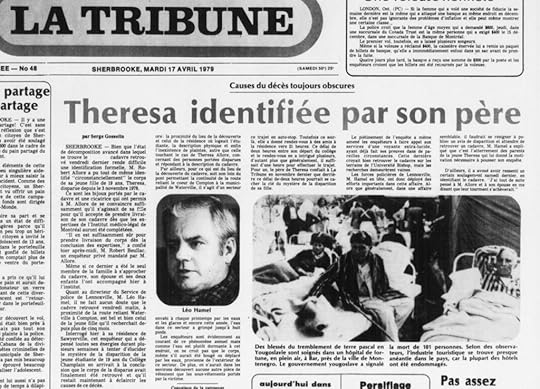
As lawyers prepared to make their arguments, my parents were ordering Theresa’s white coffin and making funeral arrangements. The judge and jury settled in to listen to the evidence; we were on Decarie Boulevard in Montreal picking up Theresa bicycle which had been in a shop all winter for repairs. As we ate an early supper at Piazza Tomasso’s and I later cried in my mother’s arms in the restaurant parking lot, the prosecution’s star witness, Charland approached the stand. This is what Charland told the court happened to Raymond Grimard and Manon Bergeron the night they were murdered on or about July 6, 1978 south of Lennoxville:
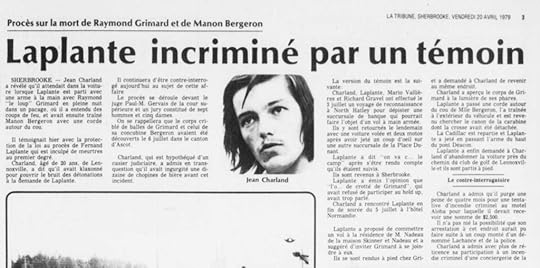
Charland, Laplante, Mario Vallières and a man named Richard Gravel made a scouting trip to North Hatley on July 3, 1978 to scope out a bank branch they had targeted for an armed robbery. They returned the next day with a stolen car and two motorcycles after checking out another branch in South Sherbrooke. Fernand Laplante realized they had been followed when he spotted agent Réal Châteauneuf and his SQ entourage lurking nearby, telling the guys, “we’re getting the fuck out of here:”
Back in Sherbrooke, according to Charland, Larplante expressed the opinion it was “that piece of shit Grimard” who narced on them, shouting that he had refused to participate in the hold-up and as a general rule “talked too much”.
On the evening of July 5, Charland and Laplante met at the Moulin Rouge / Hotel Normandie where Laplante now proposed to commit a robbery at the residence of Mr. Nadeau on Chemin Astbury, South of Lennoxville, and suggested that they invite Grimard to join them.
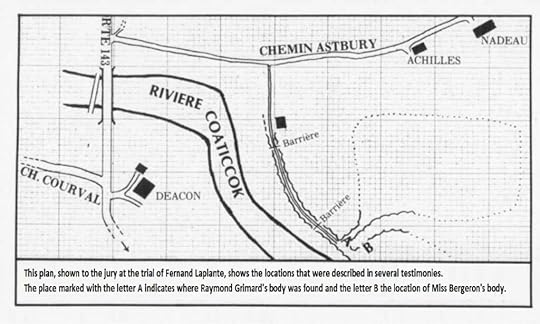
They walked to Grimard’s house around 2:00 a.m., and Laplante spoke with “Le Loup” Grimard in his room. Laplante, Charland, Grimard, and his girlfriend, Manon Bergeron left together in Grimard’s Cadillac, the one registered in Bergeron’s name.
Charland stopped by his parent’s house in Lennoxville to pick up a rifle he said belonged to Laplante. They then drove to Astbury Road. Once there, they realized that Charland had left the magazine cartridge for the rifle back in Lennoxville. Everyone got back in the car and returned to Lennoxville.
Back at Astbury Road, Laplante and Grimard got out of the Cadillac. Laplante told Charland, “if you hear gunshots, honk on the car horn.” According to Charland this would have been to mask the sound of the gunshots. Moments later, Charland said he heard gunshots so he honked the horn.
Laplante returned alone and only then did Manon Bergeron ask what had happened. As Charland drove away – remember here, Charland is the wheel man – Bergeron started screaming that she wanted to get out. Laplante then hit Bergeron and instructed Charland to return to Astbury Road. Once there, Charland said he could see from his headlights Grimard’s body lying in the pasture. Laplante put a cord around Manon Bergeron’s neck, dragged her out of the vehicle and returned to get the rifle barrel, the stock of which had been detached. According to Charland, Fernand Laplante then beat Manon Bergeron to death using the rifle barrel.
Laplante returned, and he and Charland drove off. When the Cadillac reached the Deacon Bridge at Route 143, Laplante threw the rifle into the Coaticook River. Laplante told Charland to abandon the Cadillac at the Lennoxville Golf Club. Laplante and Charland then headed toward the town of Lennoxville on foot.
Hashtag “Nude Bathing”. Not since Fibber McGee has such a tall tale been weaved.
“Which version is the real one?“In his cross-examination, defense attorney Jean-Pierre Rancourt got Charland to admit the attempted arson at the Aloha Motel, and his arrest at the scene was the result of “a setup by a man named Lachance and the police.” Jean-Pierre Rancourt then suggested something very interesting. He asked Charland if he did not find it curious that Grimard refused to participate in an afternoon bank robbery, yet agreed to commit a hold-up in the middle of the night at a private residence? He then argued that Charland had gone alone to Grimard’s house the night of the murders, that there had been, in fact two vehicles that night, that there were six people at Astbury Road, not four (do the math; two victims, two cars, and four other individuals).
While in custody after the summer murders, Charland had bragged how he had “peppered Grimard” with bullets. Rancourt suggested Charland had never worked an honest day in his life – how as a member of the Gitans gang, he was accustomed to accepting contract payments for jobs, like the $2,500 for the Aloha job. Rancourt asked him directly, “Did you have a contract to get Grimard and Miss Bergeron out?” Charland stated he did not, but he then admitted, “there had been talk of making $1,000 to $1,500 quickly in the Lennoxville end.”
Apparently no one could keep a secret in small-town Sherbrooke. SQ Agent Noel Bolduc had also heard through an informant that a hit was being planned for July 4 at some location in the area. This is odd, This informant wouldn’t be Grimard. You don’t say, “there’s going to be a hit and the hit will be on me”. It’s not, “I am Spartacus”. And if Bolduc knew of the hit in advance of the murders, why not take action to prevent it? Unless of course you decide to turn a blind eye to it. Just exactly who was this other informant anyway?
On the question of Carol Fecteau (remember her?), Charland admitted that he lied to police and the coroner during their investigations into her death saying he knew nothing. Charland admitted that Fecteau had mentioned to him the possibility of filing a complaint with the police following the theft of a Helen Larochelle’s car in which he was involved while on probation. Charland added that he confided to Laplante about Fecteau who allegedly told him that he might have “done it.” Only after the Aloha Motel incident did Charland then given a statement incriminating Laplante. “Which version is the real one?” asked attorney Rancourt? Charland replied that he was now telling the truth in court:
Road Trip“I have one last question. Mr. Charland, isn’t it true to say that you are a liar?
Yes, that’s right!
I should have asked you in the first place!”
Charland nodded.
“Me Jean-Pierre Rancourt: Les Confessions d’un Criminaliste”, Bernard Tetrault, Stanke, 2015, Page 59
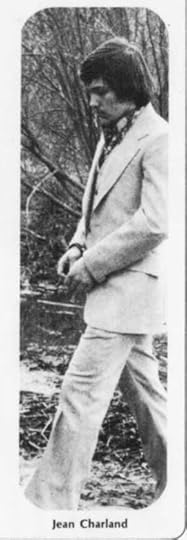
On April 23, 1979 the court took a field trip to the site where the bodies of Grimard and Bergeron were discovered. The photographs from La Tribune of this event are surreal, with the accused, Fernand Laplante strolling through country fields along side Jean Charland and the seven-man – five-woman jury, like some bellicose Renn festival. The jury had been bused out on on a charter supplied from the Department of Justice. Court reporter Jean Larose brought along a folding chair to add to the picnic atmosphere.
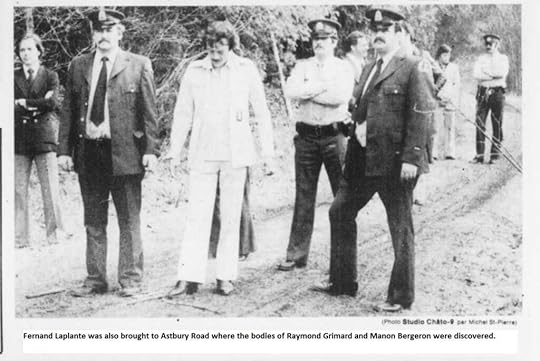
Jean Charland was asked to point out the location where the bodies were found. He did so. He was asked where the Cadillac was parked when the bodies were disposed off. He did this too. That’s really all Charland could possibly tell the jury about the dump site as everyone knew Grimard and Bergeron were not murdered at this location as he had testified under oath.
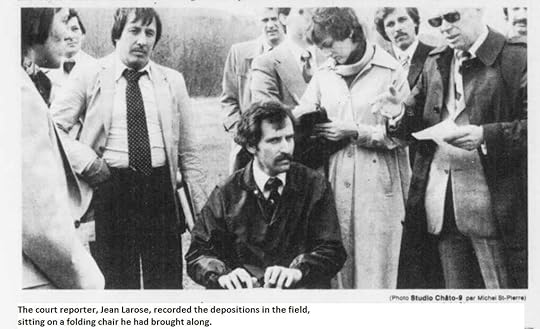 Jean Larose, with Jean-Pierre Rancourt behind his right shoulder“Basically, is this a normal police thing?”
Jean Larose, with Jean-Pierre Rancourt behind his right shoulder“Basically, is this a normal police thing?”When police took the stand in Fernand Laplante’s trial, the jury learned that there were no bullets fired at the Astbury Road location, and no rifle had been tossed into the Coaticook River.
Sgt. Maurice Corbeil of the SQ testified that six police officers combed the trail, fields, undergrowth, and brush in the area on July 6 without finding any spent cartridges. Officer Ronald Cyr said his scuba diving squad searched on August 8 and 9, and again on November 27 and 28, and did not turn up any weapons above or below the Deacon Bridge. Cpl. André Vallée added that further searches of the river on September 18 and 19 recovered a piece of weight with dimensions equivalent to a firearm thrown off the bridge by Constable Noël Bolduc in an experiment to see how far a rifle might travel in the Coaticook running water. Meaning the dummy rifle was recovered, but not an actual rifle, because Fernand Laplante had never disposed of a rifle as Jean Charland had testified.
When officer Réal Chateauneuf took the stand he reaffirmed that he did not find any cartridges near Grimard’s body. Chateauneuf told Rancourt that there may have been blood on the ground but he did not notice that. “It would be important to know that to determine if Grimard was killed there or elsewhere,” suggested Rancourt (no shit, like one of the most fundamental points of, you know, being an investigator). At this point Chateauneuf offered the, “you should talk to my supervisor” tractic, like some genuflecting call center fonctionnaire, saying he had no theory on the subject and that is was Constable Noël Bolduc’s investigation, so the question should be put to him.
Rancourt asked Chateauneuf why Jean Charland had initially denied knowing anything about the murder of Carole Fecteau, and only gave a statement incriminating Laplante in her murder after the Aloha fire when Sergeant Pierre Marcoux had alluded Laplante had blamed Charland for her murder, which wasn’t true. “Basically, is this a normal police thing?” asked Rancourt. Officer Chateauneuf admitted that it was done from time to time. Chateuaneuf then denied that the arrest of Charland on November 11 near the Aloha Motel was a set-up organized by the police.
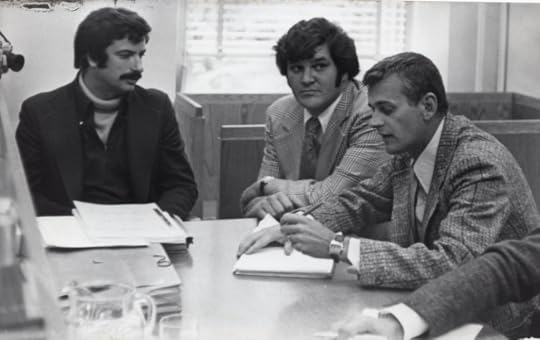 Agents Noel Bolduc, Réal Châteauneuf, and Crown prosecutor, Michel Côté
Agents Noel Bolduc, Réal Châteauneuf, and Crown prosecutor, Michel Côté
It was officer Réal Châteauneuf who found $19 and a piece of paper on Grimard’s body with the phone number of “Tricia Hall” or Patrick Hall from the Sûreté du Québec. Remember that this was the piece of evidence that lead to the speculation that Raymond Grimard was a police informant. An associate with a firm knowledge of the criminal underworld in Sherbrooke commented, “that seems too much, too obvious”. I suggest to you that this piece of paper was planted on Grimard’s body by the SQ as a means of providing a motive for the murders, and to disguise the identity of the real police informer.
What were they doing under that bridge?Residents of the homes in the area of the dump site at Astbury Road were questioned as to what they saw or heard in the early morning of July 6. Mr. Arnold Deacon, and his daughter Terry, reported they were awakened by their barking dog at their home near the Deacon Bridge. The Deacons heard horns possibly coming from Astbury Road, while a second vehicle was parked at the corner of Courval Road and Route 143. Ms. Deacon suggested that the exchange of horns at both locations was the signaling of the two vehicles. So they heard horns and a dog, but no gunshots.
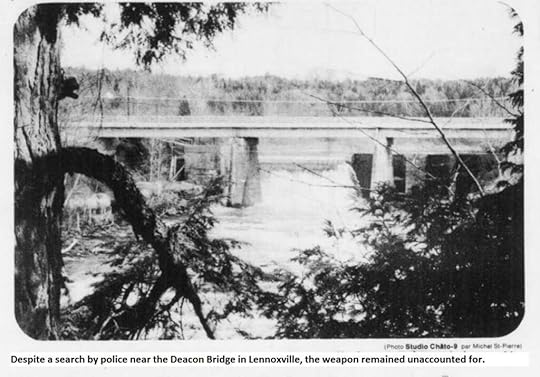 The Deacon Bridge crossing the Coaticook River on Route 143
The Deacon Bridge crossing the Coaticook River on Route 143The Deacons observed a car similar to Grimard’s Cadillac traveling a few times between Courval Road and Astbury Road. They added that they also saw a man wearing gloves who approached the Deacon Bridge on foot and appeared to be talking to someone below the bridge. They did not notice anything being thrown into the river. What were they doing under that bridge?
During the coroner’s inquiry which had occurred in the fall of 1978, Constable Michel Poulin reported he had photographed three different tracks of people under this bridge on July 7th. None of them matched the shoes of Fernand Laplante which were eventually confiscated for the criminal process. This information never made it to trail. It is also worth noting that Poulin found four identifiable fingerprints on the body of the Cadillac recovered at the Lennoxville Golf Course. The prints did not match Laplante’s. This information also did not make it to trial.
Helen Achilles, who lived on Astbury Road couldn’t sleep that night because of the heat. She testified that she saw a blue car drive by twice on Astbury Road. She noted that this vehicle honked its horn as it drove down the hill. Helen Achilles did not hear any gunshots that night.
Later that summer, Attorney Jean-Pierre Rancourt had a private detective conduct an experiment. While Robert Beullac sat inside with Helen Achilles in her Astbury home, he had his detective associate fire nine rounds from a .22 semi-automatic rifle down the hill at Astbury while another associate honked a car horn. Beullac and Miss Achilles easily heard the horn and the shotgun. It should also be noted that the detectives easily recovered their shell casings.
Key witness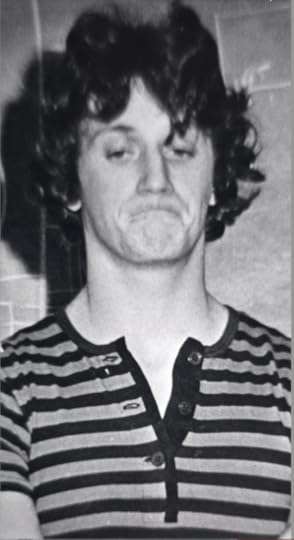 Luc Landry
Luc LandryOn Friday, April 27, 1979, defense attorney Jean-Pierre Rancourt called 20-year-old Luc Landry to the stand. Landry revealed that in a conversation at the Moulin Rouge in the summer of 1978, Jean Charland told him how “he riddled a guy behind the garbage cans on Wellington Street”, and that Raymond “the Wolf” Grimard was actually a “stooge” working for the police. At the time of his testimony, Landry was serving a two-and-a-half-year sentence for theft and his parole eligibility was fast approaching.
Landry had originally been approached by agents Bolduc and Châteauneuf of the SQ who asked him if he wanted to testify against Laplante, bargaining that they could possibly get him out early. When Landry told them his story, they changed their minds and told Landry to “stay out of it”, now insinuating that they could make things go wrong for his parole. Landry related how Bolduc and Châteauneuf punctuated their words “with kicks and punches”. We now can see that this was not the behavior of a few ‘bad apples’ but an institutionalized approach used by Quebec’s provincial police force. Beatings were administered not only to players in the criminal underworld like Landry, Laplante, and Claire Dussault-Laplante, but also regular civilians like the hotelier, Paul Bergeron.
“He had a tattoo on each of his arms“Pettigrew’s Taxi Stand was located along Queen Street in Lennoxville, across from The Georgian Hotel, and just down the street from the restaurant, Chez Charles / Disco Bob’s, the place owned by Yvan Charland, Jean Charland’s father. In the early hours of the morning of July 6, 1978, owner William Pettigrew was pulling the night shift when he saw two figures walking towards his cab coming from the direction of the Lennoxville Golf Course.
 Lennoxville Radio Taxi – William Pettigrew
Lennoxville Radio Taxi – William PettigrewOne passanger was Jean Charland, and Pettigrew noted he was wearing gloves. The second passenger Pettigrew described as “quite tall, with fairly long ash-blond hair and sideburns. And he had a tattoo on each of his arms.“
Pettigrew made two stops. The first was to Charland’s home, or rather his parents’ home, located at 26 Rue Champigny, in a suburban neighborhood north of the Saint Francois River, less than 2 kilometers from the Champlain College campus. After dropping Charland off, he then took the second passenger to the corner of Belvedere and Short Streets in Sherbrooke. It is true that Fernand Laplante once lived on Belvedere, a few blocks north of Short Street. But as we have seen, others also lived in this neighborhood, notably Luc Gregoire and Carole Fecteau, and an Atomes gang clubhouse was located nearby on Wellington.
What Laplante didn’t have were tattoos. In court, Defense Attorney Jean Pierre Rancourt dramatically asked his client to stand up from the defendant’s box and remove his jacket. Laplante did so, revealing his bare arms. The court went silent. It was at this point that Rancourt felt his case was no longer in doubt. The jury seemed shaken. The Crown and police officers were stunned.
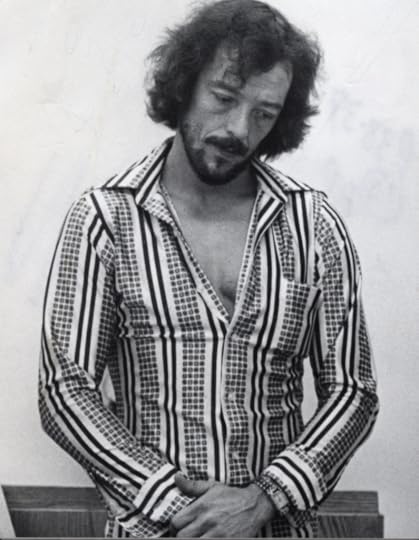 Fernand Laplante looking like Christ before the cross.
Fernand Laplante looking like Christ before the cross.Under cross-examination, William Pettigrew mentioned that Officer Noël Bolduc of the Sûreté du Québec had shown him a series of mugshots. Pettigrew did not identify Laplante or Charland who were both in the deck. Bolduc suggested that this meant Pettigrew was unsure of exactly who was in his cab the morning of July 6, but I believe it meant something else. Pettigrew was a reluctant witness. He probably had no desire to finger a member of the Gitans and his accomplice. Because everyone in that court room knew exactly who was tall, with long ash-blond hair and sideburns, and a tattoo on each of his arms. Attorney Jean Pierre Rancourt knew it. The Crown, the Judge, the officers of the Sûreté du Québec, they all knew it too. It was Regis Lachance.
Think of it. Who did contract jobs with Jean Charland, who worked with partners? Regis Lachance. Who was accustomed to taking taxis from the scene of a crime? Regis Lachance. In 1978, Lachance had had long, blondish hair. He was “tallish”. His family says he had tattoos on his forearms, one was a devil.
In Kentucky Fried Murder!, about the 1969 unsolved murder of Rolland Giguere I wrote:
“Once again, it wasn’t Yvon Charland’s sons who murdered Rolland Giguere. But is it possible that there were longstanding associations with criminal elements in Sherbrooke within the Charland family? Was Rolland Giguere’s murder just a crime of opportunity, or was it a planned action to eliminate the competition? And competition for what – Fried chicken? Restaurant domination? Something more?”
Regis Lachance was exactly the person I had in mind in that case. He is exactly the “potential suspect now in his late 60s [who] was encountered in this case” – the one I imagined the Sherbrooke police had interrogated in their 2004 re-opening of the Giguere investigation. In fact, La Tribune reported that investigators met with two potential suspects. Who was the other guy?
Call the witnessOn Monday, April 30, Jean-Pierre Rancourt called his final witness to the stand. Régis Lachance did not answer the call. Lachance was under court order to appear. Police could not find him. The bailiff, Claude Bolduc reported that he had tried three times to serve a subpoena to Régis Lachance, and that he finally had to give the document to his wife. Régis Lachance had gone AWOL.
The post The Trial of Fernand Laplante first appeared on Who Killed Theresa?.
May 6, 2022
Le procès de Fernand Laplante
Le procès pour meurtre au premier degré de Fernand Laplante s’est ouvert la semaine suivant la découverte du corps de Theresa Allore dans un ponceau de Compton, au Québec, le vendredi saint 13 avril 1979. De nombreux agents de la Sûreté du Québec appelés à témoigner étaient les mêmes agents qui faisaient le travail de grognement. sur le cas de Theresa ; “knock-and-talks”, entretiens préliminaires, dépôt de documents. Combien d’entre eux ont fait le lien que les réponses au meurtre de Compton étaient contenues dans le processus criminel qui se déroulait au tribunal de Sherbrooke?

Alors que les avocats se préparaient à présenter leurs arguments, mes parents commandaient le cercueil blanc de Theresa et organisaient les funérailles. Le juge et le jury se sont installés pour écouter les preuves; nous étions sur le boulevard Décarie à Montréal pour récupérer le vélo de Theresa qui avait été dans un magasin tout l’hiver pour des réparations. Alors que nous dînions tôt chez Piazza Tomasso et que je pleurais plus tard dans les bras de ma mère sur le parking du restaurant, le témoin vedette de l’accusation, Charland, s’est approché de la barre.
Voici ce que Charland a dit à la cour qui est arrivé à Raymond Grimard et Manon Bergeron la nuit où ils ont été assassinés le ou vers le 6 juillet 1978 au sud de Lennoxville :

Charland, Laplante, Mario Vallières et un dénommé Richard Gravel effectuent un voyage de reconnaissance à North Hatley le 3 juillet 1978 pour repérer une succursale bancaire qu’ils avaient ciblée pour un vol à main armée. Ils sont revenus le lendemain avec une voiture volée et deux motos après avoir visité une autre succursale de Sherbrooke Sud. Charland allait être le timonier pour ce vol projeté. Fernand Laplante s’est rendu compte qu’ils avaient été suivis lorsqu’il a repéré l’agent Réal Châteauneuf et son entourage de la SQ qui rôdaient à proximité, disant aux gars, « on se fout d’ici : »
De retour à Sherbrooke, selon Charland, Larplante est d’avis que c’est « ce connard de Grimard » qui les a nargués en criant qu’il avait refusé de participer au hold-up et qu’en règle générale « il parlait trop ».
Le soir du 5 juillet, Charland et Laplante se sont rencontrés au Moulin Rouge / Hôtel Normandie où Laplante proposait maintenant de commettre un vol à la résidence de M. Nadeau sur le chemin Astbury, au sud de Lennoxville, et leur suggéra d’inviter Grimard à se joindre à eux.

Ils ont marché jusqu’à la maison de Grimard vers 2 h du matin, et Laplante a parlé avec « Le Loup » Grimard dans sa chambre. Laplante, Charland, Grimard et sa compagne Manon Bergeron sont partis ensemble dans la Cadillac de Grimard, celle immatriculée au nom de Bergeron.
Charland s’est arrêté chez ses parents à Lennoxville pour récupérer une carabine qui, selon lui, appartenait à Laplante. Ils se sont ensuite rendus à Astbury Road. Une fois sur place, ils se sont rendu compte que Charland avait laissé la cartouche du chargeur pour le fusil à Lennoxville. Tout le monde est remonté dans la voiture et est retourné à Lennoxville.
De retour à Astbury Road, Laplante et Grimard descendent de la Cadillac. Laplante a dit à Charland, “si vous entendez des coups de feu, klaxonnez la voiture.” Selon Charland, cela aurait été de masquer le bruit des coups de feu. Quelques instants plus tard, Charland a déclaré avoir entendu des coups de feu alors il a klaxonné.
Laplante revient seul et c’est alors seulement que Manon Bergeron demande ce qui s’est passé. Alors que Charland s’éloignait – rappelez-vous ici, Charland est le timonier – Bergeron a commencé à crier qu’elle voulait sortir. Laplante frappe alors Bergeron et ordonne à Charland de retourner sur le chemin Astbury. Une fois sur place, Charland a dit qu’il pouvait voir de ses phares le corps de Grimard allongé dans le pâturage. Laplante passa une corde autour du cou de Manon Bergeron, la traîna hors du véhicule et revint chercher le canon de la carabine dont la crosse avait été détachée. Selon Charland, Fernand Laplante a ensuite battu à mort Manon Bergeron à l’aide du canon de la carabine.
Laplante est revenu, et lui et Charland sont partis. Lorsque la Cadillac atteint le pont Deacon à la route 143, Laplante jette le fusil dans la rivière Coaticook. Laplante dit à Charland d’abandonner la Cadillac au club de golf de Lennoxville. Laplante et Charland se dirigent alors vers la ville de Lennoxville à pied.
Personne ne pourrait croire à une histoire aussi fantastique.
« Quelle version est la vraie ? »
Lors de son contre-interrogatoire, l’avocat de la défense Jean-Pierre Rancourt a fait admettre à Charland la tentative d’incendie criminel au motel Aloha, et son arrestation sur les lieux a été le résultat « d’un coup monté par un nommé Lachance et la police ». Jean-Pierre Rancourt a alors suggéré quelque chose de très intéressant. Il a demandé à Charland s’il ne trouvait pas curieux que Grimard ait refusé de participer à un braquage de banque en après-midi, tout en acceptant de commettre un hold-up en pleine nuit dans une résidence privée ? Il a ensuite fait valoir que Charland était allé seul à la maison de Grimard la nuit des meurtres, qu’il y avait eu, en fait deux véhicules cette nuit-là, qu’il y avait six personnes à Astbury Road, et non quatre (faites le calcul; deux victimes, deux voitures , et quatre autres personnes).
Pendant sa garde à vue après les meurtres de l’été, Charland s’était vanté d’avoir « pimenté Grimard » avec des balles. Rancourt a suggéré que Charland n’avait jamais travaillé une journée honnête de sa vie – comment, en tant que membre du gang des Gitans, il était habitué à accepter des paiements contractuels pour des emplois, comme les 2 500 $ pour le travail Aloha. Rancourt lui a directement demandé: «Avez-vous un contrat pour faire sortir Grimard et Mlle Bergeron?» Charland a déclaré qu’il ne l’avait pas fait, mais il a ensuite admis, “il avait été question de gagner 1 000 $ à 1 500 $ rapidement à la fin de Lennoxville.”
Apparemment, personne ne pouvait garder un secret dans la petite ville de Sherbrooke. L’agent de la SQ, Noel Bolduc, avait également appris par un informateur qu’un coup était prévu pour le 4 juillet à un endroit de la région. C’est étrange. Cet informateur ne serait pas Grimard. Vous ne dites pas “il va y avoir un coup et le coup sera sur moi”. Ce n’est pas “Je suis Spartacus”. Et si Bolduc était au courant du coup avant les meurtres, pourquoi ne pas agir pour l’empêcher ? A moins bien sûr que vous ne décidiez de fermer les yeux. Qui était exactement cet autre informateur de toute façon ?
Sur la question de Carol Fecteau (vous vous souvenez d’elle?), Charland a admis avoir menti à la police et au coroner lors de leurs enquêtes sur sa mort en disant qu’il ne savait rien. Charland a admis que Fecteau lui avait évoqué la possibilité de porter plainte à la police suite au vol d’une voiture d’Hélène Larochelle dans lequel il a été impliqué alors qu’il était en probation. Charland a ajouté qu’il s’était confié à Laplante au sujet de Fecteau qui lui aurait dit qu’il aurait pu « le faire ». Ce n’est qu’après l’incident du motel Aloha que Charland a ensuite fait une déclaration incriminant Laplante. « Quelle version est la vraie ? » demanda l’avocat Rancourt ? Charland a répondu qu’il disait maintenant la vérité devant le tribunal :
Road Trip“J’ai une dernière question. Monsieur Charland, n’est-il pas vrai de dire que vous êtes un menteur ?
Oui c’est vrai!
J’aurais dû vous demander en premier lieu !”
Charland hocha la tête.
“Me Jean-Pierre Rancourt: Les Confessions d’un Criminaliste”, Bernard Tetrault, Stanke, 2015, Page 59

Le 23 avril 1979, la cour a effectué une visite sur le site où les corps de Grimard et Bergeron ont été découverts. Les photographies de La Tribune de cet événement sont surréalistes, avec l’accusé, Fernand Laplante déambulant dans les champs de campagne aux côtés de Jean Charland et du jury de sept hommes – cinq femmes, comme un Renn festival belliqueux. Le jury avait été expulsé sur une charte fournie par le ministère de la Justice. Le sténographe judiciaire Jean Larose a apporté une chaise pliante pour ajouter à l’ambiance du pique-nique.

Jean Charland a été prié d’indiquer l’endroit où les corps ont été retrouvés. Il l’a fait. On lui a demandé où la Cadillac était garée lorsque les corps ont été éliminés. Il a fait ça aussi. C’est vraiment tout ce que Charland pouvait dire au jury sur le dépotoir, car tout le monde savait que Grimard et Bergeron n’avaient pas été assassinés à cet endroit, comme il l’avait témoigné sous serment.
 Jean Larose, avec Jean-Pierre Rancourt derrière son épaule droite « Effectivement, est-ce un truc de police normal ? »
Jean Larose, avec Jean-Pierre Rancourt derrière son épaule droite « Effectivement, est-ce un truc de police normal ? »Lorsque la police a pris la parole lors du procès de Fernand Laplante, le jury a appris qu’aucune balle n’avait été tirée à l’emplacement du chemin Astbury et qu’aucune carabine n’avait été jetée dans la rivière Coaticook.
Sergent Maurice Corbeil de la SQ a témoigné que six policiers ont passé au peigne fin le sentier, les champs, les sous-bois et les broussailles du secteur le 6 juillet sans trouver de cartouches usagées. L’officier Ronald Cyr a déclaré que son équipe de plongée sous-marine avait fouillé les 8 et 9 août, puis les 27 et 28 novembre, et n’avait trouvé aucune arme au-dessus ou au-dessous du pont Deacon. Cpl. André Vallée a ajouté que d’autres fouilles de la rivière les 18 et 19 septembre ont permis de récupérer une pièce de poids aux dimensions équivalentes à une arme à feu jetée du pont par le gendarme Noël Bolduc dans le cadre d’une expérience visant à déterminer la distance parcourue par un fusil dans l’eau courante de Coaticook. C’est-à-dire que le faux fusil a été récupéré, mais pas un vrai fusil, car Fernand Laplante n’avait jamais disposé d’un fusil comme Jean Charland en avait témoigné.
Lorsque l’officier Réal Chateauneuf a pris la parole, il a réaffirmé qu’il n’avait trouvé aucune cartouche près du corps de Grimard. Chateauneuf a dit à Rancourt qu’il y avait peut-être du sang sur le sol mais il ne l’a pas remarqué. «Ce serait important de savoir ça pour déterminer si Grimard a été tué là-bas ou ailleurs», a suggéré Rancourt (Eh Ouai!, Comme l’un des points les plus fondamentaux, vous savez, d’être enquêteur). À ce stade, Châteauneuf a offert le tract « vous devriez parler à mon superviseur », comme un fonctionnaire de centre d’appels génuflexion, disant qu’il n’avait aucune théorie sur le sujet et que c’était l’enquête du gendarme Noël Bolduc, donc la question devrait lui être posée.
Rancourt a demandé à Chateauneuf pourquoi Jean Charland avait d’abord nié savoir quoi que ce soit sur le meurtre de Carole Fecteau, et n’a fait qu’une déclaration incriminant Laplante dans son meurtre après l’incendie d’Aloha lorsque le sergent Pierre Marcoux avait fait allusion à Laplante avait blâmé Charland pour son meurtre, ce qui n’était pas vrai. « Fondamentalement, est-ce un truc de police normal ? demanda Rancourt. L’officier Chateauneuf a admis : “Oui, c’est un des astuces habituellement utilisées.” Chateuaneuf a ensuite nié que l’arrestation de Charland le 11 novembre près du motel Aloha était un coup monté organisé par la police.
 Agents Noel Bolduc, Réal Châteauneuf, et Crown prosecutor, Michel Côté
Agents Noel Bolduc, Réal Châteauneuf, et Crown prosecutor, Michel Côté
C’est l’agent Réal Châteauneuf qui a trouvé 19 $ et un morceau de papier sur le corps de Grimard avec le numéro de téléphone de « Tricia Hall » ou Patrick Hall de la Sûreté du Québec. Rappelons que c’est l’élément de preuve qui a mené à la spéculation selon laquelle Raymond Grimard était un informateur de la police. Un associé ayant une solide connaissance de la pègre de Sherbrooke a commenté : « cela semble trop, trop évident ». Je vous suggère que ce morceau de papier a été planté sur le corps de Grimard par la SQ dans le but de fournir un mobile aux meurtres et de masquer l’identité du véritable informateur de la police.
Que faisaient-ils sous ce pont ?Les résidents des maisons dans la zone du dépotoir à Astbury Road ont été interrogés sur ce qu’ils ont vu ou entendu au petit matin du 6 juillet. M. Arnold Deacon, et sa fille Terry, ont rapporté qu’ils avaient été réveillés par leur chien qui aboyait à leur maison près du pont Deacon. Les diacres ont entendu des klaxons provenant peut-être du chemin Astbury, alors qu’un deuxième véhicule était stationné au coin du chemin Courval et de la route 143. Mme Deacon a suggéré que l’échange de klaxons aux deux endroits était la signalisation des deux véhicules. Alors ils ont entendu des klaxons et un chien, mais pas de coups de feu.
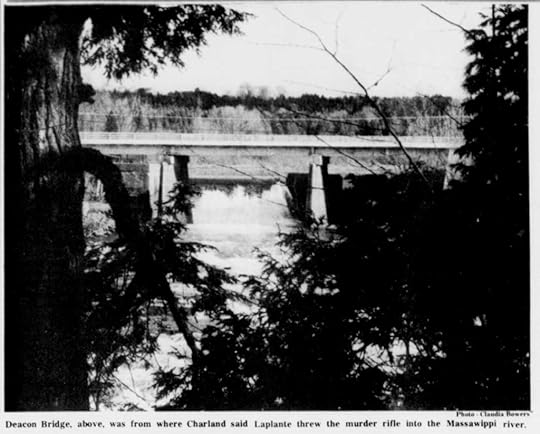
Les Deacons ont observé une voiture semblable à la Cadillac de Grimard circulant à quelques reprises entre le chemin Courval et le chemin Astbury. Ils ont ajouté qu’ils avaient également vu un homme portant des gants qui s’approchait à pied du pont Deacon et semblait parler à quelqu’un sous le pont. Ils n’ont rien remarqué d’être jeté dans la rivière. Que faisaient-ils sous ce pont ?
Lors de l’enquête du coroner qui avait eu lieu à l’automne 1978, le gendarme Michel Poulin rapporta qu’il avait photographié trois différentes traces de personnes sous ce pont le 7 juillet. Aucune d’elles ne correspondait aux souliers de Fernand Laplante qui ont finalement été confisqués pour le processus criminel. Cette information n’a jamais été retrouvée. Il est également à noter que Poulin a trouvé quatre empreintes digitales identifiables sur le corps de la Cadillac récupérée au Golf de Lennoxville. Les empreintes ne correspondaient pas à celles de Laplante. Cette information n’a pas non plus fait l’objet d’un procès.
Helen Achilles, qui vivait sur Astbury Road, n’a pas pu dormir cette nuit-là à cause de la chaleur. Elle a témoigné avoir vu une voiture bleue passer deux fois sur Astbury Road. Elle a noté que ce véhicule klaxonnait alors qu’il descendait la colline. Helen Achilles n’a entendu aucun coup de feu cette nuit-là.
Plus tard cet été-là, l’avocat Jean-Pierre Rancourt a demandé à un détective privé de mener une expérience. Alors que Robert Beullac était assis à l’intérieur avec Helen Achilles dans sa maison d’Astbury, il a demandé à son associé détective de tirer neuf coups d’un fusil semi-automatique .22 en bas de la colline à Astbury tandis qu’un autre associé klaxonnait une voiture. Beullac et mademoiselle Achilles entendirent aisément le klaxon et le fusil de chasse. A noter également que les détectives ont facilement récupéré leurs douilles.
Key witness Luc Landry
Luc LandryLe vendredi 27 avril 1979, l’avocat de la défense Jean-Pierre Rancourt convoque à la barre Luc Landry, 20 ans. Landry a révélé que dans une conversation au Moulin Rouge à l’été 1978, Jean Charland lui avait raconté comment « il avait criblé un gars derrière les poubelles de la rue Wellington », et que Raymond « le loup » Grimard était en fait un « larbin » travaillant pour la police. Au moment de son témoignage, Landry purgeait une peine de deux ans et demi pour vol et son admissibilité à la libération conditionnelle approchait à grands pas.
Landry avait d’abord été approché par les agents Bolduc et Châteauneuf de la SQ qui lui ont demandé s’il voulait témoigner contre Laplante, négociant qu’ils pourraient éventuellement le faire sortir plus tôt. Lorsque Landry leur a raconté son histoire, ils ont changé d’avis et ont dit à Landry de “rester en dehors de ça”, insinuant maintenant qu’ils pourraient faire mal tourner les choses pour sa libération conditionnelle. Landry raconte comment Bolduc et Châteauneuf ponctuent leurs propos « de coups de pied et de poing ». Nous pouvons maintenant voir qu’il ne s’agissait pas du comportement de quelques « brebis galeuses », mais d’une approche institutionnalisée utilisée par la police provinciale du Québec. Des coups ont été administrés non seulement à des acteurs de la pègre comme Landry, Laplante et Claire Dussault-Laplante, mais aussi à des civils ordinaires comme l‘hôtelier Paul Bergeron.
“Il avait un tatouage sur chacun de ses bras”
La station de taxi Pettigrew était située le long de la rue Queen à Lennoxville, en face de l’hôtel Georgian, et juste en bas de la rue du restaurant, Chez Charles / Disco Bob’s, l’endroit appartenant à Yvan Charland, le père de Jean Charland. Aux petites heures du matin du 6 juillet 1978, le propriétaire William Pettigrew effectuait le quart de nuit lorsqu’il a vu deux silhouettes marcher vers son taxi venant de la direction du terrain de golf de Lennoxville.
 Lennoxville Radio Taxi – William Pettigrew
Lennoxville Radio Taxi – William PettigrewUn passager était Jean Charland, et Pettigrew a grandi noté qu’il portait des gants. Le deuxième passager, Pettigrew, a été décrit comme “assez grand, avec des cheveux blond cendré assez longs et des favoris. Et il avait un tatouage sur chacun de ses bras.“
Pettigrew a fait deux arrêts. Le premier était chez Charland, ou plutôt chez ses parents, situé au 26 rue Champigny, dans un quartier de banlieue au nord de la rivière Saint-François, à moins de 2 kilomètres du campus du Collège Champlain. Après avoir déposé Charland, il a ensuite emmené le deuxième passager au coin des rues Belvedere et Short à Sherbrooke. Il est vrai que Fernand Laplante a vécu autrefois au Belvédère, à quelques pâtés de maisons au nord de la rue Short. Mais comme nous l’avons vu, d’autres vivaient également dans ce quartier, notamment Luc Grégoire et Carole Fecteau, et un club-house du gang des Atomes était situé à proximité sur Wellington. Et surtout, comme nous l’apprendrons plus tard, Régis Lachance habitait aussi le quartier, rue LaRocque à deux coins de rue de la rue Short (voir carte).
Ce que Laplante n’avait pas, ce sont des tatouages. Au tribunal, l’avocat de la défense Jean Pierre Rancourt a dramatiquement demandé à son client de se lever du box de l’accusé et d’enlever sa veste. Laplante l’a fait, révélant ses bras nus. Le tribunal est resté silencieux. C’est à ce moment que Rancourt sentit que son cas ne faisait plus de doute. Le jury a semblé ébranlé. La Couronne et les policiers ont été stupéfaits.
 Fernand Laplante ressemblant au Christ devant la croix.
Fernand Laplante ressemblant au Christ devant la croix.En contre-interrogatoire, William Pettigrew mentionne que l’agent Noël Bolduc de la Sûreté du Québec lui a montré une série de clichés électroniques. Pettigrew n’a pas identifié Laplante ou Charland qui étaient tous les deux dans le pont. Bolduc a suggéré que cela signifiait que Pettigrew ne savait pas exactement qui était dans son taxi le matin du 6 juillet, mais je crois que cela signifiait autre chose. Pettigrew était un témoin réticent. Il n’avait sans doute aucune envie de pointer du doigt un membre des Gitans et son complice. Parce que tout le monde dans cette salle d’audience savait exactement qui était grand, avec de longs cheveux blond cendré et des favoris, et un tatouage sur chacun de ses bras. L’avocat Jean Pierre Rancourt le savait. La Couronne, le juge, les officiers de la Sûreté du Québec, ils le savaient tous aussi. C’était Régis Lachance.
Penses-y. Qui a fait des contrats avec Jean Charland, qui a travaillé avec des partenaires ? Régis Lachance. Qui avait l’habitude de prendre des taxis sur les lieux d’un crime ? Régis Lachance. En 1978, Lachance avait de longs cheveux blonds. Il était “grand”. Sa famille dit qu’il avait des tatouages sur ses avant-bras, l’un était un diable.
Dans L’Affaire Giguere, à propos du meurtre non résolu de Rolland Giguere en 1969, j’ai écrit :
« Encore une fois, ce ne sont pas les fils d’Yvon Charland qui ont assassiné Rolland Giguère. Mais est-il possible qu’il y ait eu des associations de longue date avec des éléments criminels à Sherbrooke au sein de la famille Charland ? Le meurtre de Rolland Giguère était-il juste un crime d’opportunité, ou était-ce une action planifiée pour éliminer la concurrence ? Et la compétition pour quoi – du poulet frit ? La domination des restaurants ? Quelque chose de plus?”
Régis Lachance était exactement la personne que j’avais en tête dans cette affaire. Il est exactement le « suspect potentiel maintenant dans la fin soixantaine [qui] a été rencontré dans cette affaire » – celui que j’imaginais que la police de Sherbrooke avait interrogé lors de la réouverture de l’enquête Giguère en 2004. En effet, La Tribune rapporte que les enquêteurs ont rencontré deux suspects potentiels. Qui était l’autre gars ?
Appelez le témoin
Lundi 30 avril, Jean-Pierre Rancourt a appelé son dernier témoin à la barre. Régis Lachance n’a pas répondu à l’appel. Lachance était sous le coup d’une ordonnance de comparution. La police n’a pas pu le trouver. L’huissier Claude Bolduc rapporte qu’il a tenté à trois reprises de signifier une assignation à Régis Lachance, et qu’il a finalement dû remettre le document à son épouse. Régis Lachance était absent.
The post Le procès de Fernand Laplante first appeared on Who Killed Theresa?.



